

PINTS OF PURPOSE
Meet the publicans reviving the boozer



Meet the publicans reviving the boozer



































22 THE GOOD LIFE Alice B-B falls under a spell
24 THE RURBANIST Daniel Lismore
200 LAST WORD Anya Hindmarch on con dence
29 BON VOYAGE Bid adieu with Dior
32 THE STYLIST Ti anie Darke on where to nd a festive showstopper
34 THE EDIT Fashion, beauty and jewellery news
38 THE MAGPIE All that glitters
40 MY STYLE Pattern prodigy Sabina Savage
42 ALL WRAPPED UP Seasonal updates
45 LOUCHE DREAMS PJs are moving out of the bedroom, says Shane C. Kurup
51 SCENTS OF OCCASION Fantasy spritz
52 THE SCOOP C&TH ’s rst Balance Retreat
54 BODY & SOUL Camilla Hewitt gets her groove on
56 BODY LANGUAGE Olivia Falcon investigates how to look good and stay sane over Christmas
58 PERFECT 10 Beauty heroes
59 THE NUTRITIONIST Festive feasting
61 OUT IN THE COLD Prizes at the NPG
62 FESTIVE FLICKS Olivia Emily spotlights the season’s new lms and theatre
64 AND THAT’S A WRAP We look back on the rst Chelsea Arts Festival
66 THE EXHIBITIONIST Ed Vaizey considers a volte-face on much-maligned Marie Antoinette
67 WRITTEN IN STONE In the studio with artist Emily Young. By Olivia Cole
68 CONVERSATIONS AT SCARFES BAR
Charlotte Metcalfe meets the National’s Kate Varah
70 BIBLIOPHILE Belinda Bamber speaks to Olga Ravn about her new book, e Wax Child
72 LIBRARY OF DREAMS Friends of C&TH share their best reads of the year
74 LITTLE GREEN BOOK Lisa Grainger meets the woman safeguarding monuments – and the moon
76 THE CONSERVATIONIST It’s time to protect our birds – of every kind, says James Wallace
78 ONCE UPON A TIME
Poisoned apples and fairytale fashion
86 GEORGE’S HOUSE Jane Knight takes a rst look at the new Cotswolds hotel from a retail visionary
90 STEP INTO THE FUTURE Rob Hopkins has the tonic for climate pessimism: delicious imagination
94 THE POWER OF SMALL ACTS
Kindness goes a long way, says Mike Dickson
96 PINTS, POTATOES & PURPOSE Fleur
Britten meets the trio revitalising the British boozer
100 ARTIST IN RESIDENCE Parisian chic

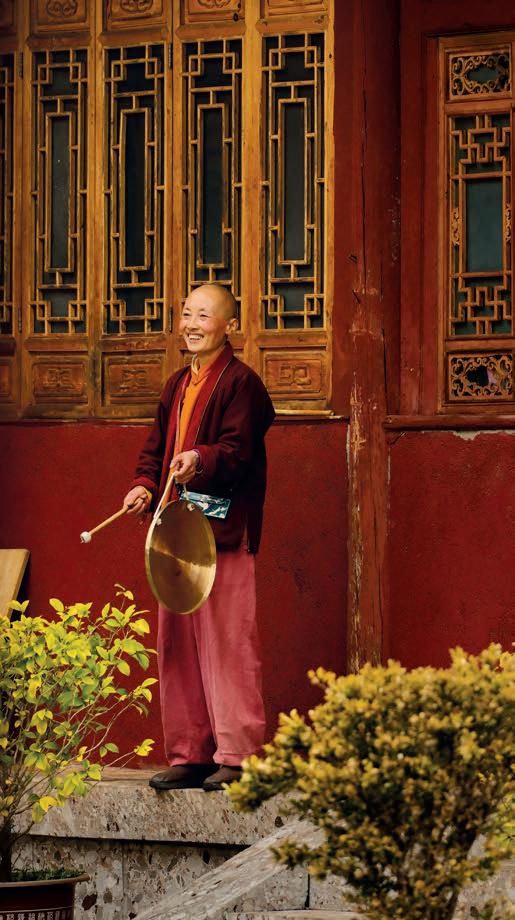

111 Are you more Wednesday or Stanley Tucci? Let our gift guide, themed around the television hits of the year, spark your imagination
137 SMALL WONDER Carole Annett steps into a carefully crafted home – of doll-sized proportions
140 DESIGN NOTES Editor’s picks for the home
142 LONDON CALLING Pearl Lowe digs into the faded glamour of her favourite city homes
144 BE OUR GUEST Tessa Dunthorne charts the new house rules for stylish guest bedrooms
146 TABLE RULES Stylists and designers on the delicate art of tablescaping
149 Felix Milns edits our annual ski special, packed with slopeside style, reviews, news, and more
165 BETWEEN MIST AND MOUNTAINS
Luke Abrahams explores rebellious Yunnan
172 CAMBODIA RISING Stephanie Drax nds a country rede ned by courage and creativity and Francisca Kellett visits Angkor Wat by vespa
176 ESCAPIST Travel news from Lauren Ho
178 AT WHAT COST? Should politics in uence your travel choices? asks Francisca Kellett
179 STARRY EYED Lean into the festive period at Sanderson London in Fitzrovia
180 ISLAND IN THE STREAM Lucinda Baring discovers the rst British hotel in Palm Beach
182 THE WILDIST Fee Drummond tours the Alps
184 SPIRIT OF THE ISLE Ardbeg House in the Hebrides o ers drams of charm
187 MAKI CHRISTMAS A shy tale
188 ALL THE TRIMMINGS Foodie treats
190 IN THE CHRISTMAS SPIRITS
Fill your drinks cabinet for the big day
192 THE BEAUMONT BLOOMS AGAIN
A hotel restaurant with serious buzz
195 HOUSE OF THE MONTH
196 O LITTLE TOWN Which British villages do Christmas best? Anna Tyzack nds out
14 EDITOR’S LETTER
17 CONTRIBUTOR S
48 PARTY PEOPLE



BJohn Sandoe’s Johnny de Falbe – to share the titles they’ve most loved this year. I want them all.
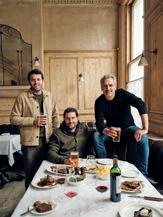
ooks of the year features or Christmas literary picks is content I’m always drawn to, eager to know who’s reading what and why. Despite the very frustrating slow down in the rate of tomes I read (this is my rst new year’s resolution: read more books), buying them is a magpie-like obsession. If you’re like me, turn to page 72 where we’ve asked friends of C&TH – from Hugo Rifkind and Ed Vaizey to Claire Shanahan from the Women’s Prize, artist and poet LionHeart and




As the great festive shopping splurge comes upon us – and we have our deliciously fun gift guide, which does include ideas for those who want to swerve the consumerist pile on p111 – we turn to Rob Hopkins, the steal-the-show speaker at this year’s Groundswell. Known as ‘the Glastonbury of farming’, this festival draws attention to regenerative and conservation agriculture and Rob left us all full of hope about the future we can still create. He shares his thoughts with us on paper as we turn towards a new year (p90). Plus, Mike Dickson reminds us why kindness is a superpower (p94). Will you be going down the pub now the nights are dark and the lights are twinkling? Despite the catastrophic decimation of our boozers nationwide, there are some hero tales. None more so than Public House, whose founders James Gummer, Phil Winser and Olivier van emsche, have made it their mission to keep pubs as community hubs of hospitality, with exceptional food to boot. ey’re even training the next generation with 12-week paid internships for local school leavers. Fleur Britten goes for a pint and some potatoes at one of their pubs, e Bull in Charlbury (p96). Not too far away – 40 minutes’ or so drive down the A44 – George Davies, the man behind George at Asda, Per Una and Next, has opened a new contemporary (on the inside) hotel in Broadway. Why, you may wonder, when it already boasts the fabulous Dormy House and e Lygon Arms just a stone’s throw away. Well, he says, it’s an extension of his home (not literally, but Davies’ local property portfolio could merit the village being rechristened Georgeway). Jane Knight checks in on page 86. Further a eld, we’re visiting Cambodia on the 50th anniversary since Pol Pot imposed his sadistic regime – and nding a country full of resilience (p172). Yunnan province in China, meanwhile, shows ‘a world of dizzying oxymorons’ to Luke Abrahams (p165). Finally, have you ever carved tracks down a Turkish volcano? Our annual ski special begins on page 149. Have the most wonderful Christmas.




BURN IT
You have to choose your scented candle wisely (so many are toxic). Matiere Premiere’s are incredible



















What’s on your Christmas wish list? The sell-out Liberty advent calendar. I was too late last year so I made my husband buy it in August. That’s a long wait. Seasonal cultural highlight?
The Christmas lights at Kew – a dazzlefest – and A Christmas Carol at the Old Vic. Apparently it snows, so sit in the front row. Country or town house Christmas? London is so Dickensian at Christmas, particularly at night – the streetlamps, solitude and wishful whispers of snow. For once, time slows down (and I’m not late). How do you find balance during the festive season? Avoiding festive flu is a Christmas miracle. Luckily, I own a supplement brand called Leapfrog Remedies that sorts the sniffles, stress and patchy sleep. It’s my ‘thrival’ kit. This winter I’m determined to... Stay warm, thanks to my new Delta Roam coat.

What’s on your Christmas wish list? Biomimicry in Architecture by Michael Pawlyn. The new Big Thief album. A book about the painter de Vlaminck. Socks. How do you find balance during the festive season? I love those few days between Christmas and New Year when you forget what day it is. When the laptop stays in a drawer, and it’s long, lazy days of not doing much. I look forward to it all year. Best or worst Christmas guest? Real or imagined... Best would be my dad. He died 12 years ago, but it would be lovely to have him back at the table. The worst would be Donald Trump. He’s probably rubbish at Scrabble – and washing up.
This winter I’m determined to... Get out for walks, draw, savour every moment with my kids, resolve to make 2026 the year when the big shifts we need to see in the world actually start to gain some momentum.
What’s on your Christmas wish list? Artisanal earl grey tea, hardback A5 notebooks and a replacement vintage umbrella to the one I left on a train this year.
Seasonal cultural highlight?
Sawing down our own tree from a local farm and letting the kids decorate it with their creations: garish pompoms, DIY Lego baubles, homemade biscuits, bits and bobs from nature they’ve spray painted gold. Country or town house Christmas? Country. The robins, the holly, ivy, epic fir trees, deer. It’s all here. Best or worst Christmas guest? Real or imagined... Someone high up at Fortnum & Mason who could bring armfuls of florentines would be fabulous. How do you find balance during the festive season?
I’m sorry to admit I’m all take and no give. I only accept invites and don’t do any stressful hosting.
Country or town house Christmas? I am a city boy. I volunteer on Christmas Day but if I don’t find a volunteer space, I’ll go and talk to people who are alone on the streets. Best or worst Christmas guest? Real or imagined... My mother. She had a terrible time with breast cancer recently so I am looking forward to spending the season with her. I will drink the wine on her behalf. How do you find balance during the festive season? I travel for work, so by Christmas I just want to vanish. But I never miss the Claridge’s Christmas tree party.
This winter I’m determined to... Read. I am a literature grad and I think reading heavy critical analysis and French philosophy for years put me off anything over 30 pages. It’s my aim to ditch TikTok and dive into some Penguin classics, or whatever anyone recommends.




DEPUTY EDITOR LUCINDA BARING
EDITOR-AT-LARGE ALICE B-B
ASSOCIATE EDITOR CHARLOTTE METCALF
MANAGING EDITOR TESSA DUNTHORNE
SUB EDITORS KATIE BAMBER, ANDREW BRASSLEAY
JUNIOR SUB EDITOR & PRODUCTION ASSISTANT EVIE CALVER
FASHION DIRECTOR NICOLE SMALLWOOD
BEAUTY DIRECTOR NATHALIE ELENI
INTERIORS DIRECTOR CAROLE ANNETT
CULTURE EDITOR ED VAIZEY
WELLNESS EDITOR CAMILLA HEWITT
EXECUTIVE RETAIL EDITOR JULIET HERD
MEN’S STYLE EDITOR SHANE C. KURUP
TRAVEL EDITOR-AT-LARGE FRANCISCA KELLETT
SUSTAINABILITY EDITOR LISA GRAINGER
PROPERTY EDITOR ANNA TYZACK
MOTORING EDITOR JEREMY TAYLOR
ONLINE CONTENT DIRECTOR REBECCA COX
DEPUTY ONLINE EDITOR ELLIE SMITH
ONLINE CULTURE EDITOR OLIVIA EMILY
ONLINE STYLE EDITOR CHARLIE COLVILLE
ONLINE WRITER ISABEL DEMPSEY
SOCIAL MEDIA MANAGER MCKENZIE MULLANY
CREATIVE & PRODUCTION DIRECTOR PARM BHAMRA DESIGN & PRODUCTION MIA BIAGIONI
THE EDITOR editorial@countryandtownhouse.co.uk
ADVERTISING advertising@countryandtownhouse.co.uk
ASSOCIATE PUBLISHER ELLIE RIX
HEAD OF FASHION EMMA MARSH
HEAD OF BEAUTY BANDI MANZINI
SENIOR ACCOUNT DIRECTOR PANDORA LEWIS
ACCOUNT DIRECTOR SERENA KNIGHT
ACCOUNT MANAGER COSIMA WOODARD
DIGITAL BUSINESS DEVELOPMENT DIRECTOR JOEY GOLDSMITH
B CORP & PROJECTS MANAGER XA RODGER
MANAGING DIRECTOR, C&TH EVENTS LOUISE CLOSE
SENIOR EVENTS MANAGER, C&TH EVENTS JOSIE WILLIAMSON
MARKETING & PRODUCTION EXECUTIVE, C&TH EVENTS DOMINIC CHRISTIE
TECHNICAL DIRECTOR MARK PEARSON
CHIEF FINANCIAL OFFICER GARETH MORRIS
FINANCE CONTROLLER LAUREN DELGADO
FINANCE ADMINISTRATOR RIA HARRISON
ACTING FINANCE ADMINISTRATOR KLODI SADE
HUMAN RESOURCES CONSULTANT ZOE JONES
CHIEF COMMERCIAL OFFICER TIA GRAHAM
CHIEF OPERATING OFFICER JAMES THROWER
MANAGING DIRECTOR JEREMY ISAAC
CONTRIBUTING EDITORS
BELINDA BAMBER, STEPHEN BAYLEY, OLIVIA COLE, TIFFANIE DARKE, FIONA DUNCAN, OLIVIA FALCON, DAISY FINER, AVRIL GROOM, LAUREN HO, JULIET KINSMAN, EMMA LOVE, MICHAEL HAYMAN, MARY LUSSIANA, CAROLINE PHILLIPS, JAMES WALLACE
ACCOUNTS accounts@countryandtownhouse.co.uk
SUBSCRIPTIONS subscribe@countryandtownhouse.co.uk
COUNTRY & TOWN HOUSE is a bi-monthly magazine distributed to AB homes in Barnes, Battersea, Bayswater, Belgravia, Brook Green, Chelsea, Chiswick, Clapham, Coombe, Fulham, Hampstead, Holland Park, Kensington, Knightsbridge, Marylebone, Mayfair, Notting Hill, Pimlico, South Kensington, Wandsworth and Wimbledon, as well as being available from leading country and London estate agents. It is also on sale at selected WHSmith, Waitrose, Marks & Spencer and Sainsbury’s stores and independent newsagents nationwide. It has an estimated readership of 150,000. It is available on subscription in the UK for £39 per annum. To subscribe online, iPad, iPhone and Android all for only £9.99/month, visit: exacteditions.com/ read/countrytownhouse. For subscription enquiries, please call 020 7384 9011 or email subscribe@countryandtownhouse. co.uk. It is published by Country & Town House Ltd, Studio 2, Chelsea Gate Studios, 115 Harwood Road, London SW6 4QL (tel: 020 7384 9011). Registered number 576850 England and Wales. Printed in the UK by William Gibbons and Sons Ltd, West Midlands. Paper supplied by Gerald Judd. Distribution by Letterbox. Copyright © 2025 Country & Town House Ltd. All rights reserved. Reproduction in whole or in part without written permission is strictly prohibited. Materials are accepted on the understanding that no liability is incurred for safe custody. The publisher cannot be responsible for unsolicited material. All prices are correct at the time of going to press but are subject to change. While every care is taken to ensure information is correct at time of going to press, it is subject to change, and C&TH Ltd. takes no responsibility for omissions or errors
you’ve



reading it
Ideally, we’d love you to pass it on to a friend or a community place which might enjoy it (doctor or dentist surgery, community centre etc), but you can also rest assured that your issue (including cover) can be disposed of in your paper waste recycling bin.

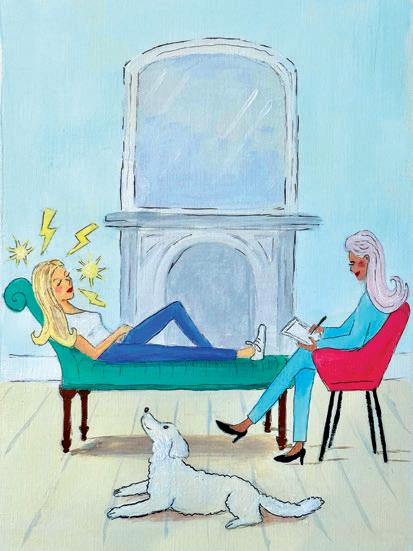


TWINNING with my goldendoodle in this glorious coat (thewhitecompany.com) STIMULATING my vagus nerve with Nurosym (nurosym.com) QUENCHING my skin with Reome’s Biogenic Melting Cream for deep facial hydration (reome.com)

HYPNOTHERAPY h as always slightly terri ed me. Probably from watching TV shows as a child, where willing participants lost all control for our giggles; like zombies they’d answer a banana as if it was a phone or accept that a sack of potatoes was their boyfriend. e potential of handing your brain’s hard drive over and it falling into the wrong hands… well, it’s like the opening scene of a horror movie. But I also love challenging myself, so when I was introduced to renowned clinical hypnotherapist Malminder Gill by a trusted doctor friend, I couldn’t resist.
Gill appears at the door of her Fitzrovia practice like a movie star – long silvery pink hair, slinky aqua blue suit and a throaty laugh. I am instantly beguiled. Our rst session is an honest conversation about areas I’d like to improve or things I’d like to ditch. Gill works mostly with actors, writers and directors in the lm industry, dealing with issues from sleep to relationships, imposter syndrome to really feeling characters and their stories. is is all right up my street. So I tell her about the new draft of a screenplay I’m working on, and that nothing makes me happier than imagining and dreaming and writing creatively. But, I tell her, I never prioritise this creative work – it’s always at the bottom of my to-do list, if it makes it onto the list at all.
A COUPLE OF WEEKS LATER I HEAD BACK.
And this time – it’s on! Instead of sitting on the comfy sofa, I lie down, slip on some eye patches and Gill starts talking in a deliciously low voice that’s like caramel being poured in my ears. She reads from the script she’s written speci cally for me from our previous conversation. I can hear her words, but it’s like I’m under lots of layers of… u . Everything feels heavy, but not su ocating. I’ve gone deep, but I’m still aware. Like that moment when you straddle being awake and asleep. I hear Gill talk about courage in my ideas and con dence in myself as a writer; she talks about procrastination and distraction and ways to overcome this. After 40 glorious minutes of wandering the unexplored world of my subconscious, I come to… grinning and blinking into the light. No clutching a banana or snuggling up to a bag of spuds. Instead I feel deliriously happy and ready for action as we talk about the phrases I remember that were clearly hitting home.
AND


two months later and the script is nearly nished. However, in the last two weeks distraction has bounded back like a naughty puppy and procrastination is creeping in like poison ivy – both unwanted guests on my creative mission. Maybe my subconscious is responsible for the self-sabotage so I can have another session on Malminder Gill’s sofa – and some more of that drifty, liquid caramel foraging around in my mind. malmindergill.com n



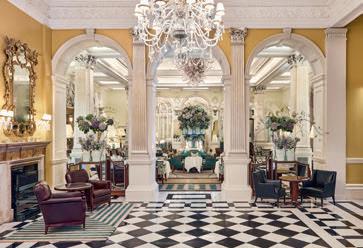
SCENT My homemade perfume, with notes of death and white florals. BOX SET The Star Trek films. CHOCOLATE Maltesers. SONG My Love Is Your Love by Whitney Houston. DISH Porridge with honey or berries. GADGET My phone. It never leaves my hand. RESTAURANT Claridge’s. HOLIDAY Cairo. It’s full of wonder.
What’s bringing you joy at the moment? My friends who are ghting for LGBTQ+ people and their rights. ey’re hardcore activists doing good work and it’s bringing me real hope. Working with them is amazing; we’re actually making things happen.
What’s annoying you most right now? Queer people’s existence being questioned by people like JK Rowling and the government. It’s causing people to hide rather than go out and live their true lives. ere’s so much hatred around.
Advice you’d give to your 15-year-old self? You’ll get there, but whatever that means, don’t stop being you. And just because someone is right about one thing, it doesn’t mean they’re right about everything.
What could you have been arrested for? Any of the protests I’ve been on. When I worked with Vivienne Westwood on her Climate Revolution campaign, we wished the police would just arrest us. Vivienne knew they would never come for her but really wanted them to.
A moment that changed everything? When I suddenly lost everything and became homeless. One week I was living in Knightsbridge with a fashion label working with celebrities like Mariah Carey and Nicki Minaj, and the next I was thinking about ending my life. I called my mum and said: ‘You’re not going to hear from me.’ at’s when I came up with the idea of my exhibition, Be Yourself; Everyone Else Is Already Taken, which opened at SCAD FASH a month later and has now travelled around the world. It changed my life forever and saved me in so many ways.
Where do you go to escape? Iceland. Everyone just minds their own business, which is rare when you dress as elaborately as I do. It’s so peaceful.
You wouldn’t know it but… I’m a total astronomy nerd. I’ve spent my whole life looking at the stars, and in lockdown, I started to learn the constellations and locations of all the planets in the night sky.
What does sustainability mean to you? As a climate activist, I use my platform to put information out there and do my best to make change. I’ve helped save thousands of acres of rainforest and helped stop fracking in the UK, but I’m also really picky with what I buy and how much I travel. And I do my best to educate my friends who use private jets. How do you live a life in balance? I believe in centring your mental health, which painting has helped me with massively. And even though I’m notorious for being at nearly every single event on the planet, I don’t party hard. I just try to get to know everyone in the room.

Your greatest triumph? Whenever I’ve been able to use my ridiculous privilege to help others through activism.
Your greatest failure? Wearing heels. It’s a struggle to go a whole night without breaking them or breaking my neck. n
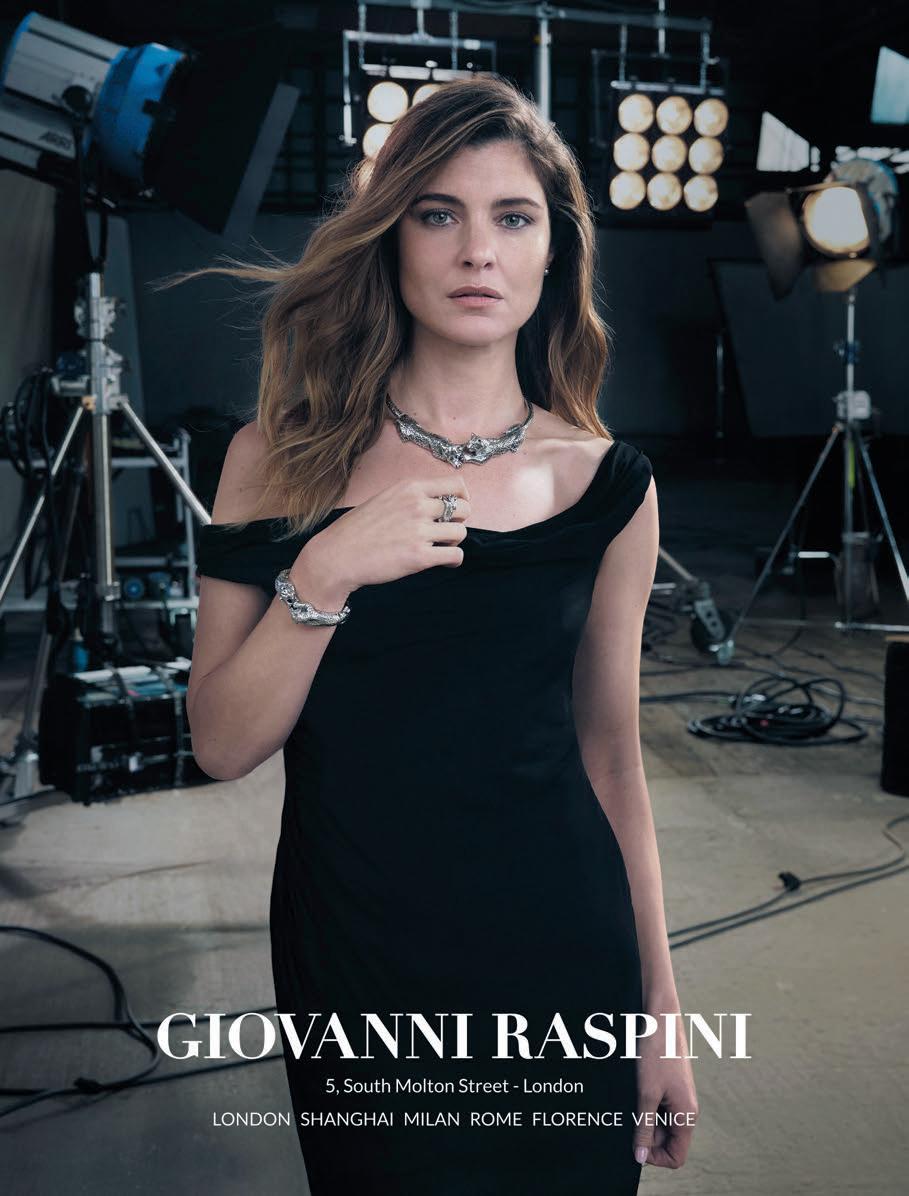







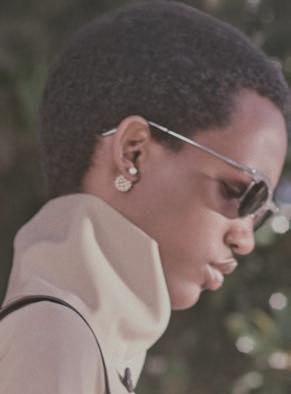

Dior distils effortless French chic; pair the high necked trench cape with a roomy Voyage bag for Parisian poise at its most powerful. dior.com
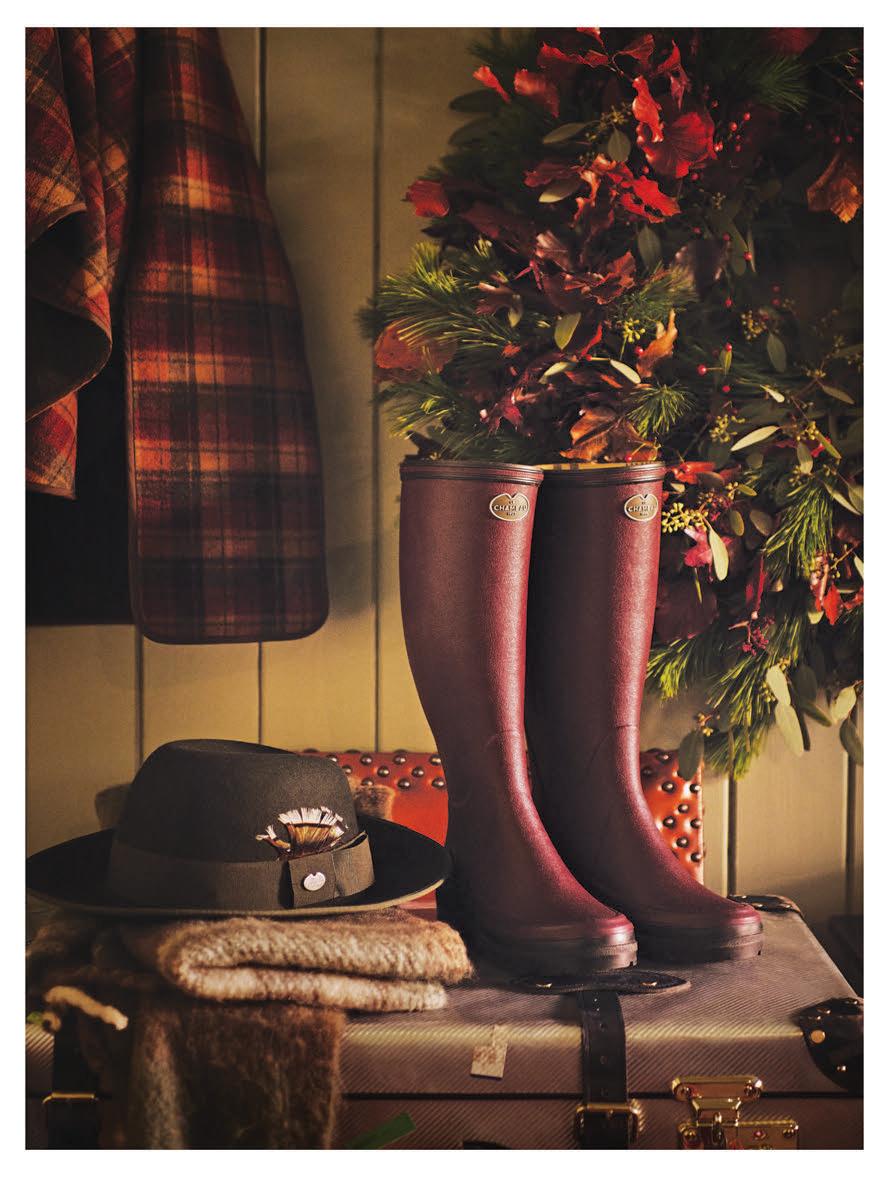

Christmas calls for a few carefully selected showstoppers, says Tiffanie Darke




When structuring your wardrobe, it’s helpful to think of the 80/20 rule: 80 percent of your wardrobe should be work-hard staples, 20 percent should turn all the heads in the room. e 20 percent is a lot more fun to shop for, but not always easy to nd.
If you are compiling a wish list for Christmas, I suggest you make it fashion fabulous. Ask for a piece that will make your heart sing every time you touch it, trigger gasps from those who see it, and connects with that memory dopamine neuron that makes you fall in love with it even more over time.
is being 2025 though, we’re not shopping any old thing. We’re shopping for meticulously researched, trusted, well-made pieces. I’ve long wanted to recommend Strathberry in this column: a Scottish handbag brand that has been quietly growing its luxury stature. Designed in Edinburgh then handmade in Spain’s nest leather ateliers, its Crescent Moon in colour ‘oxblood’ works for day and night and will put you ahead of the curve.


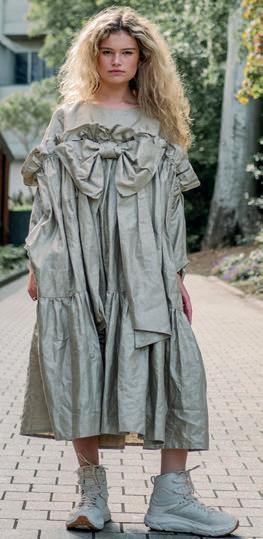
Next up is Sonia Petro , the 80s Italian brand now revived losing none of Sonia’s lust for life. Each piece is handmade in artisanal factories in northern Italy, and if it’s not a belt (the Aries instantly raises an out t’s game), then any of the jewellery will start a conversation.
E.L.V. Denim, a rm favourite of mine, has so much to say: its upcycled denim, leather and suede is made into superbly on-point pieces by seamstresses in its London workshop. e denim cape is a real talking point, as is the patchwork leather jacket with Phoebe Philo blouson vibes.
Feeling the bohemian country girl artist studio energy? en check out Kindred of Ireland. Its revival of Irish linen led to the rescue of the nal workshop dedicated to the ancient art of beetling, a process that involves pounding linen with wooden blocks for hours. e metallic-like sheen this results in produces a spectacular fabric – see how the design studio have interpreted it on its beetled linen dress. Showstopper. More subtle but no less fun is the donegal tweed coat, which has a beetled linen lining.
Of course, true luxury is embroidered silk vintage underwear. Special occasion only, because they don’t make it like they used to. Find it on Etsy – go on, head down that rabbit hole. While online, check out the 1stDibs marketplace for vintage chandelier earrings; from Oscar de la Renta to Schiaparelli, it always has incredible pieces. Add a rollneck and you are utterly fabulous. n

e joyful new Nobody’s Child x Lisou collection celebrates the two brands’ shared love of bold colours, clashing tones and storytelling prints. Inspired by 1960s and 70s British pop culture, the pieces come with their own digital product passport (DPP), documenting the supply chain. Alex blazer, £249; Vicky trousers, £179. nobodyschild.com
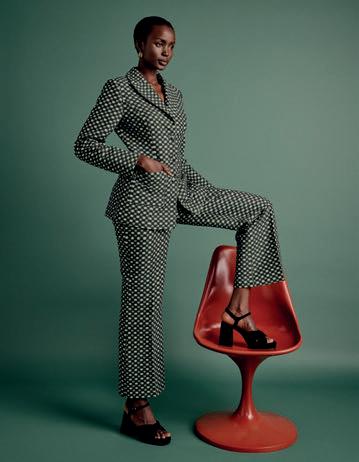

is new bracelet watch rocks couture spirit with a twisted braid borrowed from the signature Chanel wardrobe. Première Galon watch in 18ct yellow gold with diamonds and black-lacquered dial, £24,100. chanel.com
Whether you’re dressing up or hunkering down, these are the style picks of the season, says Juliet Herd
By Terry’s new regenerating, ruby-infused lipstick comes in a re llable gold case inspired by Terry de Gunzburg’s mother’s art deco jewellery collection.
Rouge
Opulent lipstick in red couture, £49. byterry.com


With a motif inspired by supermodel Lily Aldridge’s watercolour paintings, this cute combo is stylish enough to wear out and about. Coat advisable.
Eberjey x Lily Aldridge silk printed lace cami and short set, £245. eberjey.com

Make an entrance – like model Arizona Muse – in this regal black and gold l coupé jacquard gown, featuring a fully corseted body with mesh boning. Pair with some killer heels. Amelia jacquard gown, £995. thefoldlondon.com


ink rich velvets, shimmering silvers and intricate embellishments for the festive season. Crafted from FSC-certi ed material, this silver lamé maxi dress is a masterclass in modern glamour. Yahvi oyster long dress, £995. beulahlondon.com
Globe-trotting Aussie designer Camilla Franks channels the bustling bazaars and ancient cities of Turkey in her latest collection, e Wandering Poet. Inspired by Topkapi Palace, this oversized biker jacket featuring handcrafted weaving and riveting is a wearable work of art. East of Istanbul leather jacket, £3,231. uk.camilla.com
Each of the six unisex fragrances in the Savile Row Private collection bears a name inspired by the iconic London street and craft of tailoring. £215. savilerowprivatecollection.co.uk





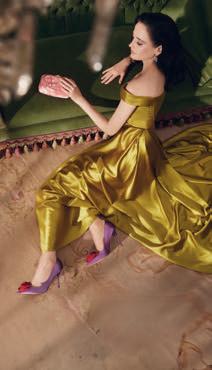





Featuring 24 fancy-coloured diamonds, this exquisite bracelet bears testament to Pragnell’s commitment to rare jewels and craftsmanship. It packs a punch too, at 42.58ct. Masterpiece diamond bracelet, £POA. pragnell.co.uk

Like oysters, these mirror-like gold discs curve protectively around their precious treasure, adding a playful, modern twist to these pretty pieces. Disc Pearl pendant (£9,080), ring (£12,400) and earrings (£11,600) featuring South Sea pearls and diamonds with Sakura Gold. tasaki.co.uk

Part of Buccellati’s new Étoilée Color collection, this bold Eternelle ring gives festive vibes, studded with rubies, spessartines and yellow and pink sapphires. Étoilée Color Collection Eternelle ring in yellow and white gold, £6,800. buccellati.com


Each bespoke eo Fennell mini kennel pendant opens to reveal a hand-painted enamel portrait of your pooch. Pendant in 18ct yellow gold and diamond, £9,750 (with portrait, £10,750). theofennell.com
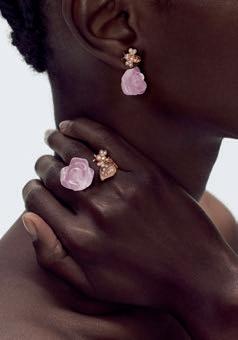
Jewellery design has never been more unique or enchanting, says Juliet Herd 1 ANNOUSHKA Sterling silver Knuckle Tri ring, £595. annoushka.com
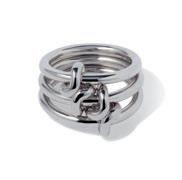




2
Look closely and you’ll see delicate beaded bees with heart-shaped, diamond-pavéd wings buzzing around sculpted rose quartz petals – an homage to the gardens that so inspired French couturier Christian Dior. Rose Dior Pré Catelan earrings (£15,500) and open ring (£11,100) in pink gold, pink quartz and diamonds. dior.com

Sabina Savage shares her winter wardrobe heroes



Sabina Savage launched her brand of exquisitely hand-illustrated scarves and clothing in 2014 after studying couture in Paris
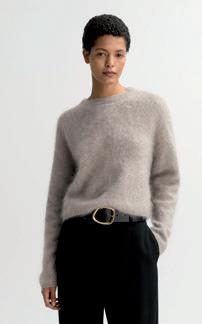
SOFT GOAT
Brushed cashmere crewneck, £385. softgoat.com
ALIGHIERI Ancient
Incantations ring, £280. alighieri.com

SLEEPER
Mille-feuille silk flats, $290. refinery29.com
UMA WANG Gink skirt, £711. rosensstockholm.com



SABINA SAVAGE Scrimshaw Skeleton silk velvet dress, £925. sabinasavage.com
Daily uniform? I walk my dog Little Gin through Hackney marshes every morning to reach my studio. is means at shoes, like my trusty Church’s Binder Brogue boots bought for a steal secondhand, or my now more-than-tatty Miu Miu loafers. at’s about as practical as I get; I don’t own jeans or trainers. I often lean on block colours for a long studio day, but love to play with interesting layers, textures and accessories, like a heavy shoe with a delicate ankle sock and miniskirt, a u y mohair paired with a ne silk, or heavy quilting over a light layer such as a Simone Rocha sheer skirt. Our 42cm silk twill scarves are my daily go-to year round – a hint of printed silk at the neck can liven up any out t. Style crush? I’m drawn to people with an unexpected style; an element of surprise in an out t. I am lucky to travel for work, and I often gather ideas while people watching. Street style in Tokyo is particularly fascinating, and New Yorkers have a brilliantly varied aesthetic. Go-to pieces? Winter is a wonderful time for clothes; it o ers so many opportunities for styling and layering without the risk of overheating. I am a glutton for good knitwear, like a chunky jumper from Soft Goat knotted around the neck and paired with a silk headscarf. I love a simple structured or slouchy coat in a heavy wool or cashmere –almost always vintage (my favourite is a long, grey men’s wool dressing gown with a rope trim and tasselled tie at the waist), but Uma Wang’s Callie Coat in black mustard wool and mohair is also divine. Country style aesthetic? I grew up in rural Somerset, so my childhood and teenage years consisted almost exclusively of jodhpurs, riding boots and waxed jackets. I still visit whenever I can, and lean on the trusty navy Barbour I’ve had since I was 12. e traditional country aesthetic doesn’t quite t my style, so I mix in a stful of statement rings or a delicate tulle rollneck peeking from beneath a heavy Aran knit.
Night on the tiles? is is an excuse to wear my more extravagant footwear – still at, but usually embellished or wildly impractical, like my raw silk ats by Sleeper or trusty Alberta Ferretti mules. en I’ll often tie a silk scarf as a top or a dress, experiment with fabrics like our new silk velvet dresses, and always add statement jewellery. Under-the-radar labels? Having run my brand for 11 years, I have encountered many wonderful designers whose work I may not otherwise have discovered. ere are several jewellery designers whom I consider to be some of the best in their eld. To name a few: Ariana BoussardReifel, Alighieri, Tessa Metcalfe, Castro Smith. Timeless or trend-led pieces? I don’t consciously consider either; I choose with my heart, not my head. e majority of what I buy is second hand, from eBay and Vinted, designer resale sites such as Vestiaire Collective, ea markets (Shepton Flea is a favourite, along with Chelsea Flea in New York), and vintage and thrift stores when I’m travelling. Style cheats or hacks? I am biased, but I truly believe a silk scarf is the ultimate hack, especially when travelling. Lightweight, beautiful and versatile, they can transform the most mundane look or can become the look itself. ey keep you warm or the sun o your shoulders. e print you choose can hold a personal meaning, and if you choose wisely, just one scarf can o er a universe of options. n
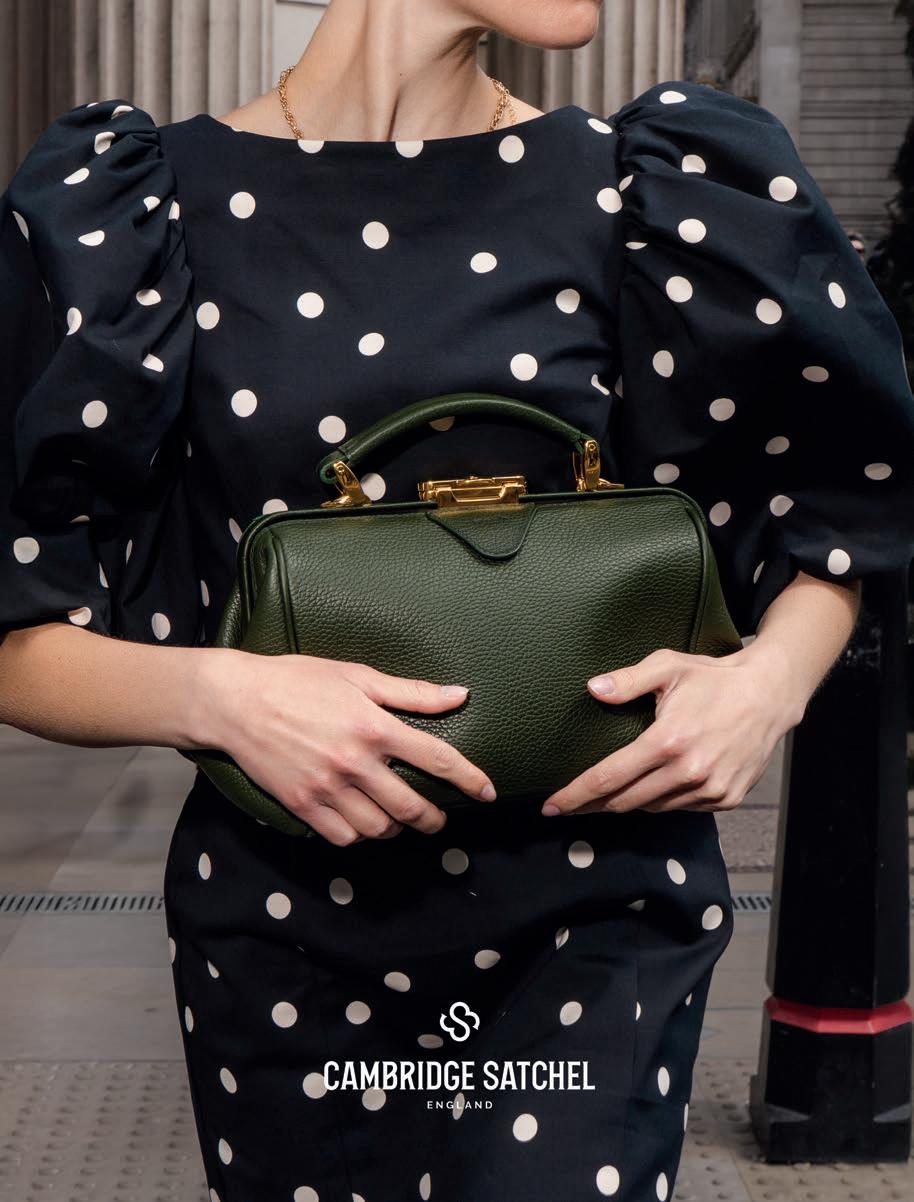
As cooler climes edge in and party season looms, Shane C. Kurup takes stock of the best winter clobber
Clean-cut classicism and materials of note are the formula for Vince’s laid-back Californian mode. e label’s latest collection, e Landscape Within, takes cues from windswept coastal vistas, with buttery soft leathers, cashmeres and texture-rich yarns in earthy, sandy hues. Just the sort of thing you want for a brisk walk in town or country. vince.com


Despite its Nordic origins, NN.07 – an acronym for ‘no nationality’ and the brand’s foundation year –takes a global stance at the design table. e devil is in the detail of its AW25 Paris-inspired collection, which is enriched with plush materials and artisanal Gallic treatments, including baby alpaca mélange knitwear, Moire-printed corduroy and textural l coupé. C’est parfait. nn07.com

In our brave new world of men’s style, the aisles (physical and virtual) are chock-full. Luckily, the buying team at Mr Porter has done the legwork and AW25’s selection includes cosy Stò a knits, crisp Lemaire tailoring and statement Tom Ford coats. Curating a wardrobe of style and substance has never been easier. mrporter.com
Woody, smoky colognes for winter




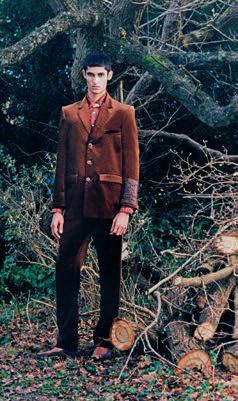
British-Indian-Nigerian designer Priya Ahluwalia weaves a rich cross-cultural tapestry through her work, painting a bigger picture about the clothes we wear. Her latest line, Sanctuary, draws on inherited heirlooms, handspun techniques and traditional art and pottery. Expect intarsia woollens knitted with patterns inspired by ancient cave paintings, tapestry-like silk jacquards, textural velvet suiting and a fresh take on Ahluwalia’s grandfather’s 1970s Kholi coat. is is coldweather dressing at its most expressive. ahluwalia.world

e UAE might not be the rst place that comes to mind for winter dressing, but Emirati-founded brand Qasimi looks beyond shifting desert sands for inspiration. For AW25, creative director Hoor Al Qasimi worked with Māori artist Emily Karaka to emphasise inherited history and multicultural connections that counter the current feeling of world division. Capacious windbreakers and trousers nod to traditional Middle Eastern silhouettes, while sculptural jacquard knits are the perfect antidote to frosty weather. qasimi.com

’Tis the season to get dressed in your best








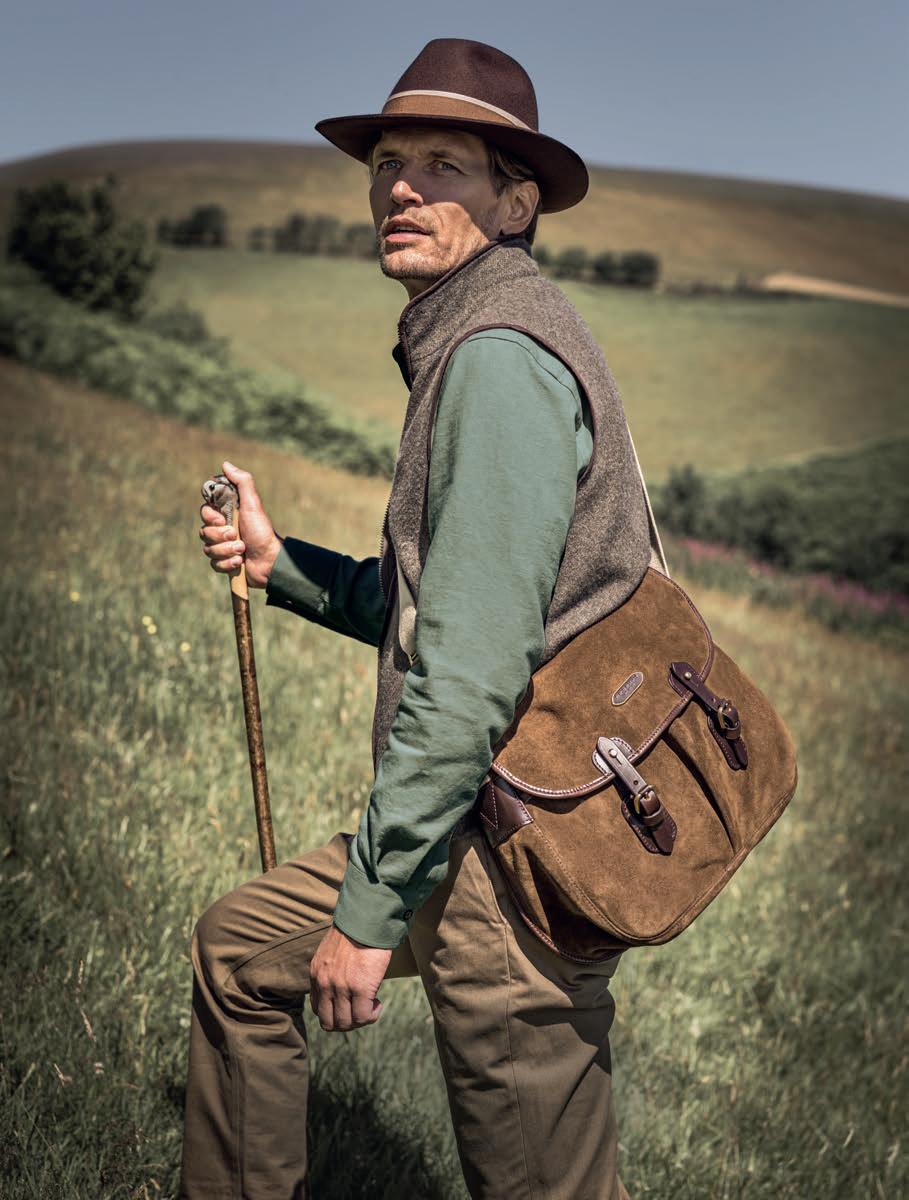
Could the current PJs revival dare you to wear your jammies beyond the bedroom, asks Shane C. Kurup
‘Sweet dreams are made of this,’ purred Annie Lennox – and if the bene ts that come with the new wave of pyjamas is to be believed, there’s more substance to these song lyrics than ever.
Lingerie, briefs, negligee, boxers. ese garments usually only seen in plain sight in the bedroom suggest a certain unfettered naughtiness. Pyjamas? Not so much. But given that Gen Z kids are dressing like their grandads in u y cardis and wide-leg slacks, it might not be a surprise to learn that PJs are having a renaissance both beneath – and beyond – the bedclothes.
Sacha Rose, CEO of luxury loungewear label Derek Rose, believes the current sleepwear revival is tied to shifting social norms. ‘It’s less about nostalgia and more about valuing rest and recovery as part of a modern lifestyle,’ says Rose. ‘In recent years, we’ve seen a broader cultural shift towards self-care and investing in our downtime. Men are no longer shy about wanting comfort and relaxation, and nightwear ts into that beautifully.’
e link between nightwear and wellness has given rise to brands like Hanro, Homebody and David Gandy Wellwear, which use organic bres and aloe vera treatments in their clothing to soothe as you sleep. But there are more basic bene ts that come with wearing decent clobber to bed – starting with debunking the idea that sleeping starkers helps if you run hot. ‘It’s a myth,’ explains Andreas Palm, co-founder of Stockholmbased brand CDLP. ‘Studies from the National Sleep Foundation show that sleep quality is more in uenced by body temperature regulation and fabric breathability than being unclothed. Breathable natural bres like lyocell or cotton-poplin help wick away moisture, reduce temperature fluctuations and protect the skin from allergens and friction.’ Palm adds: ‘Psychologically, nightwear can also act as a kind of “o switch”, a signal to the body that it’s time to wind down.’
Tom Pyne, founder of Chelsea Peers (which just launched a natty men’s loungewear collection called Playfulism) recently conducted a To Bare or Wear?
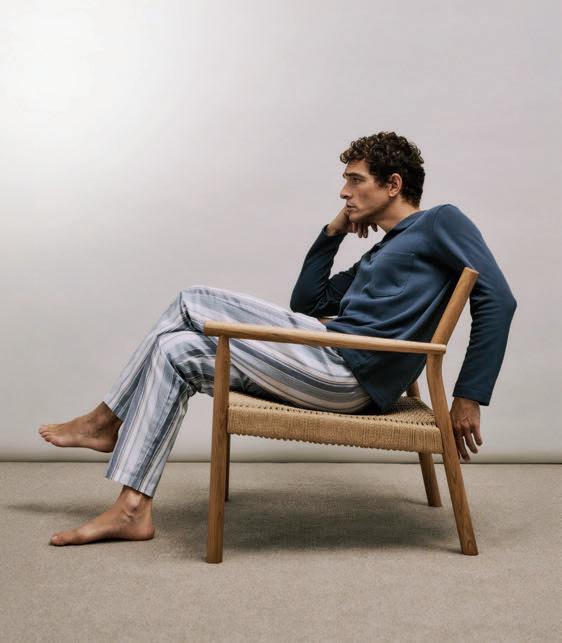
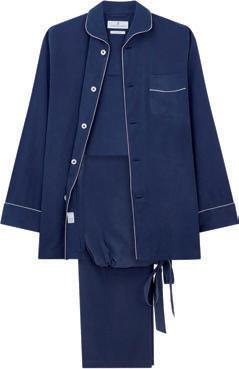


survey, revealing 74 percent of UK men prefer wearing something in bed. ‘It con rmed most men feel more comfortable dressed for rest; interestingly, 45 percent of men surveyed who wear pyjamas said they help them relax and unwind at the end of the day,’ says Pyne, who rates organic cotton and Tencel™ modal for supporting temperature regulation and maintaining deep sleep.
Derek Rose, which makes silk pyjamas (particularly kind to sensitive skin), has perfected the engineering of its PJs over the past century. Sacha Rose’s grandfather, Derek Rose, introduced vertical buttonholes that provide more give to fabric when you toss and turn, while elasticated waists and French seams prevent cha ng. ‘Given most people spend about a third of their lives in bed, what you wear is incredibly important,’ says Sacha Rose. When looking for good pyjamas for restful sleep, he advises to start with the fabric. ‘It should be soft against the skin, breathable, and durable enough to last. en consider design elements: are the seams comfortable, does the waistband move with you, is the cut generous enough to allow freedom without being sloppy?’
Pyjamas have also come out from under the duvet in recent years, with men in the public eye opting to don sleepwear in full view. Fashionistas might credit tongue-in-cheek designer Marc Jacobs for spearheading the ‘nightwear as daywear’ trend after he famously wore oral printed jammies to take the bow on the runway at his AW23 Louis Vuitton show. at sort of stunt would naturally pass muster in the eclectic upper echelons of high fashion, but men outside this circle have been taking the look in their stride, too. Back in 2020, Patrick Schwarzenegger went for a Christmas day walk with his mother in their Californian neighbourhood wearing a striped co-ord pyjama set and sneakers. It was gold for the Daily Mail, but traditionalists probably thought he’d escaped from a young o enders institute.
Can mere mortals pull o the look without appearing like they’re sleep walking? And what’s the point, beyond getting a few more wears out of clothing that would otherwise be relegated to dead hours? Palm has built CDLP on this idea, designing his pyjamas from contemporary fabrics like silk-poplin, with mother of pearl buttons and functional pockets, making them dressy enough to wear beyond the bedroom. ‘ e goal is to feel as elegant in bed – or out on a hotel balcony – as you do stepping into a dinner party,’ says Palm. ‘We see a lot of men wearing the pyjama shirt open over a tank or tee, while the pyjama trouser works well with a heavier knit or a structured overshirt. It’s all about contrast – balancing the softness of nightwear with more architectural pieces.’ It also explains the rising popularity of elegant, comfort- rst nightwear from British tailoring brands, like Turnbull & Asser and om Sweeney.
Rose, too, has seen his pieces out in the wild and suitably styled up. ‘A while ago, I was in a Swiss mountain town and saw this late-20s guy walking out of a restaurant wearing a pair of our printed lounge trousers. It turns out he wears them out and about, year round. On a sunny day, he’d pair them with a white t-shirt, a Gyros necklace, a blue marl Loro Piana cardigan and Hermès sheepskin slip-on sandals. He looked a lot cooler than me.’ is all might sound the like perfect excuse to just roll out of bed and nip out to buy a pint of milk – but do at least brush your teeth and run a comb through your dishevelled barnet for the sake of public decency. n




‘Psychologically, nightwear can act as a kind of “off switch”, a signal to the body that it’s time to wind down.’ ANDREAS PALM















We gathered at NYX in Mayfair to celebrate Watches & Jewellery 2025





The maestros of the watch-and-jeweller y-world mingled over Lady A rosé and spicy margaritas made with Tequila Herradura at NYX, a dusky and seductive Mayfair members’ club named for the Greek Goddess of the night, to toast the launch of C&TH ’s new edition of Watches & Jewellery, edited by Avril Groom.
Directly opposite e Ritz and hidden behind heavy burgundy curtains lies this twinkling cocoon of mahogany, mirrored glass, red velvet and dark marble. e DJ set the tone for 100 guests, who enjoyed Greek canapés from chicken souvlaki, spiced calamari and dolmadakia to sugared mini doughnuts – and the charming sta kept everyone’s glasses topped up, ensuring we spilled into the night long after dark. n


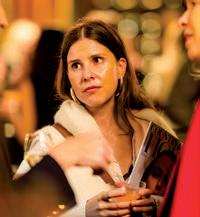



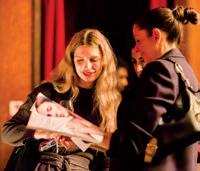


























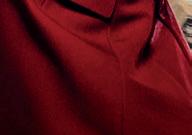




A spritz of Rémi Pujol for Christian Dior Parfums from Anya Taylor-Joy might be a festive fever dream, but why not let your fantasies run away with you this Christmas?




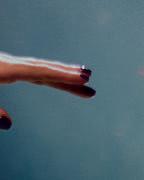



C&TH ’s first retreat, and two unmissable new beauty rituals. By
Charlotte Cole
Last month, we hosted our inaugural Balance Retreat at Lime Wood, the five-star country house hotel in the heart of the New Forest. Our intention was to move beyond the wellness buzzword and instead give guests practical, beautifully curated rituals that invite joy back into everyday life. The day began with a conversation between our wellness editor Camilla Hewitt and motivational speaker Adrienne Adhami around decision-making. Ayurvedic insights from wellbeing expert and author Jasmine Hemsley and a ‘shake it loose’ movement session guided by the extraordinary dancer and yoga instructor Renee Stewart then followed. With nutrition tips from W-Wellness ambassador Jessica Shand, a mesmeric sound bath finale with Jasmine and a goodie bag packed to the brim with ethical wellness products, a joyful day was had by all. We’re already planning the next one... will you join us?


We all need a beauty pick-me-up now that winter is coming. At Jo Hansford, you can get your face glow-up and hair blowout done in one fell swoop. Enter Glow & Blow, a new 90-minute treatment created in partnership with Harley Street aesthetic practitioner and registered nurse Emma Wedgwood. It combines her signature dermal rejuvenation (a collagen-stimulating microneedling treatment that revives dehydrated skin – it’s not painful, I promise) with Jo Hansford’s Kérastase Fusio-Dose conditioning ritual and a legendary blowdry finish. The result? Skin that is next-level soft and swishy, silken hair ready for the season ahead. Glow & Blow, £350. johansford.com
Ireland’s wellness glitterati swear by it – and when the Bad Sisters are fans, we follow. Co-founded by former barrister Jennifer O’Connell, Sisterly is an Irish supplement brand making waves and wellness routines feel achievable. Its cult sachet, The Elevator, has become a morning ritual for many, thanks to its science-backed blend of 23 nutrients designed to elevate your everyday. But Sisterly is, of course, more than a supplement. Its Sisterly community is fierce: yoga meet-ups, sea swims at Dublin’s Forty Foot and Sisterly Summits bring together the sisterhood for wellness, with a large dose of cheerful good craic. One month’s supply, £89. sisterlylab.com




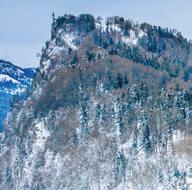


























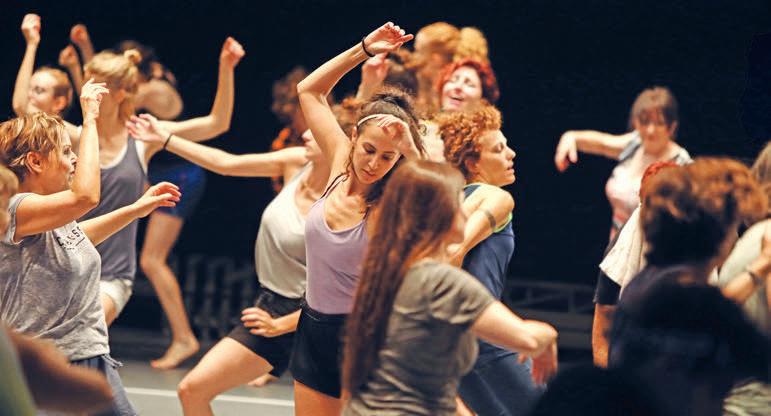
Let’s face the music… and dance. Camilla Hewitt learns to let go

We all have our preferred ways of moving –Pilates, running – but what happens when we ditch our routines and allow our bodies to move more freely?
On a recent retreat at Schloss Elmau, a divine hideaway in the Bavarian Alps, I discovered Gaga, a movement practice created by Israeli choreographer Ohad Naharin. Former artistic director of the acclaimed Batsheva Dance Company in Tel Aviv, Naharin developed Gaga as both a personal response to injury and as a way of deepening communication with his dancers. Unlike traditional dance training, Gaga isn’t about choreography or technique. Instead, it relies on improvisation, inviting participants to explore their own movement capabilities. He describes it as a ‘toolbox’ for movement, built on listening to the body.
Dance has long been part of Schloss Elmau’s history. For years, ballroom dancing took place in the hotel’s concert hall. Shortly after taking over the property, German hotelier Dietmar Mueller-Elmau put a halt to the tradition – until pianist Ludovico Einaudi introduced him to Naharin’s work and he put dance back on the agenda. Gaga aligned with his vision for Schloss Elmau: a practice to escape the self, whether by shedding selfconsciousness or the pursuit of perfection.
At the retreat, classes are led by artistic director of Gaga in the US, Saar Harari. We begin with simple actions. ere’s no set script; Harari responds to what
he sees in the room. If someone is restricted by tension or sti ness, he invites them to explore exactly that.
During one session, Harari reminds us that every action travels through the entire body – a throw doesn’t come only from the hand but from the toes, ankles, knees, pelvis, chest, shoulders, elbow and wrist. Isolated movement, he demonstrates, is inherently limited. Lightness and pleasure are just as important to the practice. ‘Smile,’ he instructs as we throw an invisible ball, ‘not only with the mouth, but with the eyes’.
Classes build gradually, joints freed one by one. Actions are repeated until they loosen and then become layered into more dynamic, full-body movement. Each time I feel myself getting comfortable and slipping into simple, repetitive dance moves, we’re asked to shift gears, speeding up, slowing down, and trying something new. ‘Our brains develop patterns,’ Harari explains. ‘Gaga breaks those patterns, creating new possibilities.’ It feels awkward at rst, but Harari’s mantra: ‘You can feel sexy or silly, just don’t feel serious,’ lightens the mood. By the end, the room is alive with people dancing in their own ways, discovering newfound exibility, agility and joy.
As adults, we often lose our childlike creativity and curiosity; we are shaped by our habits, responsibilities and routines. ere is so much freedom in movement and Gaga reminds us to be playful, encouraging us to release our inhibitions and explore what our bodies can do.
Ohad Naharin will be leading a retreat at Schloss Elmau 15-19 March 2026. schloss-elmau.de

The Movement Library
An online platform from Renee Stewart, classes weave together elements of yoga, dance and free movement. themovementlibrary.co
Sanctum
A cathartic workout combining elements of HIIT with kundalini yoga, martial arts, animalistic flow and breathwork. Weekly classes take place across London. wearesanctum.com
5Rhythms
With over 400 certified teachers worldwide, this is a freestyle movement practice offering a way to workout and creatively express emotions and anxieties. 5rhythms.com n

Olivia Falcon on how to look good and remain sane this Christmas

Here we go again. is year
I’m heading into the fray of festivities with a back-up plan – and I hope these recommendations come in handy for you too.
For migraines, period pains, joint pain or any kind of niggle, you need the incredible Graham Stones (cornerstonehealthclinic.co.uk). His technique is a little-known French practice called visceral manipulation that utilises a light touch, often around the abdomen, to untangle connective tissue that holds our muscles, organs and frame together. is has genuinely been the most incredible treatment I have tried all year.
My friend Bo recommended Stones after he completely cured her migraines, and after a couple of sessions the terrible neck and shoulder pain I’d been enduring for months (due to bad posture, age and an unhealthy habit of writing emails in bed) has magically subsided. It’s been such a relief.
I often struggle to shut o my overactive mind. To quieten anxiety, improve deep sleep and sharpen a foggy brain, I’ll be repeating a course of Exomind treatments (efmedispa.com) I tried this summer. Exomind uses electromagnetic pulses (it doesn’t hurt; in fact it feels rather soothing) to target and activate speci c areas of the brain that regulate mood, focus and emotional resilience, which is often tested this time of year.

Visceral manipulation has genuinely been the most incredible treatment I have tried all year
I’m also planning to use my Current Body Wellness Recovery Compression Boots (currentbody.com) on repeat. ey are super easy to zip into and use air compression to squeeze and massage heavy legs.
1THE IN- LAWS
This beautiful candle (a mix of rosemary, cedarwood and vetiver) is set in hand-blown glass inspired by Sherwood Forest. Baobab Collection Woods Candle in Sherwood, from £105. baobab collection. com

Brilliant to aid muscle recovery after a workout, they also improve circulation and lymphatic drainage (a godsend after Christmas indulgence, as my ankles are prone to swelling). Lying down in them is a handy tool to get out of the washing up – once zipped in, you’re forced to lie supine for at least 20 minutes while the boots make you feel lighter.
Finally: on the vanity front, I’ve been lucky enough to road test ABG Lab’s new peptide injections (coming to a clinic near you soon).
Talented dermatologist Dr Ariel Haus will be one of the rst to o er treatments including Meso Eye, which has a proprietary peptide blend that stops tiny capillaries around the eyelids from leaking (a problem that happens with age), improving the look of dark circles and helping depu eye bags. Glad tidings! n
2 THE WEALTHY FRIEND

A gem of a refillable lip balm that can be clipped to the Birkin or onto the Perfect Moment ski jacket. Guaranteed to keep lips pillowy soft with a moreish mix of natural non perfumed waxes. Officine Universelle Buly Lip Balm, £120. buly1803.com
3
TEEN QUEEN
The Chanel handbag might be out of budget but Christmas cheer is pretty chic with this palette of electric blues, oranges and lilac. Ziggy Stardust vibes. Chanel The Space Traveller Eyeshadow Palette £130. chanel.co.uk


4THE COWORKER
The water cooler is over. Those in the know are sipping from Echo Water bottles that charge water with anti-inflammatory hydrogen molecules to support gym performance and cognitive health. Echo Water, £299. echowater.co.uk
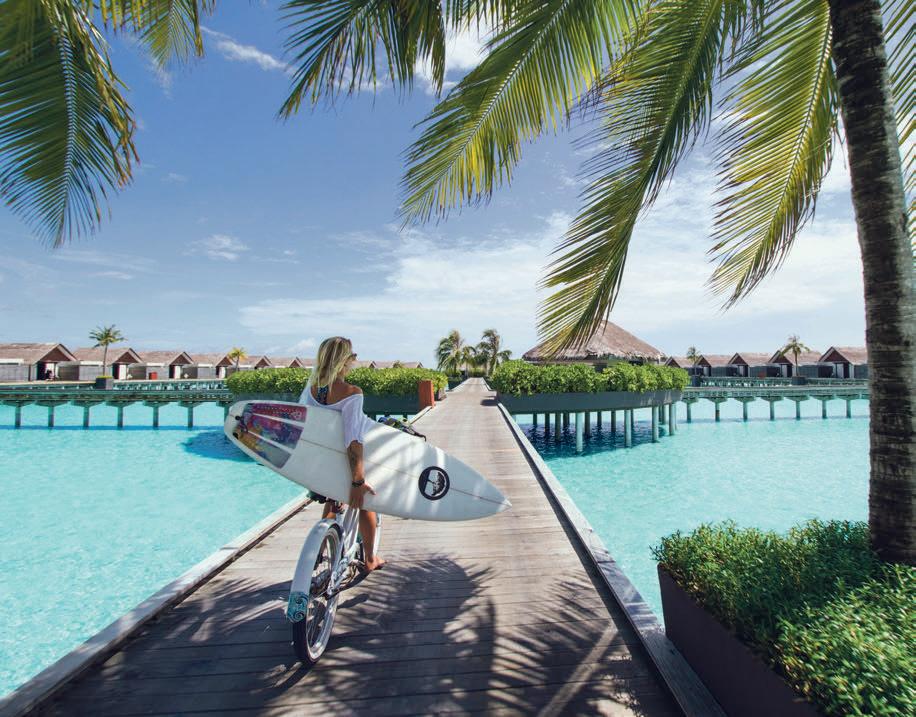
Upgrade your glow this Christmas with these ten beauty heroes, says Nathalie Eleni
1 Velvety Skin
Add a touch of velvet magic with the bareMinerals original pressed powder foundation. This talc-free, silky formula blurs pores, evens tone and leaves skin flawless while protecting with mineral SPF15. £36.50, lookfantastic.com
2 Liquid Glow
Rodial’s Soft Focus glow drops are pure magic: a serumprimer hybrid blending antioxidants with soft pearlescence for that lit-from-within finish. £75, rodial.com

3 Essential Cleanse
No matter how late the night, don’t skip your cleanse. Cellis’ everyday cleansing gelée is microbiomefriendly, gently lifting impurities while calming and strengthening skin barriers. £60, cellis.com

4 Crystal Skin in 3D
EXPERIENCE
For red carpet radiance, try FaceRestoration’s 3D Miracle Ultraclear treatment. The only ablative laser rejuvenation safe for all skin types, it delivers glass-like luminosity with minimal downtime. From £450, facerestoration.com

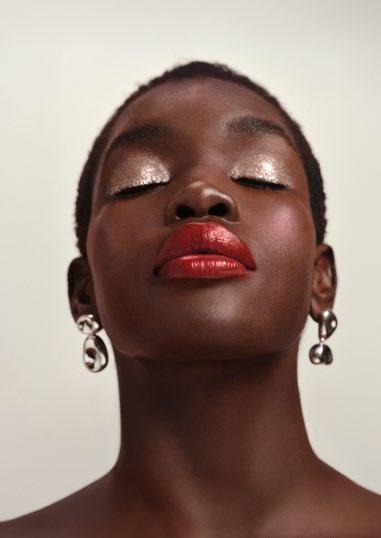

6 Candlelit Radiance
For photo-ready skin, apply
Delilah’s Wake Up Radiant elixir in Moonlight. It gives a soft, candlelit sheen both IRL and on camera. £36, delilahcosmetics.com
7 Rose Gold Radiance Facial
EXPERIENCE
For a pre-Christmas reset, book 111SKIN’s Rose Gold Radiance facial at the spa at Pennyhill Park. It sculpts, soothes and delivers a party-ready glow. From £180 (60 min), pennyhillpark.co.uk

Brighten cheekbones with Chantecaille’s radiant blush from the Éclat Cristalline collection – a sheer pink shimmer that catches the light for a magical winter glow. £91, chantecaille.co.uk


10
8
The Glacé Effect EXPERIENCE
The Signature Glacé facial at The Chancery Rosewood is inspired by Korean glass skin, with oxygen infusions for unparalleled smoothness. £450 (90 min), drwassimtaktouk.com
9 Silky Limbs
Quick-absorbing and deeply hydrating,
100 Acres’ Relax bath and body oil leaves limbs luminous – perfect under a party dress or added to bath water for instant destress. £28, 100acres.co.uk
Light Therapy Luxe Revive partied-out winter skin with the Flexidome Pro LED mask by Nooance Paris. Boost collagen, reduce inflammation and banish bacteria for an instant glow. £1,050, nooance-paris.com
Pass the panettone.
Federica Amati advises how to eat well this festive season

I’ m a big fan of Christmas – not just because I get to see the joy on my kids’ faces, but because my main passion in life is good food. Others dread the inevitable indulgence of the festive season, petri ed that pigs in blankets and brandy sauce will undo diets they’ve been following. is doesn’t have to be the case. Before I outline some ways to eat well without feeling like you’re falling o the wagon, it’s important to mention that no one follows the perfect diet. ere’s no such thing. Good food keeps us happy and healthy; if we deny ourselves everything we love, or watch every mouthful obsessively, we’re missing out.
It’s all about balance. I follow the 80/20 rule: I eat well 80 percent of the time, and the other 20 percent is reserved for when life happens. Here are my top tips to keep you healthy this winter...
You can maximise healthy ingredients, moderate how much sugar, salt and fat go into the meal, and you know there are no emulsi ers or additives. If you have kids, it’s a great idea to get them involved; teaching them the importance of good food and how to make it helps set them up for a healthier life. Ask for kitchen equipment for Christmas to start laying the groundwork for 2026 and gift cooking lessons to a loved one who could do with some fresh ideas.
I don’t like referring to foods as ‘treats’ or ‘bad’, but you know what I’m getting at. Chocolate doesn’t have to be a guilty pleasure. If you eat a few squares of minimally processed dark chocolate (75 percent cocoa or more), then it’s actively good for you. Cocoa contains avanols, which feed your gut microbiome, thereby supporting your entire body. Not everyone likes dark chocolate, but if you keep trying it, you eventually acquire the taste. And if only milk chocolate will do, Willie’s Cacao and Divine provide the joy without the raft of additives and emulsi ers.

During the Christmas period, I sometimes time-restrict my eating – not in an extreme way, but I like to give my gut an extended overnight rest if I can. I aim to leave 14 hours between the last morsel I eat (normally by 7pm) and the next food that enters my mouth – in a perfect world, that would be 9am at the earliest. We know our lunches and dinners are likely to be hearty, so by skipping breakfast (or focusing on eating something light and healthy), you can manage your overall food intake. Importantly, leaving this gap gives your gut bacteria the chance to clean up yesterday’s debris before the celebrations recommence.
Make sure you keep as active as you can over Christmas. Even if it’s just a family walk, your body will thank you for it. A short stroll will increase your energy levels, make you less likely to be tired in the afternoon, and (importantly) reduce your stress levels.
Eating well shouldn’t be about restriction, but abundance. Add extra fruit, vegetables, nuts or seeds to your plate – these bre-rich products leave you feeling fuller for longer, and less likely to indulge in foods less great for your health. Upping your intake of fermented food is also a great idea. e live bacteria help support your gut microbiome, which has wide-ranging e ects on your overall health, including brain and immune health (especially important at this time of year). Another great addition to your plate is ZOE’s whole food supplement, Daily30+, containing more than 30 plants and giving a dish a delicious science-y crunch.
Christmas can be stressful and tiring. Joyful, yes, but also exhausting. Be kind to yourself. A week or so of Christmas indulgence won’t undo your consistent e orts over time. By following some of the tips above, you can make sure you have an enjoyable festive season without feeling restricted or like you have failed. Enjoy your food, relish opportunities for eating socially with your loved ones, and focus on consistency over perfection. n





























































































































This young Inuit girl in Greenland is the subject of one of the 54 powerful photographs up for this year’s Taylor Wessing Photo Portrait Prize at the National Portrait Gallery (from 13 November, npg.org.uk)
Between blowing off the cobwebs and munching leftovers, feast your eyes on these new releases, says Olivia Emily

For Kate Winslet’s directorial debut – and a screenplay by her 21-year-old son – the Oscarwinner has leafed through her contact book: Helen Mirren stars as the quick-witted June, an ailing mother staunchly declining on her own terms, her four disparate children played by Winslet, Toni Collette, Johnny Flynn and Andrea Riseborough, and with Timothy Spall as their exhausting father. In cinemas 12 Dec; on Net ix 24 Dec
Magnetic Norwegian actress Renate Reinsve is the estranged daughter of a charismatic movie director (Stellan Skarsgård) in this delicate autopsy of art, ego and inheritance, which bagged the Grand Prix at Cannes earlier this year. Directed by Joachim Trier and also starring Elle Fanning, it promises to be the Scandi lmmaker’s biggest hit yet. In cinemas 26 Dec
Disruptive director Josh Safdie is behind this high-stakes table tennis-cum-gambling dramedy, the result of his lifelong obsession with the sport. Timothée Chalamet, playing US champion Marty Reisman, is joined by Gwyneth Paltrow, Kevin O’Leary and Tyler, the Creator as he attempts to elevate basement ping-pong into a stadium- lling sport, backdropped by vibrant 1950s NYC. In cinemas 26 Dec
Tissues at the ready… Paul Mescal’s next role is the Bard himself. He is joined by Jessie Buckley in Chloé Zhao’s long-awaited adaptation of Maggie O’Farrell’s beloved yet heartbreaking Women’s Prize-winning novel. Eleven-year-old Hamnet is the son of natural healer Agnes and acclaimed playwright Will, living in leafy Stratford with twin Judith and older sister Susanna – and is secretly dying of the bubonic plague. In cinemas 9 Jan
When Paul Mescal and Josh O’Connor rst signed onto this Oliver Hermanus lm, they were riding high o their newfound TV success in Normal People and e Crown respectively. Now bona de movie stars, expect emotionally charged performances in this WWI-era queer drama, in which a eeting romantic encounter between two young musicians triggers seismic ripples across their lives. In cinemas 23 Jan
Emerald Fennell was never going to please everybody with a new adaptation of Brontë’s beloved novel. Starring Margot Robbie and Jacob Elordi, her gloriously suggestive trailer proved it: think ngers bursting egg yolks, ushed cheeks, ngers in mouths. It’s sure to get bums on cinema seats. In cinemas 13 Feb
WENDY AND PETER PAN
Fly away with Ella Hickson’s dark but witty retelling of JM Barrie’s timeless tale. This RSC production stars Toby Stephens and Lolita Chakrabarti. Until 22 Nov, barbican.org.uk
THE GREAT CHRISTMAS FEAST
Returning to Kensington for its eighth year, immerse in Charles Dickens’ Victorian parlour alongside three courses and a spellbinding live score. 14 Nov to 4 Jan, christmasfeast.thelostestate.com
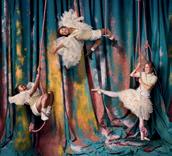
BALLET SHOES
Following a cracking run last Christmas, Kendall Fever’s playful adaptation is back, breathing fresh life into Noel Streatfeild’s beloved novel. 17 Nov to 21 Feb, nationaltheatre.org.uk
INTO THE WOODS
Sondheim’s fairytale musical lands in London for the first time in a decade, helmed by Olivier-winning Fiddler on the Roof duo Jordan Fein (director) and Tom Scutt (set designer). 2 Dec to 18 April, bridgetheatre.co.uk
A CHRISTMAS CAROL
Adolescence creator Jack Thorne is better known at Christmas for his definitive stage adaptation of the Dickens classic, returning this year with Paul Hilton playing Scrooge. 12 Nov to 10 Jan, oldvictheatre.com

THE NUTCRACKER NOIR
Exploding onto the immersive festive theatre scene, this spins a whimsical and twisty tale across five rooms and a three-course dinner at Club Noir in Shoreditch. 25 Nov to 21 Dec, nutcracker-noir.com



Lucy Cleland looks back at C&TH ’s first Chelsea Arts Festival in association with Cadogan, a joyous takeover of SW3
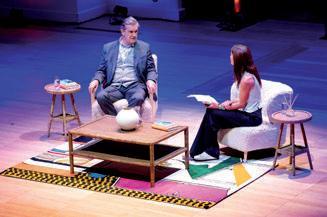
Rupert Everett and Ian McEwan kicked off the first day Cadogan Hall set the tone with Rupert Everett settling in for a confessional, career-spanning conversation with Hannah MacInness, followed later by Ian McEwan talking to George Monbiot about his new book What Can We Do













Fashion as self-expression
Gallery fizzed with strong style choices as legends Zandra Rhodes and Daniel Lismore discussed today’s creative landscape as well as the liberating power of dressing like no one else.


Ronnie Scott’s turned Cadogan Hall into a dance floor The audience were rocking in the aisles when Ashton Jones and a ten-piece band tore through jazz, funk and soul to close the second night with a bang – and a boogie.

and substance VIPs including LionHeart were chauffeured in style by
throughout
and were

A candlelit Royal Court reading traced a year in verse – from January’s ‘beginnings’ to December’s ‘celebration’ – with Allie Esiri, Susan Wokoma, David Morrissey, Kate O’Flynn and Rory Kinnear.


flooded the area with some of the most lauded – and breakout – talent in the land
Men’s mental health with Matt Haig & Jordan Stephens Emotional honesty with Matt Haig and Jordan Stephens who opened up to host Annie Macmanus about mental health, masculinity and creative survival.

dreaming


Podcasting live from the Court Ambika Mod and David Byrne were guests on The London Theatre Review’s first ever live recording in front of a game and diverted audience at the Royal Court theatre.

Take it outdoors

Anyone wandering around SW3 throughout the festival would have been thrilled at the music, puppetry and entertainment that brought the streets to life throughout.
A grand finale: the Women’s Prize at 30 Malala Yousafzai joined a roll call of talent, including Sir Lenny Henry and Dame Sheila Hancock, for ‘A Celebration of Women’s Words’, in partnership with The White Company. An after-party at Vardo brought the festival to a happy close.
Ed Vaizey visits Marie Antoinette Style at the V&A and considers a volte-face on historical conjectures of the fashionable French queen



Marie Antoinette greets you coquettishly as you enter the exhibition at the V&A. e animated digital rendition based on an original portrait is delightful, and the subject blissfully unaware that just a few rooms away the museum has displayed the blade of the guillotine that is reputed to have chopped o her stylish head. e guillotine blade is the only jarring note in this exhibition, which is saccharine sweet, lavish and luxurious. Marie Antoinette Style is another staging post in the rehabilitation of this fashionable French queen. Historians have moved on from the rendition of her as a pointless elitist spendthrift, to seeing her as an important patron of the arts and culture.
e V&A states its aim explicitly: ‘ e arts of her time remain in her husband’s name: the Louis XVI style. What, if instead, we considered the “Marie Antoinette style?”’
e exhibition not only celebrates Marie Antoinette’s fashion but shows how she continued to in uence style through the ages. She was the original ‘It girl’, helping to create the whole ecosystem of fashion with which we are so familiar today. e rst ‘stylist’ – or marchande de modes – existed in her court, Rose Bertin, and on display are annual publications detailing the latest hairdressers, a profession that emerged as a result of her in uence. e luxury and largesse is overwhelming. e rst object to greet you is a near contemporary replica of Marie Antoinette’s wedding dress. Its iridescent glow is enthralling and its physical structure astonishing, with eight foot wide hips and a waist narrower than an hour glass. It dominates
the room, as it would a quarter of a millennium ago. Also on display are dazzling diamond necklaces, and more prosaic items such as a travelling toiletry. Many of these have never left France before.
e V&A does what it does so well, placing historical objects alongside their contemporary descendant, making explicit the parallels with the world we live in today. e exhibition ends with a grand ourish, a display of modern dresses inspired by Marie Antoinette, dominating the room in a thrilling tour de force display. It’s a reminder of how 250 years later she could in uence Vivienne Westwood, Chanel, Dior, Kate Moss, So a Coppola (who made a lm about her, the costumes of which are on display here) and Manolo Blahnik, who has sponsored the show.
e National Gallery of Art in Washington has lent a portrait of Marie Antoinette that caused a sensation – a copy of one by Élisabeth-Louise Vigée Le Brun, a female painter championed by the French queen. It portrays her in an informal white dress, which shocked the court – in e ect, they considered her to be dressed in her underwear. e portrait was quickly replaced but still it was displayed informally, giving rise to the new fashion of chemise à la reine or day dress.
It is a ne moment in the exhibition to contemplate how the elite can in uence fashion and to understand Marie Antoinette’s evolving style towards simplicity – but to also consider the a ectation and arti ce involved, a luxurious denial of a lavish lifestyle that eventually led its subject to the most arresting object in the whole exhibition: the blade of the guillotine.
Marie Antoinette Style is at the V&A until 22 March 2026. vam.ac.uk n
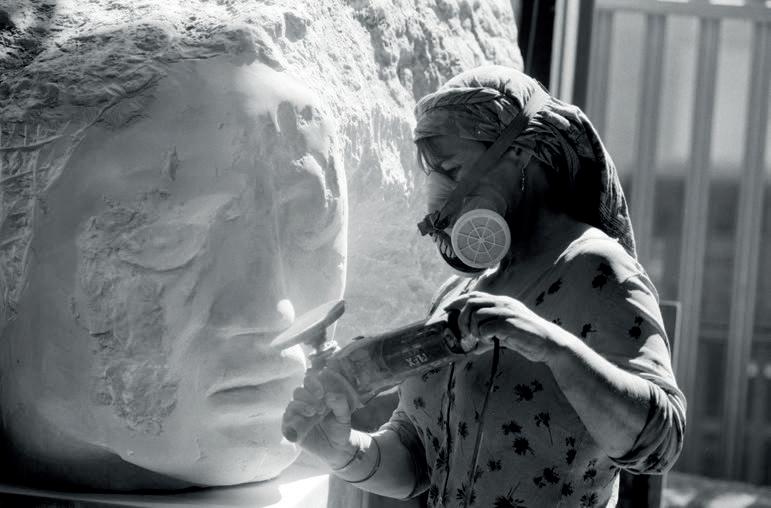
Emily Young’s meditative sculptures – exhibited from St Paul’s in London to La Défense in Paris – hold life stories in the fault lines of the stone, finds Olivia Cole
With the Mediterranean in view and ancient quarries close at hand, there could not be a more perfect studio than a former Tuscan monastery for British sculptor Emily Young. Her monumental carved heads are an arresting part of the British landscape, from St Paul’s Churchyard to Salisbury Cathedral and Berkeley Square. Whether precious onyx, lapis lazuli or marble, Young sources and uses raw stone materials that are often hundreds of thousands – sometimes even millions – of years old. Her sculptures are so striking they often seem as though they have been excavated, rather than the work of a contemporary artist at her peak.
Fifteen years ago, Young moved her unique practice to Italy. It was, she says, a dream ful lled. England’s biting cold isn’t a hospitable landscape for an artist who likes to work long hours outside, free carving into the night. She recalls working in the snow in west London; now her o ce is in a monk’s old refectory, with working spaces sequestered away from the more sociable parts of the building where she can move freely. ere’s a spiritual kinship with Italy, too: a country ‘deep’ in Young’s bones. When she was two, her dad was posted to Rome as the correspondent for the Manchester Guardian, taking his family along with him. e sun-soaked stones made for a magical formative playground. Even after they came home, the family returned to Italy every summer. ere aren’t many sculptors at home in the land of Michelangelo and Bernini – but Young’s sensual stonework, with its great emotional heft, belongs here too, installed in their company at the V&A’s sculpture galleries. She has also been celebrated at the Venice and then Florence biennale, where she was presented with the Lorenzo il Magni co Lifetime Achievement Award.
Young’s life as an artist began as a painter. But as the mother of a tiny baby, she moved house for more space and found abandoned o cuts of kitchen marble worktops left behind in the garden. ‘It’s ridiculous, but somebody had actually left a hammer and chisel too. I carried it around for ten years, thinking they’d come back and pick it up. I started doing these very shallow reliefs and I loved the stone’s resistance.’
Decades on, with a second studio in Dorset and her west London showroom, her heads, torsos and discs are cherished for their meditative, peaceful qualities, holding whole life stories in the imperfections and fault lines of the stone. ‘It may show signs of great dramas in the past: huge geological phenomena, earthquakes and volcanos and god knows what. All of that, you can read in the stone.’ Yet on the other hand, ‘there’s a stillness’.
Her work has even found a place under the sea. In her spare time, Young adds to Casa dei Pesci (Home of the Fish), a non-pro t established in 2012 to restore the marine habitat of the Maremma coast. e project began as the brainchild of a local sherman who wanted to stop over shing. He stopped trawlers – quite literally – by dumping concrete slabs just o the coast. Young has doubled down on his e orts, adding (so far) three carved works in Carrara marble and enlisting other artist friends to come and make work (now totalling 44 sculptures) to sit beneath the waves.
‘Dolphins have returned because the sh are there again for them to catch,’ she says. e resulting underwater sculpture park has, unsurprisingly, become a pilgrimage for divers, joining those lucky sh swimming freely around this vision. Whether it’s under the sea or above the surface, Emily Young’s extraordinary creations stop us in our tracks. n




The arts are a Trojan horse, sneaking in social change, says Kate Varah. Charlotte Metcalf meets the National Theatre’s executive director
PORTRAIT BY ALEXANDRA DAO
COUNTRY COTTAGE OR PENTHOUSE?
Somewhere high on a remote cliffpath in Cornwall, where I can march in the bracing sea air.
MICHELIN STAR OR PUB?
I’m a veggie so find me a Michelin starred vegetarian restaurant and I’ll be straight in there.
DOG OR CAT?
I’m not really an animal lover but we have two Tibetan terriers and our new cat Peanut has stolen our hearts.
HEELS OR FLATS?
Superga trainers that go from office to opening night.
COUTURE OR COUNTRY CASUALS?
I need outfits that can morph at a minute’s notice so a bit of both.
Since Kate Varah became executive director in April 2022, she has set out to smash barriers to entry, social or economic, making the National eatre an inspiring, accessible experience for absolutely everyone. She has reason to feel con dent as, when we meet, everyone I know is talking about Rosamund Pike’s performance in Inter Alia, Suzie Miller’s sister play to Prima Facie, which starred Jody Comer.
Varah is thrilled to be working alongside her co-CEO Indhu Rubasingham, appointed the National’s new director this spring. ‘Indhu’s hugely talented and this season we’re mounting phenomenal plays, including Bacchae, Hamlet, Les Liaisons Dangereuses and Pride, combining artistic excellence and social mission, which is what we exist for.’
So what is her overriding aim? ‘Encouraging the next generation to come into the theatre. Every sixth former could have a job here as a nurse, IT technician, producer or lawyer alongside writers, actors, prop makers, costume designers. Last year we opened our Skills Centre, and government investment, along with recently secured funding from Bank of America, has allowed us to boost our training to 5,000 young people a year, up from 3,000.’
Inspiring young people into a theatre career starts at school. ‘We have to be a home for tomorrow’s artists,’ she says, pointing to initiatives like the National’s youth theatre festival Connections or new playwriting programme New Views, helping schoolchildren create content around things that really matter to them. e National eatre also works in 90 percent of state secondary schools through its online digital platform, the NT Collection, and following a pilot in 500 schools in New York, recently expanded across every US state. National eatre at Home, an online subscription service, is now available in 184 countries.
‘We’re really boosting British soft power,’ says Varah, ‘but it’s vital to be local too and develop audiences.’ She cites Sunderland, where a recent community project led by the National created a production telling empowering, positive stories about the city.
I ask where her love of theatre originated. ‘I grew up in Warwickshire and my mother was a journalist, so I’d go along to the Belgrade in Coventry or the RSC. at heady
mix of Shakespeare and pantomime was amazing. I love panto because it’s a gateway into theatre, and democratising access to theatre is the number one reason I do this job.’
Varah read theology at Oxford, where she was president of the Oxford University Dramatic Society (OUDS). Did she ever act? ‘God no,’ she laughs, ‘At school I was an Ascot lady/sweeper in My Fair Lady and it was a very short-lived experience. I’ve always been a behind the scenes person.’
In her third year, Varah landed an Arts Council internship and was o ered a job in the press o ce. But the secretary general, Mary Allen, persuaded her to turn it down and get a commercial quali cation because the arts sector lacked people with business acumen. So Varah became an employment lawyer at Linklaters. ‘It was brilliant because I love people and grappling with discrimination and other knotty issues. But after six years, it was time to make the jump.’
Varah’s grandfather was Chad Varah, founder of the Samaritans, so perhaps it’s no surprise she chose to work at Chickenshed for its strong sense of social mission, combining art with pioneering inclusion. From there she went on to e Old Vic until she arrived at the National and became custodian of the famous modernist building – loved and hated equally – upholding it as a world-class destination. ‘Everyone should walk into the National and nd it welcoming and a ordable. No-one should ever be made to feel, “Is this really for me?”’
We end on a personal note as she tells me how proud she is to juggle her career with raising sons – twins who are 16 and a 14-year-old. ‘My boys are my ready-made focus group. ey think everything’s too long. I understand wanting to absorb content fast and online, but then there’s nothing like experiencing the rare moment, that alchemy that happens when a thousand people are in the same space sharing similar emotions. e joy of that will become even more prized as we move further into this digital age. When people gather on the South Bank, in their local cinema, at school or even on their sofa to watch one of our lmed productions, conversations strike up and barriers dissolve. e arts are a Trojan horse, sneaking in social change. Our challenge is to continue ensuring our content is fresh and thrilling and welcoming to absolutely everyone.’ n
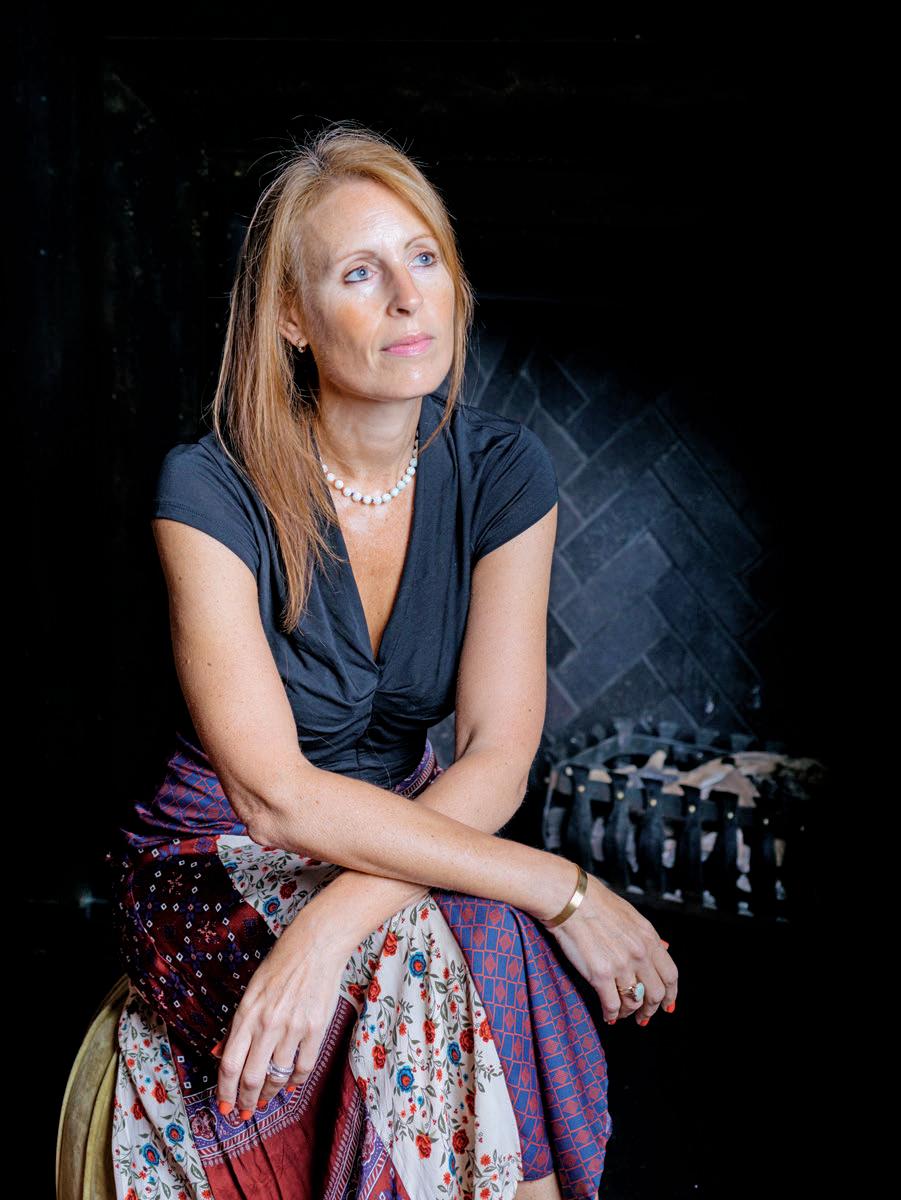
‘There’s nothing like experiencing the rare moment, that alchemy that happens when a thousand people are in the same space sharing similar emotions. The joy of that will become even more prized as we move further into this digital age’
You conjured this story from the real-life Ålborg witch trials of 1619-21. Do you feel like a sorcerer yourself? I feel like a witch every day. Long before starting e Wax Child, I studied manuscripts about magic and folklore and recreated the recipes and spells. I found an amazing literary tradition of folk magic. e novel began as a dialogue with those ideas. I wanted to write it as one long spell that would put the reader into a kind of trance and leave them, hopefully, transformed.
What is a ‘wax child’ and why did you make it the narrator? It’s a European voodoo-doll. I have a thing for non-human narrators, the idea that objects can talk if you listen. I hate historical novels because we see people’s internal lives through the veil of our own time. In the Ålborg case, a wax doll was produced in court as evidence of witchery. My narrator became a kind of portal or remembrance-object who instills uncertainty about the past. It’s almost an anti-historical novel, because it keeps asking: how can we understand history? at question is unanswered, but the agony of our longing to know is everywhere.
Did you have any revelations while writing? In my research I sometimes feel the sources or landscape speak to me, a sort of whispering, populated with kind ghosts that tell me secrets if I listen very closely.
What’s the significance of Christenze’s noble birth?
She has a title but no money and is unmarried. She’s a sort of Jane Eyre gure who lives at Lady Anne Bille’s house like a maid-friend, very common then. It became great national news that a noblewoman had been down and dirty with these lower-class women. One of the fun things in writing the story was that Christenze thinks she’s better than the others.
Were Christenze’s close female friendships used as evidence of her ‘unnaturalness’? It was more the idea of her being loose sexually that was seen as a sign of witchcraft. It was me who added the sapphic vibes. I wanted a less-de ned line between female friendship and erotic relationships.
You remain ambiguous about whether Christenze’s voodoo practices are responsible for Lady Anne’s miscarriages. Why? I want the reader to confront their own, perhaps unrealised fears of witchcraft. Lots of longheld traditions were suddenly criminalised as witchcraft in Denmark-Norway in 1617. ese mentality shifts initiated by the secular authorities through legislation are something people are experiencing right now.
Who are the witches of today? King Christian IV


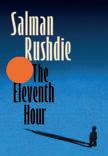
by Salman Rushdie
Unbowed by the savage knifeattack he suffered in 2022, 78-year-old SalmanRushdie brings us five absorbing stories that explore the witching hour of old age,whenwe review our lives andsquare up to approaching oblivion. From the confused ghost in an Oxbridge college to the last man standing in a loyal friendship group, his compelling characters grapple with insoluble questions of life. And while revenge is a theme, these vivid stories seem heroically unclouded by bitterness. (Vintage, £18.99)
promoted fear of witchcraft to underpin his power, and accusations of ‘otherness’ are still used by authorities to bring people into line. For example, I believe that UK laws a ecting trans people are designed to uphold the traditional gender roles underpinning the nuclear family, which is one of the key building blocks of the economy.
How did your male translator respond to the misogynistic male characters who punish women for being ‘wicked and imperfect’? I did enjoy writing some one-dimensional evil male characters in this book; that was a small revenge. But my translator Martin Aitken is a genius. His understanding of poetry, language and music is more important than gender.
Do you belong to a coven? Yes, we meet twice a year. But I’m sworn to secrecy.
Have you ever cast a spell? Oh my god, so many.
What does an ideal writing day look like? I live in Copenhagen and have absolutely no routine. I don’t even have a desk. Each time I nish a book, my husband says: ‘When did you write this? I don’t understand.’
Which childhood book made you want to be a writer? Grimms’ Fairy Tales, the original violent versions. I read everything as a child. I was famished for books.
You’re a celebrated writer and poet in Denmark and your novel The Employees was longlisted for the 2021 International Booker Prize. Where can English fans find you? I have a substack called is Mess.
e Wax Child by Olga Ravn, translated by Martin Aitken (Viking, £14.99). Read the full interview at countryandtownhouse.com/culture/cth-book-club n








































C&TH friends share their greatest reads of the year
Charlotte Runcie
This is an alarmingly recognisable novel about what it’s like when you’re friends with a funny, successful, slightly vicious newspaper critic who has a reputation as a terrible shagger and who abruptly becomes tangled in a #MeToo scandal. It could have been inspired by at least eight people I know. For clarity, I’m not one of them. The Borough Press, £16.99
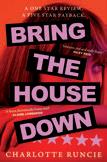


Abdulrazak Gurnah
The long-term trauma of children left behind in war is vividly imagined by this Nobel prizewinner who escaped war-torn Zanzibar for a successful life in the UK. Karim and Badar are on markedly different paths, yet both fall for beautiful Fauzia. The author’s compassion for these three young people as they navigate a difficult world is deeply relatable. Bloomsbury, £18.99
Chloe Dalton
The joy of Dalton’s tale about her relationship with the tiny baby hare is that you really feel it could have been you. In fact, you wish it had been. The experience of raising this creature is a window into one of the most beautiful relationships imaginable, as well as a poignant reflection on what’s at stake when we treat nature and animals the way we do. Canongate, £10.99

by Mick Herron
There is only one book worth recommending. I was an early adopter of Mick Herron of Slow Horses fame, and his latest masterpiece Clown Town has just emerged. If you are a fan of the Apple TV series, the books are a must read. The dialogue from anti-hero Jackson Lamb is on another level. Baskerville, £18.99



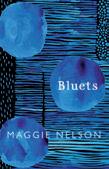






by Maggie Nelson
I’m cheating as I read this poetry collection at least twice a year and have done since publication. There’s something so profoundly personal about it that speaks to me. I’d recommend it to anyone interested in the curiosities of our unique human experience, or if you love the colour blue. Jonathan Cape, £12.99
by Florence Knapp
With three versions of the storyline plus time hops, I was totally absorbed by the expansive lives of Cora, her son Bear/Julian/ Gordon and daughter Maia. Each plot is layered and bittersweet – there is dread and desperation alongside glimmers of kindness and hope Phoenix, £16.99
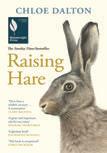




by Jonathan Buckley
A small Greek town is revisited by a grieving woman who reconnects with the friends she made there a decade earlier. A quiet but technically brilliant novel in which themes of identity, guilt and responsibility are deftly interweaved. It has been a great favourite at Sandoe’s. Fitzcarraldo, £12.99
by
Robert Elms
Elms was one of the original New Romantics and this is a first hand account of the Covent Garden club that gave birth to Sade, Spandau Ballet and Culture Club, artists, actors, directors, fashion designers. It’s a tie-in with the Design Museum’s Blitz exhibition, which is equally fabulous. Faber & Faber, £20

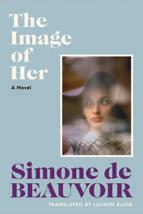
Lisa Armstrong, Journalist CARELESS PEOPLE by
Sarah Wynn-Williams
You might not be surprised by this whistle blowing account from inside Facebook, but you definitely will be horrified. Wynn-Williams paints a picture of top-down amorality; no wonder Facebook, now Meta – erstwhile champions of free speech – tried to suppress it.
Macmillan, £22
Alice B-B, C&TH Editor-at-large COURTSHIP by
Laura Bailey
This is a love letter to tennis with photographs, essays and short stories that span the world’s courts – from the South of France to the Swiss Alps, from iconic tournament showstoppers to secret tumbledown charmers at the heart of a family or community. This book makes the right kind of racket. Rizzoli, £50
Lucinda Baring, C&TH Deputy Editor MONSIEUR OZENFANT’S ACADEMY by Charles
Darwent
Ozenfant ran art schools in Paris and London in the 1920s and knew everyone from Le Corbusier to Leonora Carrington. Despite this, he passed into obscurity. This short, beautiful book is a superb resuscitation of a fascinating individual. Art Publishing Inc, £25

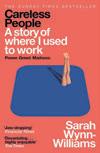








Celia Walden, Journalist THE IMAGE OF HER by
Simone de Beauvoir
This uplifting tale of a middle-class mother buckling beneath the weight of a perfection that society has imposed upon her could have been written yesterday. Only the best books can connect you to the past in the way this one does – to the women that came before you. And de Beauvoir’s writing takes your breath away. Vintage, £14.99
by Martin Brudnizki
From the decadent rococo interiors he created for Annabel’s to the ode to pink in his own bedroom, Brudnizki uses colour as an essential ingredient in his storytelling. Each chapter of this joyful book is devoted to a single hue, showing how he sews the emotional power of colour into his work. Rizzoli, £50
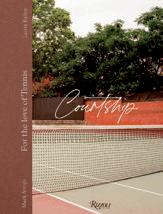





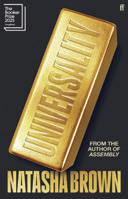





by
Natasha Brown
Brown burst onto the literary scene with Assembly. This follow-up sees a cabal of hippie anarchists squatting on an abandoned Yorkshire farm when their leader is bludgeoned with a solid gold bar. It’s a slim and slippery tale cutting right through Britain’s class/ power/truth clamour. Faber & Faber, £12.99
by
Percival Everett
Never mind all the prizes. It may have won the Pulitzer and was shortlisted for the Booker, but what you need to know is that James is a rollicking retelling of The Adventures of Huckleberry Finn from the point of view of Jim, Huckleberry’s slave friend. A fiercely clever (and funny) page turner. Picador, £9.99
Lisa Grainger meets Bénédicte de Montlaur, the head of the World Monuments Fund on a mission to save meaningful places – including the moon
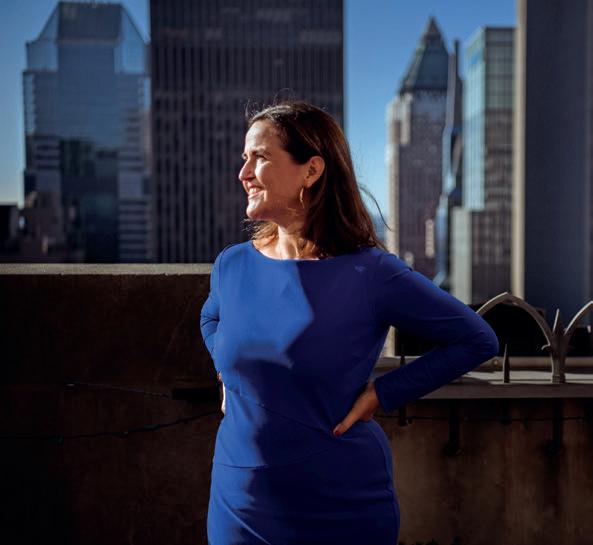
énédicte de Montlaur is one of those women who always appears to be upbeat. But when I talk to her over Zoom, she is positively zzing with energy. e president and CEO of the World Monuments Fund (WMF) is about to leave New York for a series of celebratory dinners across the globe – including at Windsor Castle – to mark the organisation’s 60th anniversary. e elegant Frenchwoman, clad in a suitably chic scarlet dress, is also heading to France to be awarded the country’s highest civic honour, the Légion d’Honneur, alongside culture giants such as David de Rothschild and Bernard Arnault. ‘And that means champagne!’ she says delightedly. ‘Good French champagne.’ e 47-year-old has much to celebrate. Since assuming her role in 2019 – after four years in New York as head of the Cultural Services of the French Embassy, where she launched a podcast; the now hugely popular Night of Philosophy and Ideas events series; and an intellectual festival to debate issues from racism to democracy – the WMF has had considerable successes. Not only has de Montlaur managed to double the amount raised for heritage sites across the world from $13m to $28m and created a junior board to bring in youthful advocates, she has attracted high-pro le ambassadors from Anna Wintour and Salma Hayek to Christian Louboutin to help amplify her message about the importance of saving mankind’s heritage.
Heritage, she stresses, is not only the big famous buildings like Angkor Wat and NotreDame. It’s the everyday structures that tell you something about a nation’s culture: a wooden monastery in Bhutan where the devout have prayed for centuries; Peruvian burial sites from ancient civilisations; and the Moseley Road Baths in Birmingham and the Assembly Rooms in Belfast, where local communities have converged. ‘People need structures to bring them together. ey need symbols of their past to rally around.’
It is usually when these are destroyed by
war or natural disasters, de Montlaur says, ‘that people realise what they’ve lost – and what they meant to civilisation’. Take, for instance, the sixth-century Buddhas of Bamiyan, blown up by the Taliban; or the ancient city of Antakya in Turkey, attened by an earthquake; or NotreDame in Paris, which caught re ve years ago. ‘Everyone had a deep emotion about the cathedral burning,’ she says. ‘It was our common path being destroyed.’
Because the WMF is not a grant-making organisation but instead nds heritage areas or structures that need restoring before bringing together donors and experts to revitalise them, its work is varied. After the Notre-Dame re, it gathered 500 re ghters to share learnings with other institutions so future res could be
avoided. In India, it provided expertise to restore stepwells and communities’ access to water. In Tanzania, it assisted in the replanting of destroyed mangroves to protect villages against rising seas, and in China, created strategies to prevent overtourism in Buddhist grottoes.
For the Metropolitan Museum’s new Arts of Africa galleries, WMF even commissioned a lmmaker to make mini-documentaries on special African sites so more people can know about them. ‘Everyone knows about Versailles,’ de Mountlaur says, ‘but who knows about Great Zimbabwe, which is the largest stone structure in sub-Saharan Africa and is as intriguing as the Eygptian pyramids? We want people to be curious, to understand the treasures on our planet that need protecting.’
Once these sites have been discovered, she adds, then countries can build tourism projects around them and create new economies. ‘ ink of France and Spain and Italy – people go there to see their heritage. Or Angkor Wat [on which the WMF has worked for 35 years]. When we arrived there, it was just after the fall of the Khmer Rouge; they had killed anyone with a degree. So we helped restore temples and train craftsmen. Today, it’s a huge part of the economy.’
In Iraq, she adds, WMF is helping to rebuild the Mosul Cultural Museum, whose building and collections were destroyed by ISIS. e restoration of key landmarks like this gives ‘a common purpose to people, creating an income for some and inspiration for all. ey can rally around those places that represent their identity and history and recreate activity around them’.
Unlike at many other ‘heritage’ organisations, de Montlaur says, the WMF projects are nominated by communities who want to save something they love. Every two years, 25 are chosen for the World Monuments Watch and help is given to them, ranging from expertise to funding. Increasingly, money is being donated by heritage lovers from all over the world, rather than just by the US – where in 1965, Colonel James A. Gray set up a New York-based non-pro t that would later become the World Monuments Fund.
Expanding the organisation’s donor base to other parts of the world has been a big part of de Montlaur’s role, she adds. Today, the WMF has 700 projects in over 112 countries (as well as one on the moon to protect the technology and footprints we have left behind), funded by

14 international chapters from Peru and the Middle East to the UK.
A key function is also resuscitating old crafts. ‘In Mandalay, we found an old man who had restored a temple and got him to train young furniture-makers. In Japan, with backing from Ti any & Co., we are helping to bring back gold-leaf experts in Kanazawa, where the art was dying.’
Why should anyone care about heritage? ‘Because so many of these things are so beautiful,’ de Montlaur says with feeling, ‘and that elevates the soul.’ It also gives us a record of our past, she adds, and how it evolves. At the Alhambra in Spain, there are both statues of the Virgin Mary and inscriptions in Arabic –a physical manifestation of how we can all live together. ‘Our life is so fast. And so preserving these places gives a sense of continuity, of meaning, and of sanity.’
What she needs, she emphasises, is for ‘everyone to get involved in our network of concerned citizens. e more of us who protect the wonders of our world, the better’.
wmf.org n

Today, the WMF has 700 projects in over 112 countries – as well as one on the moon to protect the technology and footprints we have left behind
Can changing our attitude to wild and farm animals reconnect us with nature? asks James Wallace
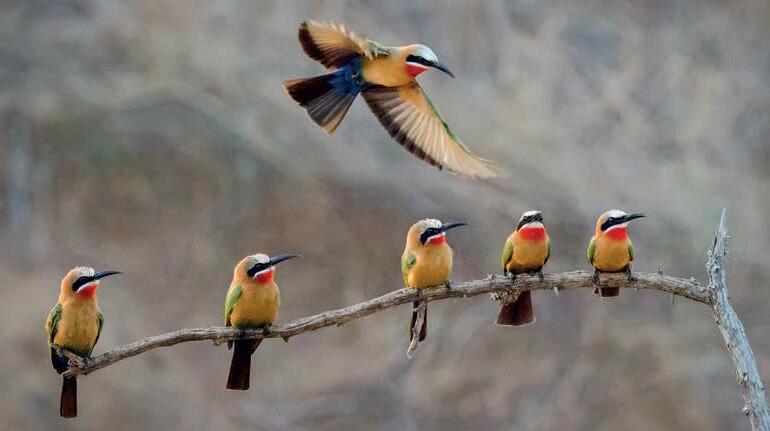

With 26 million pet cats and dogs, we regard Britain as a nation of animal lovers. We feed them like royalty, we mourn them like a lost child, we anthropomorphise them. Putting aside the 900,000 annual calls to the RSPCA’s cruelty line, we treat our pets like our family – but when it comes to farmed animals and wildlife, there’s a di erent story.
Let’s start with factory farming. An abhorrent system of cruelty, and yet as commonplace in our landscape as a KFC or Tesco’s chicken is on the average family’s weekly menu. Clever marketing will tell us all is well: Mrs Henny Penny lived a joyful life, raised with care by Farmer Giles in verdant sunlit pastures. e reality? She lived ve short weeks in excrement-covered hell, and all for our delectation at a darn good price. Ever wondered where the boy chicks in egg factories go? Look no further than your dog’s dinner.
We know this industrialised exploitation is happening but often ignore our moral compass to save a few quid. We know there is a happier, organic, outdoor-reared chicken alternative – or a no-chicken option – but we don’t give two clucks. Why? Perhaps this poultry microcosm re ects our
disconnection with nature. We love an Attenborough documentary, we donate to WWF, we care about climate breakdown, pollution and wildlife extinction – but only if it doesn’t a ect our wallets.
It’s a global problem, too. Chris Packham was recently in Cyprus with his daughter to highlight the industrial slaughter of half a million songbirds. He called me to check out the livestream, and what followed was truly horrifying. Although it’s been illegal since 1974, men in balaclavas were trapping rare thrushes, bee-eaters, wagtails and warblers migrating north from Africa using nets or glued limesticks, then pickling or grilling them for a dish called ambelopoulia. e owl and falcon are innocent bycatch.
But for many of us who turn a blind eye to legal farm animal cruelty or the illegal wildlife trade, there are as many who open their eyes to developing a closer connection with – and responsibility to – our natural cousins that feed us and y with us. Birds even brought me a girlfriend: after endless scrolling on a dating app, I found a beautiful soul with auburn hair, Gaian curves and a great grey owl perched on her wrist that matched the magpie sitting on mine.
If we can think of the cat, the chicken and the songbird as an extension of ourselves, we can end the self-harming acts of animal cruelty and realign ourselves with our planetary Gaia, sustainer of our lives, Mother Earth.
THINK DIFFERENTLY, ACT NOW
Think animal crackers, not animal cruelty

LEARN See the truth behind factory farming. ciwf.org.uk
JOIN Sustain, the alliance for better food and farming. sustainweb.org
SUPPORT The end of illegal bird killing. komitee.de/en n


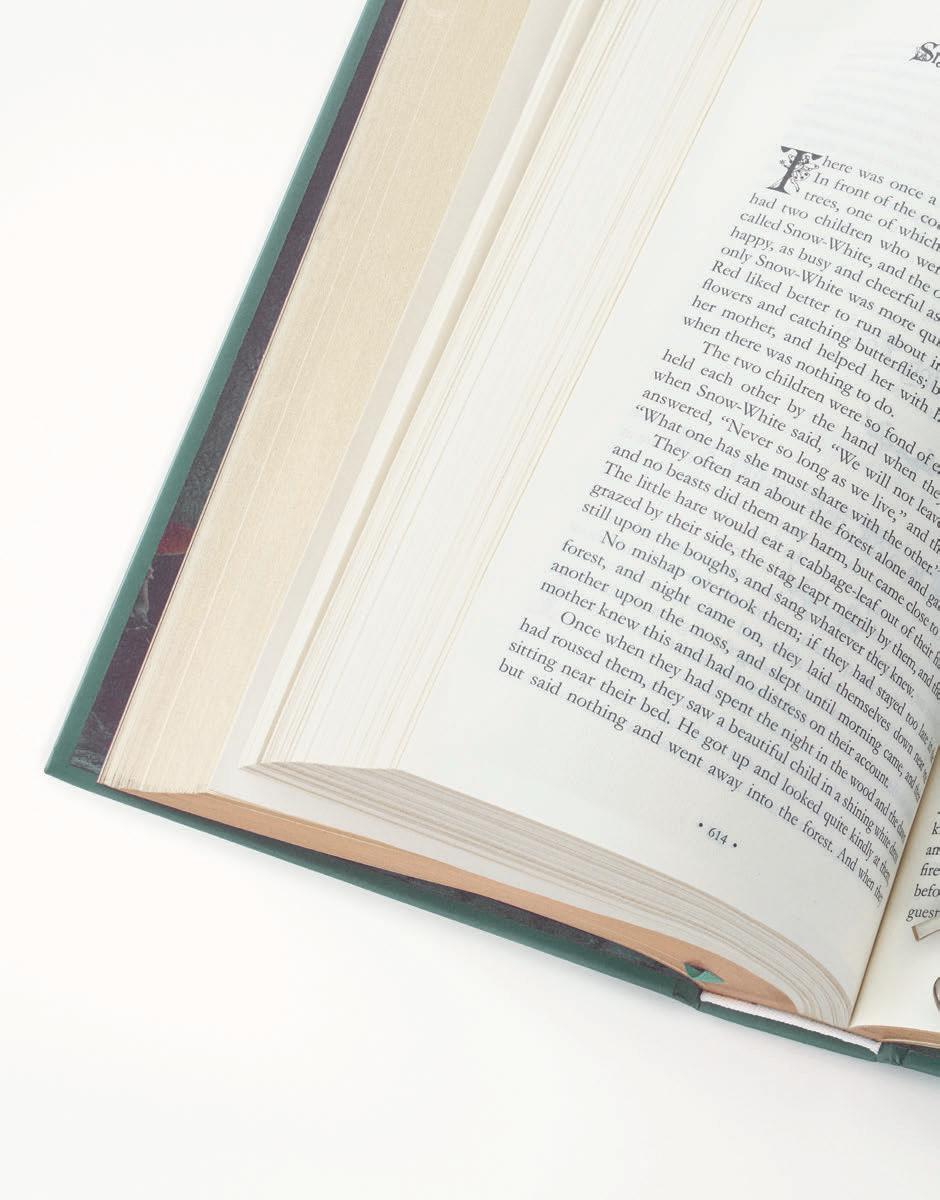
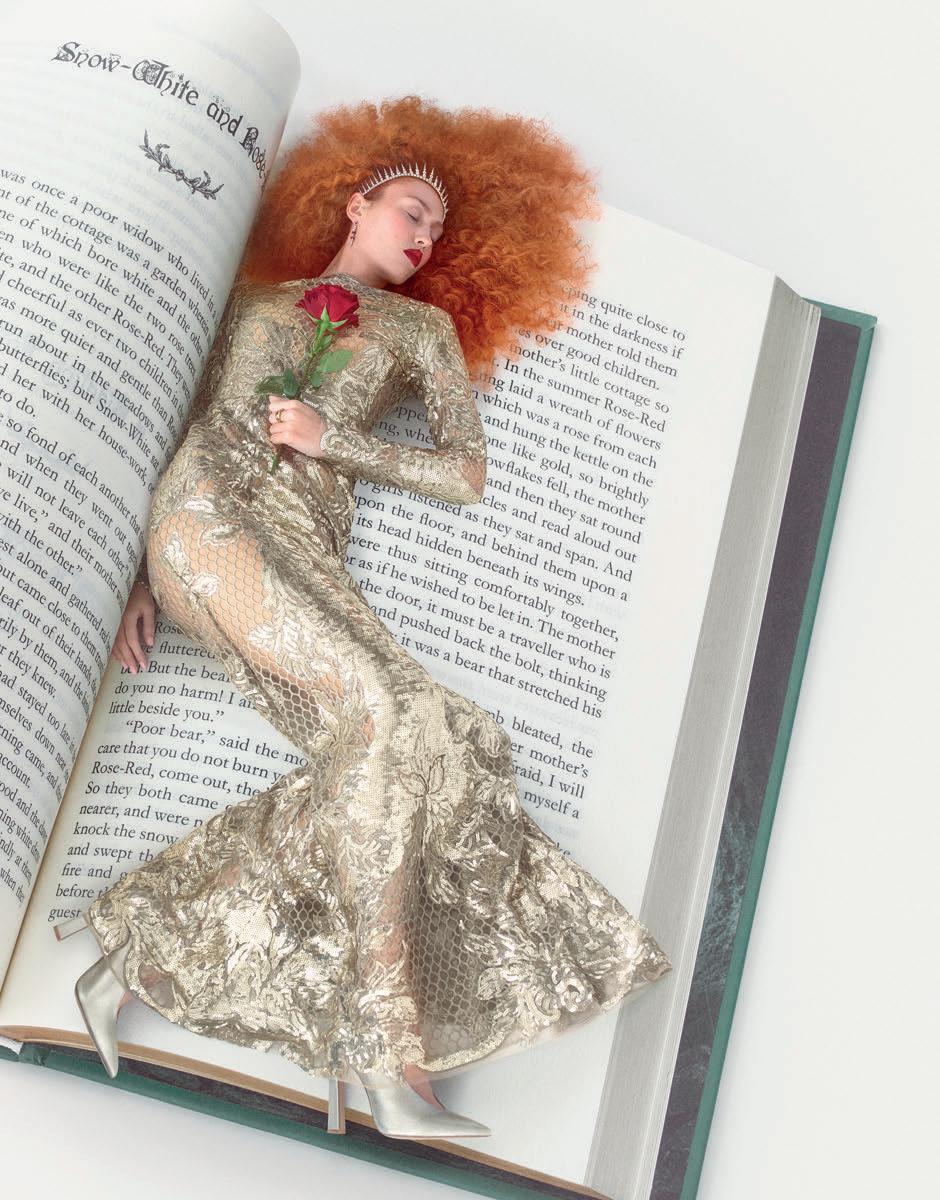
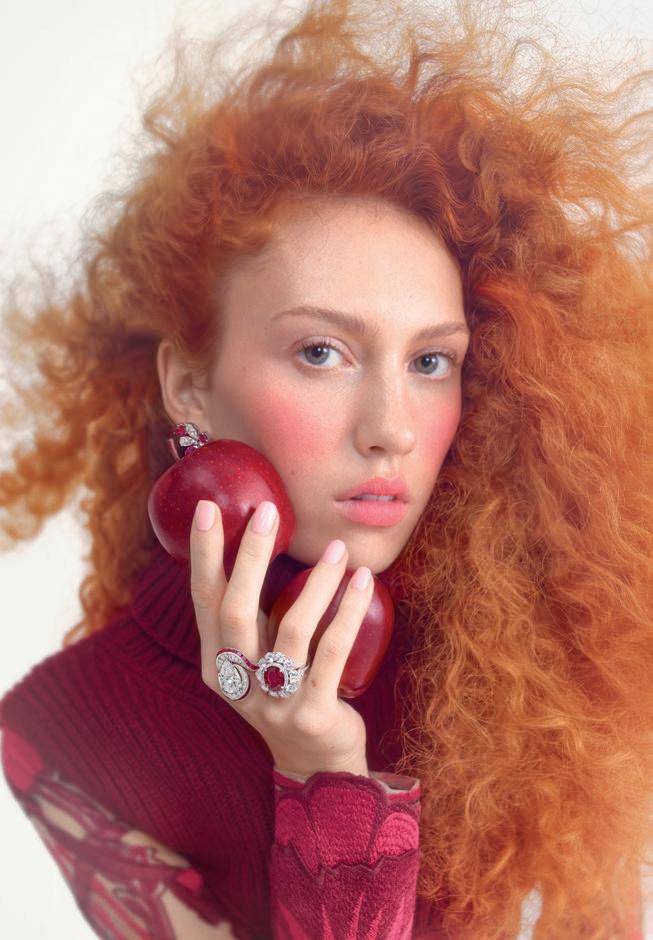



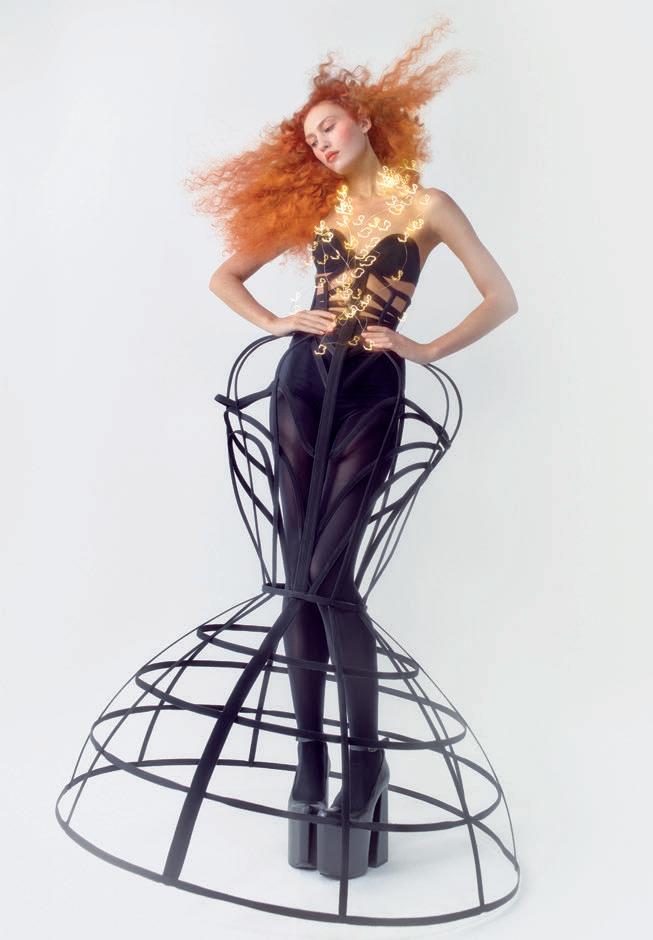
TEAM
Make-up:
Cosmetics
Hair:

Casting:
Video:
Tracer
Photographic
Digital:
Lighting
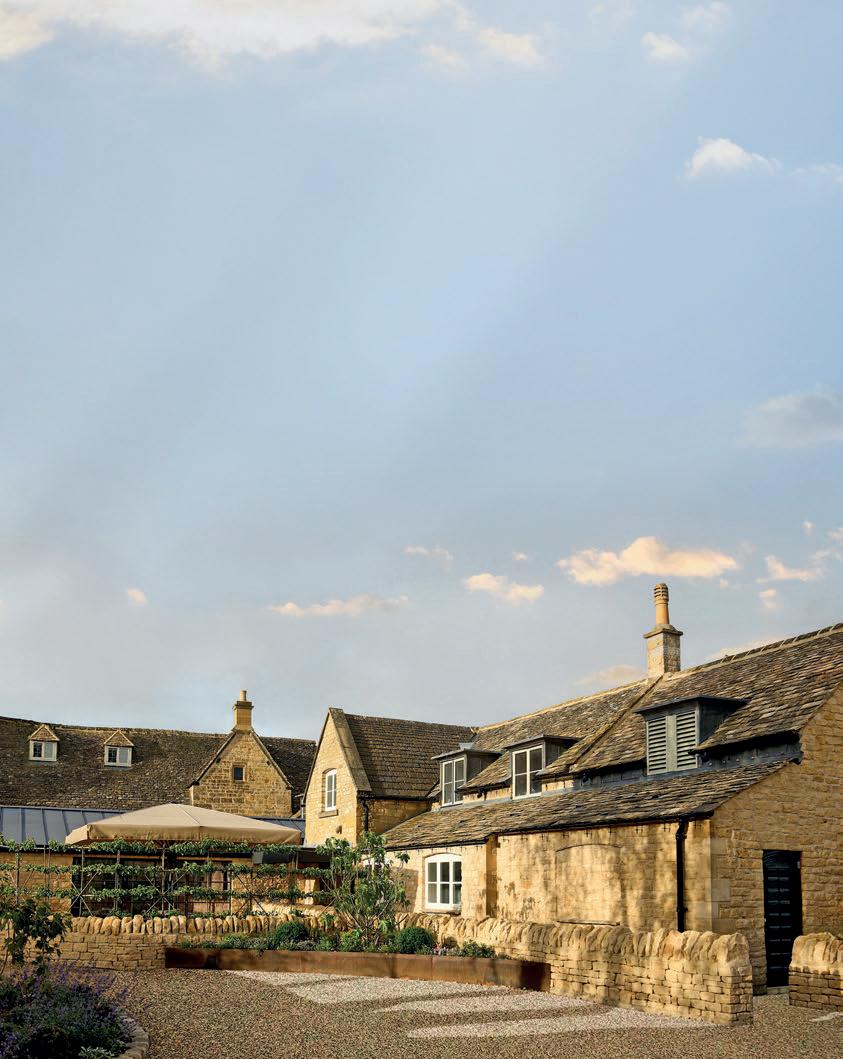
The retail visionary behind Next, George at Asda, and Per Una, George Davies, has turned to hospitality for his next venture – opening House of George in the Cotswolds. Jane Knight spends the night
This has long been a village that inspires. With its honeyed streets and rolling hills, the Cotswolds village of Broadway became the stage where artists, writers and musicians gathered at the close of the 19th century. John Singer Sargent captured the dusk in Carnation, Lily, Lily, Rose here, Francis Davis Millet painted Between Two Fires at Abbots Grange (now a delightful B&B), and William Morris used the folly of Broadway Tower as a summer retreat with his Arts and Crafts friends. Later, in the 20th century, Gordon Russell built his furniture design empire in the village after his father bought e Lygon Arms.
Now another creative has set up shop. George Davies – the visionary behind Next, George at Asda, and Per Una for Marks & Spencer – has just opened a ten-room hotel on the High Street, bringing a fresh ourish of design and imagination to a village that clearly celebrates artistry.
A nd yes, the House of George W Davies is every bit as stylish as the fashion empire its namesake created. e 17th-century building, its exterior set o by lavender and bay, might look pure Cotswolds on the outside, but inside it’s a di erent story – a masterpiece of contemporary cool.
Step from the busy pavement through the ancient doorway and the rst thing you see is the bar with its curved brass counter, modern art splashed across exposed stone, a zig-zag rug breaking up pale wooden boards. Further on, the restaurant feels bare in comparison, its white tables highlighted by splashes of colour in the form of pale green banquettes and a glass wall sculpture. Even the sta uniforms are part of the pinky-green general palette: oral shirts for the women, green stripes monogrammed with Davies’ initials for the men.
‘ e men’s shirts were inspired by a gift from a long-ago girlfriend,’ Davies reveals. ‘I loved that shirt.’ We’re sitting in the snug – squishy sofas, an eye-catching striped rug on the oor, a replace big enough to roast an ox – along with his fourth wife, Arlene.
A fter decades shaping high street fashion, Davies is after a new challenge. ‘I’ve done so much in retail all over the world,’ he tells me. ‘Now it’s time for something di erent. I’m always looking for risk and excitement.’
Not that this village of 2,500 souls is short on places to stay. Among its o erings, the Lygon Arms, where Charles I and Cromwell both slept (on separate occasions), is just down the street; Farncombe Estate has three boutique boltholes nearby.
So why open yet another hotel in what is
already a tourist honeypot? ‘It’s all about the social side for me – I love talking to people. is is like an extension of my home,’ says Davies. at home, for more than 30 years, is just outside Broadway, where Davies already owns a property portfolio so expansive I suggest that the village, named after its wide, long High Street, should be renamed Georgeway. He grins at the idea.
Davies was already landlord to everything from a orist’s and bridal boutique to an art gallery, clothes shop and restaurant when the old doctor’s surgery came up for sale. He snapped it up for almost £2m before embarking on an almost fouryear transformation, working simultaneously on the George apartments, which opened in April (think George at Asda rather than Per Una in terms of style and price).
Hospitality was new territory, but Davies knew one thing mattered above all: detail. Which is presumably why his HG monogram pops up at the end of the loo roll as well as on hangers, key fobs and water bottles. ‘Detail translates from retail to hospitality,’ he says. ‘I can see something that needs amending before others.’
Much of the legwork fell to Arlene, alongside designer Laura Cole. ey shaped the bedrooms – six tucked beneath beams and eaves up steep stairs that Davies, at 83, nds tough going, plus four more in a new annexe.
A rlene calls the look ‘modern comfort with a bit of sophistication. Not your typical Cotswold twee or Daylesford shabby chic’. She’s right. My room, with beams and exposed stone, comes with a TV hidden in a fabric box at the end of the bed and handmade Rothschild & Bickers glass lights. Best of all is the cushioned window seat, framed by shutters in Rapture & Wright’s hand-printed fabric. From here, I gaze out at Broadway’s High Street, with the thatched Cotswold Chocolate Company straight across the road and the distillery, with its Cotswold gin and whisky, a few doors away.
It’s a street crying out to be explored, so I set o to peruse the independent shops. ere’s plenty to tempt, from a leather armchair in Catesbys, e Art of Living (£795) to a four-bottle
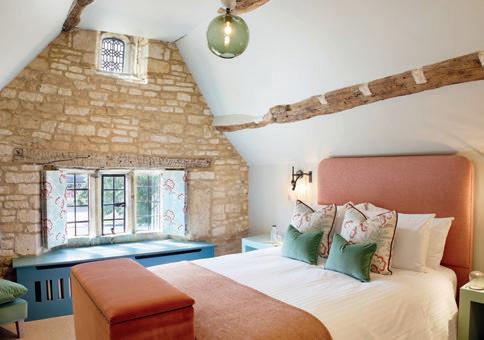
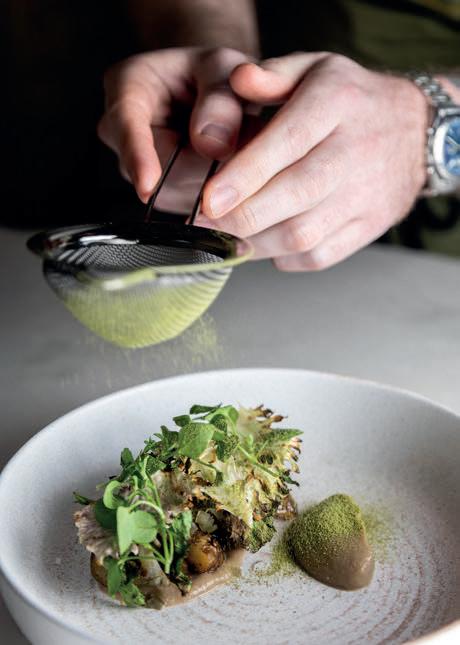
Veuve Clicquot champagne cooler at Woodcock and Cavendish (yours for £199.95). e Broadway Deli, all agstones and creaking stairs, almost has me beaten with its gleaming pies… but I resist.
Later, I’m glad I held o as I tuck into James Wilson’s tasting menu at the House of George’s Moda (whose name, like the hotel’s, references Davies’s fashion pedigree). e British dishes with a Nordic in uence are clearly worthy of a Michelin star. ink courgette and basil soup accompanied by honey-milk bread with fennel pollen and lobster with corn velouté, among a procession of delectable dishes. e one that really impressed was the pudding: an elder ower tart with sheep’s yoghurt, lemon curd and olive oil. It was pure brilliance.
Plans are already in motion for a kitchen garden, then a farm and cookery school – making the House of George even more of a foodie hotspot.
A few tables away, some locals are in as much gourmet heaven as I am. In fact, it’s Alan Frimley’s fourth visit in little more than a week. ‘ e food here is the best in the village, as is the service,’ he says, gesturing to Anthony Au Yeung, the ever-present operations manager who previously worked at L’Atelier de Joël Robuchon Hong Kong. Does he worry about yet more tourists ooding this Cotswolds hotspot? ‘We love the High Street being busy,’ he says.
e next morning, I take one last walk, tackling a hill so steep that stagecoach passengers once had to get out and trudge beside their horses. My target is Broadway Tower, an 18th-century folly of turrets, balconies and gargoyles. From the top, they say you can see 16 counties. William Morris stayed here, taking baths in a tin tub on the roof (there were no bathrooms).
e tower has always drawn creatives and dreamers, from Morris, who started his campaign for the preservation of historic monuments there, to the painter and poet Dante Gabriel Rossetti. It seems tting, then, that Broadway’s newest creative has left his stamp on the village too. ankfully, the House of George just down the hill o ers considerably better plumbing, along with plenty of panache.
BOOK IT: B&B doubles cost from £250 a night (houseofgeorge.uk). n
Plans are in motion for a kitchen garden, then a farm and cookery school – making this even more of a foodie hotspot’

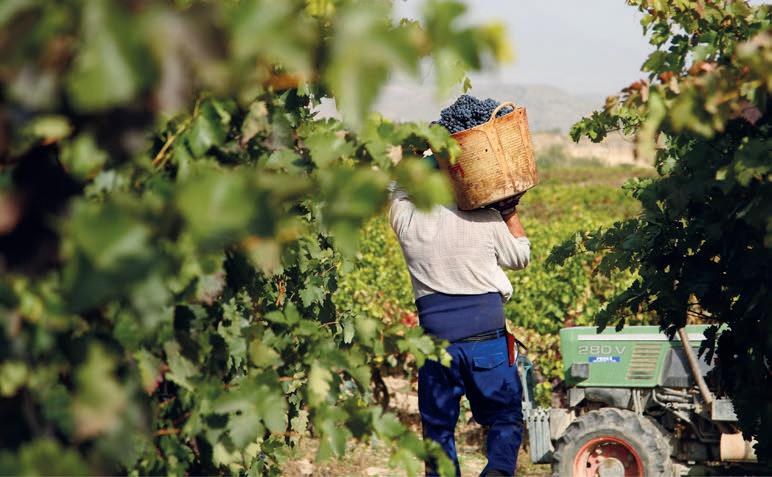
In the rolling hills of La Rioja, CLOS CIEN offers something rare – the chance to become custodian of a vineyard and craft your own limited-edition wine under the guidance of master winemakers.
Founded on a simple idea – that vineyard stewardship should be both accessible and extraordinary – CLOS CIEN blends old-world craftsmanship with modern expertise. Members work with master winemakers, agronomists and sommeliers to decide on grape variety, harvest timing and blending, creating wines that reflect their own palate.
The Origin Membership offers 500 sq/m of premium vines and an annual yield of 132 bottles – a way to learn the craft at an intimate scale. The Estate Membership extends the experience: 2,000 sq/m of vines producing 528 bottles each year. Ideal for small groups or businesses, it even allows for bespoke labels, turning each vintage into an elegant expression of identity.
But what truly sets CLOS CIEN apart is its community. Members gather for harvest celebrations, tastings and dinners among the vines. A partnership with the University of La Rioja opens access to courses and expert talks, while the estate’s forthcoming restaurant, hotel and spa promise a deeper immersion in vineyard life.
Whether you see it as an investment, a creative pursuit or a legacy to pass on, each bottle you create at CLOS CIEN tells its own story of land, time and taste.
Discover more at closcien.com. Origin and Estate memberships available from €5,000 initiation and €3,900 annual dues. n
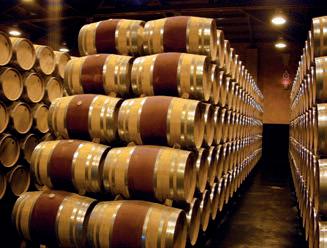
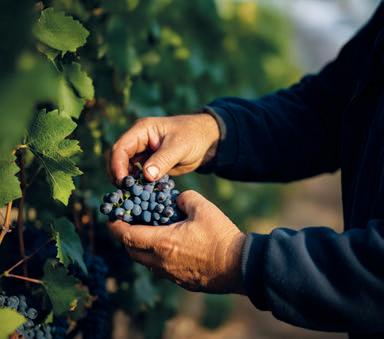
Climate action feels shoved to the back of the room right now– but we’re telling the story all wrong, argues Rob Hopkins, who says rekindling our collective longing for a better tomorrow can unlock momentum
Those heady days of Extinction Rebellion and Fridays for Future, of streets full of people demanding rapid action on climate change, feel like a long time ago. at feeling of the Overton window shifting, of the climate emergency being discussed across the media, being taken seriously, of local authorities everywhere declaring Climate Emergencies, has been swept aside by a new sense of pessimism, the rise of ideas we had very much hoped were consigned to history, and the closing down of possibilities. Despondency and exhaustion stalk the land.
W hile it is worth reminding ourselves that oil and gas, plastics and other companies have spent a huge amount of money to bring this about by funding disinformation campaigns, paying o governments who then defund climate science and proudly proclaim it is no longer a problem, it is also clear that climate activism needs some fresh thinking right now. You care about this stu , I know you do. It’s just that it’s so hard to gure out where to direct our energy.
For years, my work has been focused on the Transition movement, a bottom-up, community-led response to the climate emergency. Up and down the country, and in 49 other countries too, communities continue to come together to create community energy companies, new food systems, new local businesses, street-by-street energy conservation projects, planting food forests and community gardens and so much more. ere may well be a Transition group where you live.
But over time a new question has arisen for me, one that is so insistent, and which makes me so curious, that it has shifted the direction of the work I do. It began when, in 2021, I saw a T-shirt a young woman was wearing at a Black Lives Matter protest in the US which read, ‘I’ve Been to the Future. We Won’. It gave me goosebumps. Perhaps it’s giving you goosebumps as you read this. It felt to me like it contained the essence of a very di erent approach. Just talking about collapse and extinction, presenting people with information to motivate them to act, these things don’t cut it anymore. ey aren’t working at scale. e question that comes up for me is this: what would our activism,

What if we were able to bring to life the future in a way that was so delicious, so irresistible, that we create a new
our working towards change, look like if we were to see its primary objective as the cultivation of longing? What if we saw the objective of our work as helping people to fall in love with a future that could come from our doing everything we could possibly do to address the climate and ecological crisis? As novelist Don DeLillo once wrote, ‘longing on a large scale is what makes history’.
Longing is an incredibly powerful human emotion. e process that led to Neil Armstrong setting foot on the Moon started, it could be argued, not with JFK announcing the Apollo mission, but with Jules Verne writing From the Earth to the Moon in 1865. is thrilling tale inspired other writers and also scientists and engineers to storytell about how we might get to the Moon and what we’d do once we got there. ere were lms, comic books, dances about going to the Moon. Mickey Mouse went there, as did Popeye and Tintin. Science writer Michael Benson wrote that ‘most major achievements, be they personal or collective, arrive after rehearsals […] an entire branch of speculative ction – novels, short stories and also feature lms – lies behind the rst human footprints on another world’. With the climate emergency we don’t have 100 years to gure this out, but the same principle applies. ere are political voices right now who will tell you that Net Zero will be too expensive; would not work anyway; and depends on technologies that don’t work (only partly true, but there are nuances). But what if we were able instead to bring to life the future that would result from our doing everything we possibly could, in a way that was so delicious, so appealing, so irresistible, that we create a new North Star for people?
A future in which, in our cities, we have built such amazing cycling infrastructure and free public transport that there would be absolutely no point in owning a car. A world of bicycle rush hours and so many underground car parks repurposed as bicycle storage spaces that, just like we did for cars back in 2025, we now need digital display boards showing where the free spaces are. A world in which no child goes hungry, in which access to good, sustainably produced food is recognised as a universal right, and where every city is building a ‘food belt’ around itself.
A world in which we see much less ooding because we developed the humility to recognise that beavers are far better hydrological engineers than human beings could ever be, and we handed back to them upland areas where ood waters come from. In return they created an explosion in biodiversity, drew down huge amounts of carbon and created a bu er against re and drought. A world in which most of our energy comes from renewable sources, fossil fuel companies are going out of business one by one, and as communities we bene t from the large percentage of that renewable energy that is in community control. A world in which much of the economy is now dedicated to regenerative businesses and regenerative agriculture, and one where that horrible feeling in the pit of the stomach so many of us experienced in 2025 – of going to work for a company whose activities are eroding our children’s chances of a liveable future –has long since disappeared.
It’s a world that smells amazing. It’s a world in which, unlike back in 2025, there’s a look in people’s eyes, a sense of excitement, of possibility, a sense of ‘I think we might just do this’. People can see the world around them changing rapidly, the mental health of young people improving, the natural world bouncing back, and are exhilarated by what they see. Climate change hasn’t disappeared, and yes, we have still lost much that we can’t replace, but we are on the best possible path, throwing everything we possibly can at this, and experiencing a great renaissance as a result.
Feels a bit di erent than if I had just spent the previous 800 words talking about collapsing ice sheets and CO2 levels, doesn’t it? We have very little time left to avert the worst-case scenarios. We need all hands on deck. is is no time to be a bystander. How might you, at the place you work, on your street, in your community, bring the future you long for to life, in conversations, in art, in the stories you share, in the activism you do? Science- ction writer Ray Bradbury once wrote that ‘it’s part of the nature of man to start with romance and build to a reality’. Imagine the future you want, then go build it, one neighbourhood, one street at a time.
So what might this look like? Bannau Brycheiniog National Park recently built a ‘time machine’, a repurposed mobile planetarium, to invite people to step into alternate futures, and are now passionate advocates for other local authorities doing the same. At the Abergavenny Food Festival, a group of campaigners made a meal from the future, a vision of the future that worked with the taste buds, not just ideas. You could learn how to facilitate Open Space events and invite your community together to explore the future they’d most like to see, as well as make moves towards achieving it. Start a Transition group. Begin the process of bringing empty buildings into community ownership. Start a community energy company. Look to the work being done in Liège in Belgium to build a ‘food belt’ around the city and start taking the rst steps towards it yourself. Host a ‘Town Anywhere’ workshop, an incredible day-long activity developed by Ruth Ben-Tovim which invites people not just to imagine the future but to step into it and literally build it with cardboard, sticks and sticky tape. As US prison abolitionist Mariame Kaba puts it, ‘we must imagine while we build, always both’. n


As the festive season approaches, Mike Dickson reminds us that our greatest gift is kindness
There is hope in these dark and dangerous times, when the world – nationally and internationally –feels full of challenges and the news is relentlessly grim. e hope lies with us. Small actions matter.
It’s our time to step up, come alongside and care for each other – people we know and people we don’t. I learned this 35 years ago when a simple ‘yes’ changed my life and, unexpectedly, led to a better life for many others.
Don’t wait for someone else to x things. Ask how you can shift the dial by pausing, listening and showing up with a little love and care. e wonderful thing is that you’ll feel better about life when you do.
‘Be kind, for everyone you meet is ghting a hard battle,’ said Plato. He was right: we’re all insecure and anxious – me included. We wouldn’t be human if we didn’t worry about our relationships, families, work, nances, health and more. Not all of them all the time, but certainly some of them much of the time. Everyone you know has down days, hits bumps, loses their bounce and sometimes becomes depressed. We all need help from other people.
If you’re not convinced, think of your three closest friends –people you know really well. How are they, really? Outwardly, they may look as if they haven’t a care in the world, but I’d suggest each is worried about something important that’s a ecting their life. If that’s true for them, it’s true for everyone: your friends and
family, colleagues, neighbours, the people at every party, bar, café and restaurant. Everyone is carrying something.
But there is hope – and the hope is us. We can make a personal, signi cant di erence, and an even stronger one if we act with friends. ink of the last time someone helped you and how surprised and grateful you were.
It’s natural to care about others, the natural world and the desperate plight of people in war zones and disaster areas. We want a better world, and it starts with the direct impact we can make. We can improve our own lives – and the lives of others – by listening, drawing near and actively helping, and by supporting those already helping. Use your people skills and your heart. A community doesn’t need to be big – it needs honest, open support among its members. Find your tribes and nurture them.

If you’re a C&TH reader, you’ll have your share of challenges like everyone else. But you are also likely to be enormously fortunate – even blessed – and in a special position to change the world, certainly your part of it. Start today.
How to be a Better Human by Mike Dickson is published by Byline Books. £9.99 n






What makes a design last generations? Is it exceptional craftsmanship? Is it honest materials? Is it timeless design? For us, it’s all of these.
at’s what makes a Neptune home.

In a climate where both British pubs and farming are under threat, three friends are rewriting the rules – growing their own produce, championing small producers and reviving the pub as the true heart of the community, says Fleur Britten
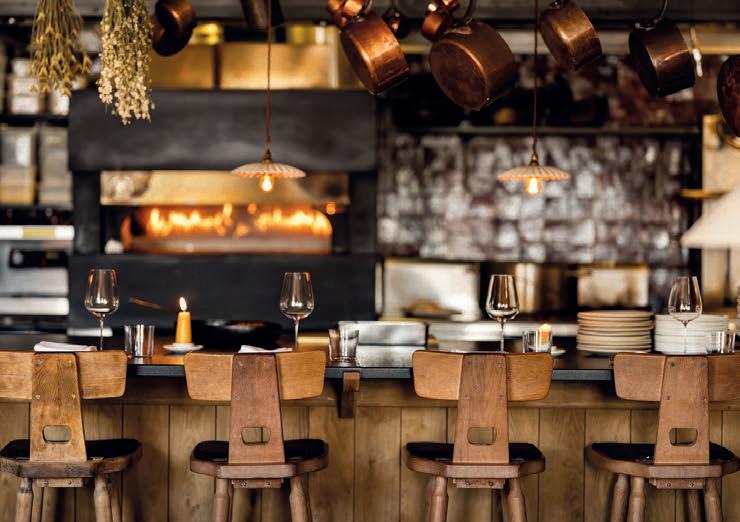

I’m standing in a potato patch in the Cotswolds, admiring some bountiful spud plants nestled in sheep’s eece. e three varieties – Arran, Cara and Duke of York – are ‘an experiment for George at the Fat Badger’, explains their grower, omas Jones. e eece, which helps the soil retain moisture, is one of the many natural methods Jones uses – as well as ‘no dig’, no chemicals, cover crops and companion planting – to ensure that the three acres here (on which he also grows tomatoes, cucumbers, salads, courgettes, beans, beetroots, peas, kale, squash, herbs, garlic, apples, plums) are farmed regeneratively and organically, albeit not certi ed.
George Williams – who is head chef at one of the ve buzzy and highly acclaimed pubs run by the Public House Group, set up by friends James Gummer, 35, Phil Winser, 41, and Olivier van emsche, 49 – is some 80 miles away in Notting Hill, but even he has been down to help out. Williams, you see, has been questing for the perfect potato to make Hasselbacks, so after he researched it, Jones grew it on the smallholding, which is run by the friends to supply the ve pubs. is is the level of commitment they’ll go to for the perfect ingredients.
‘And when a customer says “these are the best Hasselback potatoes”, the team feels like they were there from beginning to end,’ says Gummer, with whom I’m now drinking herbal tea along with Winser in the cafe at Henry Astor’s Bruern Farms, where they rent the land. (Van emsche is on holiday.)
Winser has driven us to the farm from another of their pubs, e Bull, 15 minutes away in Charlbury, in e Bull’s glossy black Defender. is year the pub was named National Pub &

‘We don’t get involved in politics or celebrity; we just focus on serving pints and hoping it’s a nice experience’
Bar of the Year, and has repeatedly been in the news recently –much to the founders’ distaste – not only for hosting Kamala Harris for dinner before she attended Eve Jobs’ Cotswolds wedding, but also for having allegedly turned away JD Vance because its sta refused to serve him. ‘It’s genuinely just noise,’ Winser shrugs. ‘We don’t get involved in politics or celebrity; we just focus on serving pints and hoping it’s a nice experience.’ eir growing pub portfolio also includes e Hart in Marylebone, which opened this autumn, e Hero in Maida Vale, and their OG venture, e Pelican in Notting Hill, opened in 2022; coming next year is e Coach & Horses in Clerkenwell. ( e Cotswolds connection is because Gummer and Winser both grew up near Charlbury – Winser was friends with Gummer’s older sister.)
Growing their own produce is part of the friends’ bigger, more radical mission, namely to support two struggling British industries – pubs and farming – so that each can help the other. Last year, a record 6,365 agriculture, forestry and shing businesses closed, according to the O ce for National Statistics, while 412 pubs in England and Wales served their last pint (according to Altus Group) – a rise of nearly seven percent compared to 2023. Even Heston Blumenthal is campaigning for the government to help protect British pubs, calling for urgent action with policy and tax reforms.
‘ ese businesses are disappearing at such a crazy rate,’ says Winser, as he tops up my mint tea. ‘So it’s about how we can connect the two.’ e solution came to him mid-pandemic after he almost bought a farm, having shuttered his sceney restaurant e Fat Radish in New York City (another Covid casualty). His due diligence was epiphanic – Winser realised that the way to make a farm nancially viable was ‘to sell direct to restaurants’. So when Winser and Gummer – the latter of whom founded the restaurant 7 Saints – opened e Pelican, with Van emsche overseeing the nances, the pair went straight to the UK’s ‘incredible’ small producers, who ‘can’t a ord to be part of the traditional food distribution system’, says Winser. ‘Buying it direct has a triple e ect: it’s great for the bottom line, the food is fresh and tastes really good, and it helps the bigger picture.’
are agships to the local area – they’re neighbourhood hubs.’ In order to look after their local community, they keep tables free for walk-ins. ‘It’s important to us that you can decide last-minute on a Friday night to go to your local,’ says Gummer. ‘It’s all about building those relationships.’ e business partners are also currently establishing Pub Club, a social enterprise that trains local school leavers on 12-week paid internships, helping them build con dence and get a leg up into the hospitality industry.
In fact, the entire operation seems to be built on relationships as opposed to ego. ‘It’s a team e ort,’ insists Winser. ‘You have to let go of ego across the board’ – which aligns with British pub philosophy, where no one is any better than anyone else. Right from the start, their ethos has been only to work with ‘the kind of people we’d want to have a pint with’, Winser adds. ‘We’ve tried to build that into everything we do.’ What’s more, you won’t nd egotistical, che y fussiness coming out of the kitchen. It’s a beautifully simple, produce-driven menu: for example, at e Bull, lamb sweetbread with slaw, pork chop with crushed peas, sirloin. Robust, homely dishes, cooked so that the ingredients sing, and in portions big enough to share – all very on-message. Currently, e Bull is the only one of the group’s pubs with rooms, and its ten suites are beautifully decorated with the same philosophy: it’s all about supporting UK manufacturers. e beds are handmade by ‘an amazing metalworker in Somerset’, says Winser, who does all the design himself; the blankets are ‘from an amazing wool mill’; and on the walls is British lime wash: ‘We tried not to use any paint anywhere.’ e decor is pared back, full of natural materials and colours, and incredibly calming – just the thing for unwinding after being in the place to be. n
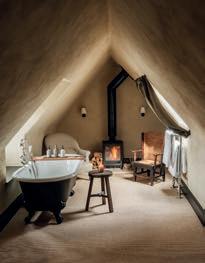
R ight from the start, the business partners bought whole animals, explains Gummer: ‘ at’s where the idea of mince on toast came from.’ It is ‘by far’ their bestseller, even though it’s made with o -cuts. ‘Isn’t that amazing?’ he adds. ‘People don’t realise that by buying our mince on toast, they’re validating our approach.’
Given the boys’ starry connections – Winser used to date Dree Hemingway; Gummer is son of life peer and Tory donor Peter Gummer, Baron Chadlington; and their venues are frequented by minor royals, former prime ministers and the A-listers du jour – it’s revealing that they’ve focused on the humble pub, not, say, chichi hotels or members’ clubs. But their passion for the British institution seems genuine. ‘Pubs were designed centuries ago to be hospitable, to give people an amazing experience,’ says Gummer. ‘ ese big corner sites
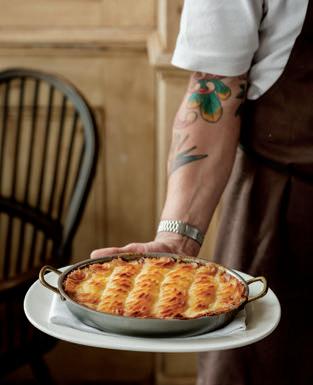

Pared-back and painterly in Paris
FASHION EDITOR URSULA LAKE
PHOTOGRAPHER CHLOE MALLETT





OPPOSITE:





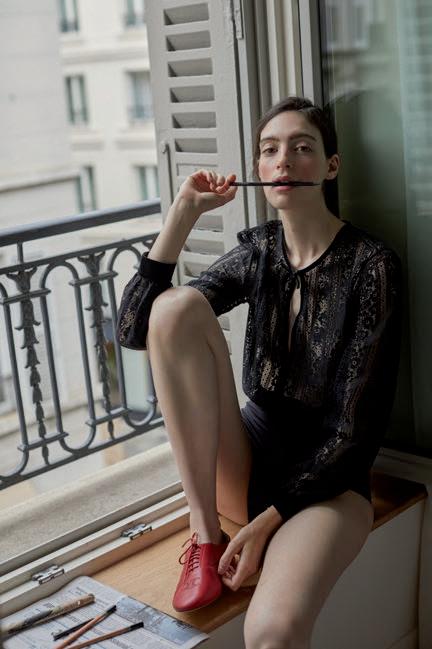
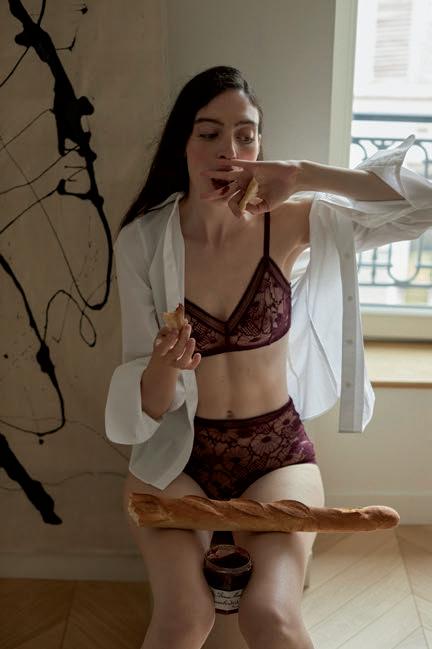

TEAM





Maison de parfums d’intérieur eu.baobabcollection.com


















Take inspiration from 2025’s most popular binge watches for your Christmas gift-giving







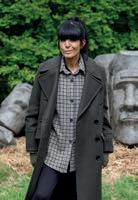






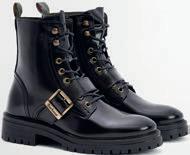









Effortlessly evil castle-chic






1 Really Wild Balmoral tweed cape, £895, reallywildclothing.com. 2 Victoria Beckham Satin kajal liner, £32, victoriabeckhambeauty.com.
3 Bryan O’Sullivan Studio Stamp oak burr stool, £POA, bryanosullivan.com. 4 Bucherer Gold link bracelet, £8,800, bucherer.com.
5 Holland Cooper Wool tartan trousers, £299, hollandcooper.com. 6 Le Chameau Vierzonord neoprene-lined wellies, £250, lechameau.com.
7 Cambridge Satchel e Isla leather bag, £160, cambridgesatchel.com. 8 Purdey Tom Purdey tweed hot water bottle, £495, shop.purdey.com.
9 Floris London Cinnamon and tangerine scented candle, €121, orislondon.com. 10 Chloé Agnes lambskin loafers, £770, chloe.com.
11 House of Bruar Black Watch tartan short kilt, £159.95, houseofbruar.com. 12 Cordings Fairisle lambswool jumper, £169, cordings.co.uk. 13 Johnstons of Elgin Cashmere wrist warmers, £90, johnstonsofelgin.com. 14 Barbour Ouseburne biker boots, £145, barbour.com.
Are you a faithful or a traitor? The Traitors: Live Experience invites players to spin their own web of strategy and deception before taking a seat at the round table, where all is revealed. From £30.50pp, thetraitorslive.co.uk







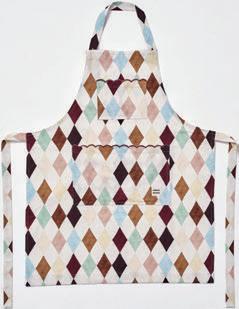




A heady cocktail of culinary sophistication




1 Smeg x Dolce & Gabbana Sicily Is My Love toaster, £599.95, shop.smeguk.com. 2 Linley Damascus knife set, £3,500, and zig-zag chopping board, £350, davidlinley.com. 3 N Peal x Stanley Tucci Tucci travel socks, £95, npeal.com. 4 Jo Malone Ginger biscuit cologne, £128, jomalone.co.uk. 5 Summerill & Bishop x Solange Hot Lips napkin ring, £315, summerillandbishop.com. 6 Swaine London Melange wool tweed cap, £220, swaine.london. 7 Edward Green Polperro calf suede loafers, £550, edwardgreen.com. 8 MG&Co Fish matchbox sleeve, £60, matildagoad.com. 9 Damson Madder Scallop apron, £36, damsonmadder.com. 10 Rolex Perpetual 1908 automatic watch, £30,600, rolex.com. 11 Toogood e Scholar tie, £115, t-o-o-g-o-o-d.com. 12 Bennet Winch Italian suede backpack, £1,325, bennettwinch.com.
Learn to make fresh pasta and speak Italian in one go at Eataly’s La Scuola cooking school in Bishopsgate, which also has pizza making classes, wine and parmesan tastings and a truffle festival. From £68pp, eataly.co.uk












Privilege and perfectly poured champagne




1 Olivia von Halle Amaya Ziegfeld cotton-silk robe, £390, oliviavonhalle.com. 2 Giovanni Raspini Blue Ivy crystal necklace, £780, giovanniraspini.com. 3 David Morris Fortuna eternity ring, £8,600, davidmorris.com. 4 Neal’s Yard Remedies Ultimate Sculpt Icons cleanser, lift cream and gua sha gift set, £124, nealsyardremedies.com. 5 Bordelle eia basque, £759, bordelle.co.uk. 6 Dr David Jack Stellar Meso Renew eye cream, £95, drdavidjack.com. 7 Freya Rose Cher Verde mother of pearl block heels, £995, wolfandbadger.com. 8 Gra Laurence Gra Signature pavé diamond bangle, £9,450, gra .com. 9 Dom Pérignon Vintage 2015 Takashi Murakami champagne, £230, selfridges.com. 10 Richard Mille RM 63-02 automatic watch, £POA, richardmille.com. 11 Buccellati Étoilée pendant earrings, £7,800, buccellati.com. 12 Assouline Mustique Icon, €105, assouline.com.

Consider Christmas shopping at the world’s first ethical department store. Founded by The Green Coach, Lucy Johnson, the platform features over 65 independent brands across six departments. lovebrookandgreen.com






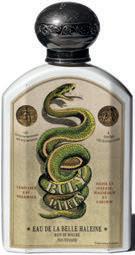


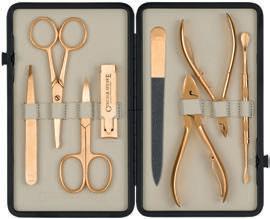

A penchant for the finer things






1 Crockett & Jones Everest leather boots, £695, crockettandjones.com. 2 Czech & Speake Gold manicure set, £545, czechandspeake.com. 3 Turnbull & Asser Tomorrow Never Dies James Bond silk tie, £225, turnbullandasser.co.uk. 4 Farrar & Tanner Mount Royal double hunter pocket watch, £110, farrar-tanner.co.uk. 5 Favourbrook Sherbourne wool scarf, £195, favourbrook.com. 6 Lalique Wingen crystal decanter, £1,400, uk.lalique.com. 7 New & Lingwood Skull and crossbones velvet slippers, £375, newandlingwood.com. 8 Cassandra Goad Agricola bloodstone signet ring, £1,395, cassandragoad.com. 9 O cine Universelle Buly Eau de la Belle Haleine mouthwash, €35, and Opiat Dentaire mint toothpaste, €20, buly1803.com. 10 Dunhill Moire Rollagas lighter, £1,375, dunhill.com. 11 Oliver Brown Carlyle velvet jacket, £595, oliverbrownlondon.com. 12 Katharine Pooley Brass and green malachite trinket box, £720, katharinepooley.com.
The Guinness Open Gate Brewery – an experimental brewery dating back to 1904 – reopens in Covent Garden, offering exclusive tastings with the master brewer and immersive experiences. opengatelondon.guinness.com


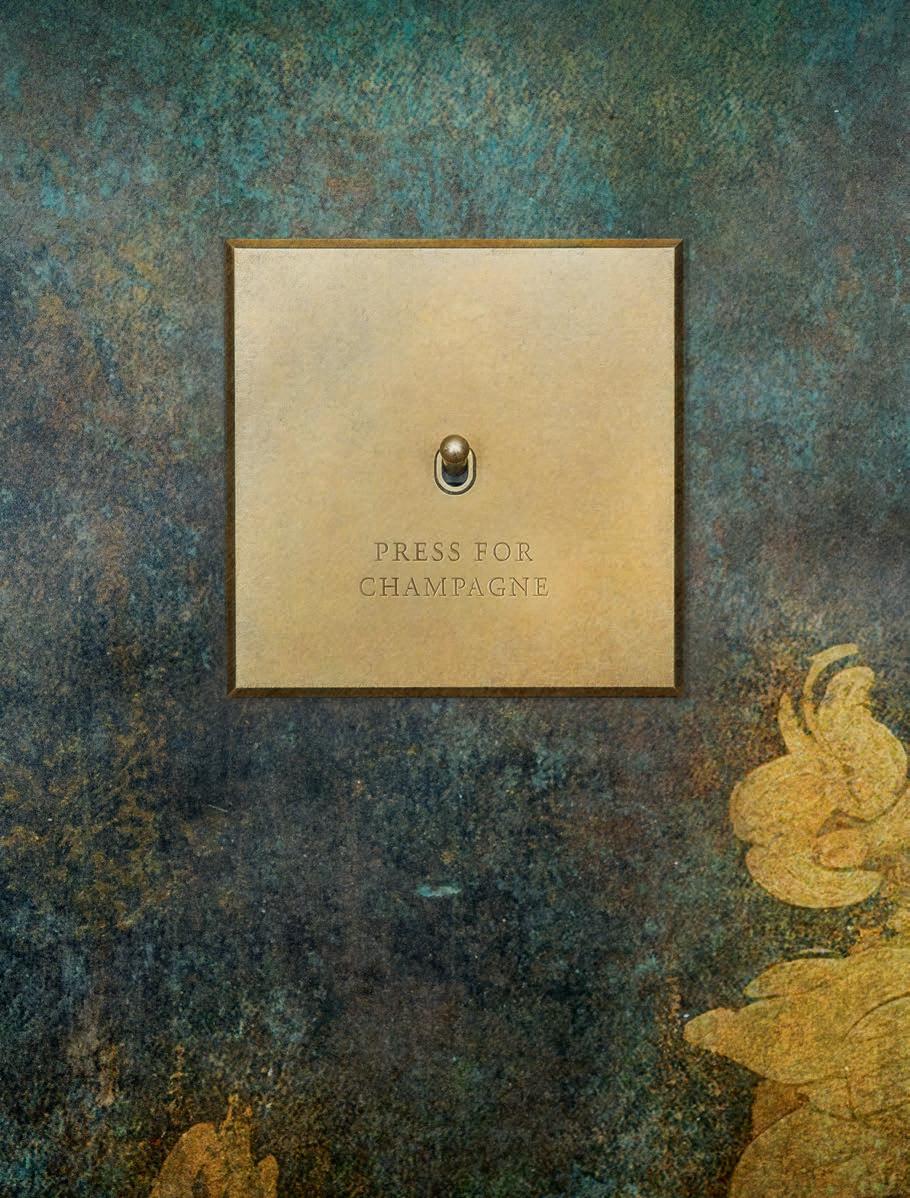
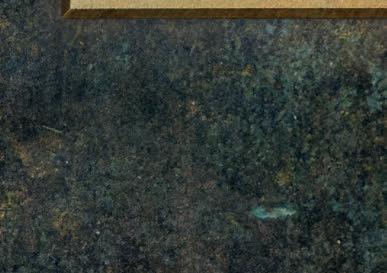














Feeling suitably at home on the ranch







1 Westley Richards Exmoor trilby hat, £295, westleyrichards.com. 2 Indigo Antiques Vintage hand-embroidered suzani throw, £425, indigo-uk.com. 3 Commune Seymour hand cream, £35, commune.cc. 4 AKYN Love oyster jumper, £420, akyn.com. 5 Asprey Woodland pine cone gold and diamond charms, £3,750 each, asprey.com. 6 Hermès Cavale II jumping saddle, £6,400, hermes.com. 7 Oka Troupeau cushion cover, £80, oka.com. 8 Chapman Troutbeck 16 shing bag, £260, chapmanmade.uk. 9 Buchanan Studio Cowhide chair, £8,995, buchanan.studio. 10 Penelope Chilvers Blanca suede cowboy boots, £369, penelopechilvers.com. 11 Farlows Sloane tweed wrap coat, £850, farlows.co.uk. 12 Herd Penrith tweed scarf, £195, herdwear.co. 13 Fumi Guillaume Delvigne log holder, £325, eldvarm.com.
Saddle up and go for a ride through Hyde Park along sandy paths and past the Serpentine with Mandarin Oriental. £1,3oo, for an overnight stay and private riding lesson for two, mandarinoriental.com/london
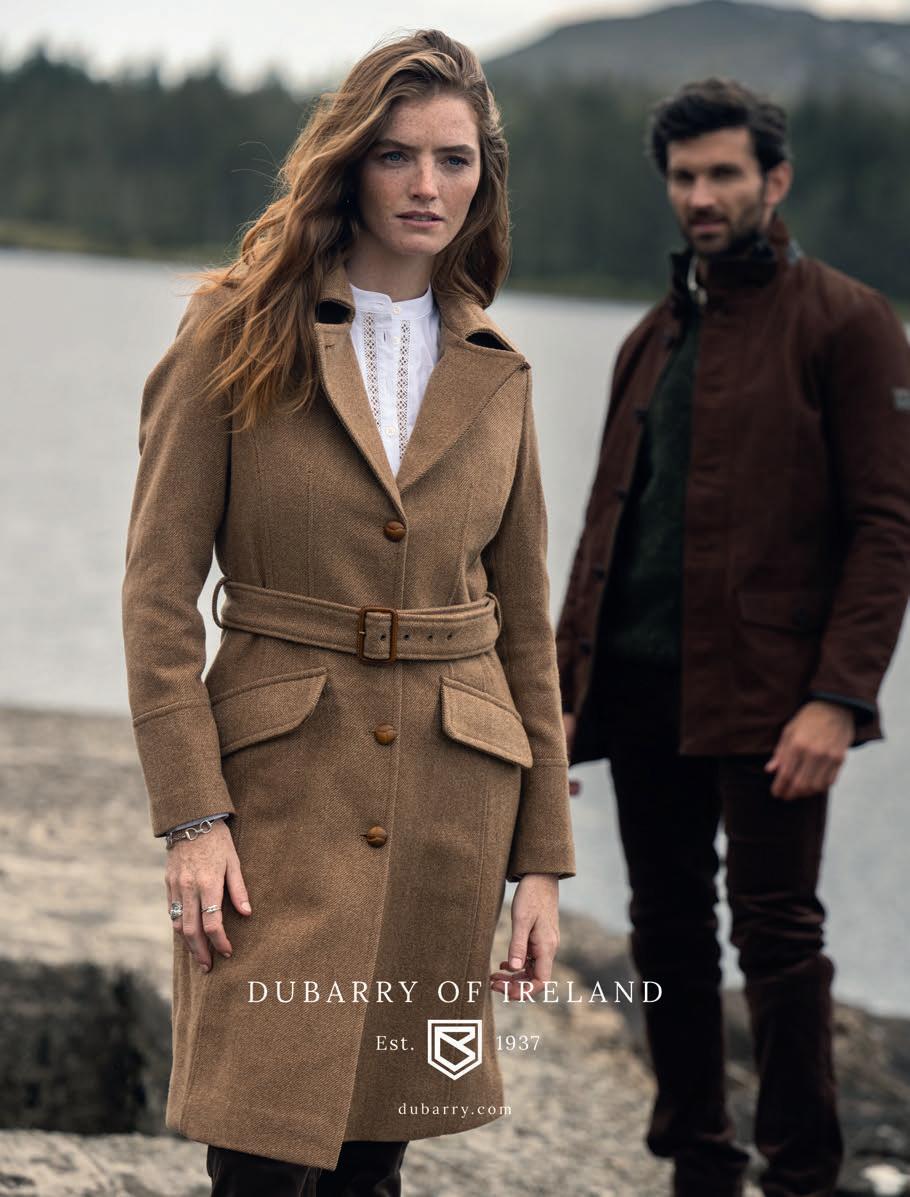









Call of the wild







1 Hästens Baby alpaca wool throw, £535, hastens.com. 2 Not Another Bill Personalised leather hip ask, £50, notanotherbill.com. 3 Finisterre Beardsmore organic cotton shirt, £95, nisterre.com. 4 Yeti Cayo all-weather backpack, from £200, uk.yeti.com. 5 Tudor Black Bay 58 automatic watch, £4,280, tudorwatch.com. 6 Troy London Italian suede gilet, £440, troylondon.com. 7 E J Churchill Hera leather cartridge bag, £524.40, shop.ejchurchill.com. 8 Claridge’s Art deco matches, £15, shop.claridges.co.uk. 9 Dubarry Laois leather ankle boots, £329, dubarry.com. 10 Begg x Co Isla blonde undyed cashmere jumper, £995, beggxco.com. 11 rudark Bastion down jacket, £450, thrudark.com. 12 e Glenturret Distillery Triple Wood 2024 Scotch whisky, £62 for 700ml, theglenturret.com.
Step into the workshop and take a hands-on woodworking class at West Dean in the South Downs. Short courses in anything from blacksmithing to botanical printmaking run year-round. From £74, westdean.ac.uk

Dine, unwind, or stay the night – one voucher, any PoB Hotel
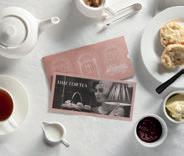
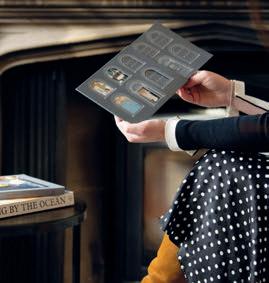
Pampers
Wonder-full wellness. Serene retreats. Gift some self-care with the Spa & Wellness Voucher. With access to PoB Hotels’ most serene spas, this voucher wraps the recipient in wellness, from soothing treatments to rejuvenating classes. Available in values of £100, £150, and £200, it’s ideal for anyone in need of a proper reset.
Locally sourced. Impeccably plated. The Dining Voucher is a golden ticket to an unforgettable gastronomic experience. Redeemable across the PoB Hotels collection, it’s perfect for food lovers . Choose from £100, £150 or £200 and give a gift – from relaxed lunches to indulgent dinners – that’s worth toasting.
Quintessentially British. Wonderfully indulgent. The Afternoon Tea Voucher is a celebration of the nation’s favourite ritual. Expect elegantly tiered treats, perfectly steeped brews, and a setting full of charm. Available in denominations of £50 and £75 for a moment of delicious tradition.
Curated luxury. Crisp linen. The new Overnight Stay Voucher is everything you’d expect from a PoB Hotels escape: a fabulous mix of character, comfort, and charm. This gift can be used towards overnight stays at any PoB Hotel and makes it oh-so-easy to plan an impromptu getaway or perfect weekend away. Go on, gift a little escapism, starting from £250.
Prefer to let them select their own adventure? PoB Hotels’ monetary vouchers offer the ultimate flexibility. Whether it’s a romantic break or longoverdue me-time, this is a gift that says: ‘You deserve this.’ Starting from £75 and sent in a stylish gift envelope or instantly, via email.
Buy the perfect gift at pobhotels.com/gift-vouchers







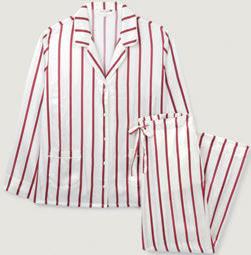





Negotiating love and friendship




1 Gucci 97 heeled leather mules, £785, gucci.com. 2 Mulberry Lily bag, £1,195, mulberry.com. 3 Claridge’s x Annoushka Foyer teapot diamond and tsavorite charm pendant, £4,900, shop.claridges.co.uk. 4 Dior White porcelain and gold mug, £480 for two, dior.com. 5 Armani Leather handbag with feathers, £2,800, armani.com. 6 John Lewis x Sanderson Tamizart cushion, £60, johnlewis.com. 7 Montblanc Happy Holidays stationery set, £POA, montblanc.com. 8 Philippa Herbert Sapphire, diamond and tsavorite zig-zag stacking rings, from £2,995 each, philippaherbert.co.uk. 9 Robinson Pelham Arena yellow beryl ring, £4,825, robinsonpelham.com. 10 e White Company Silk classic stripe pyjama set, £250, thewhitecompany.com. 11 Yves Saloman Wool satin maxi dress, £1,530, yves-salomon.co.uk. 12 Boodles Flamingo aquamarine and sapphire earrings, £23,500, boodles.com.
A gift membership to The National Gallery gives the recipient members-only previews and guided tours with the curators, both in-gallery and online, as well as free access to all exhibitions. From £68, nationalgallery.org.uk



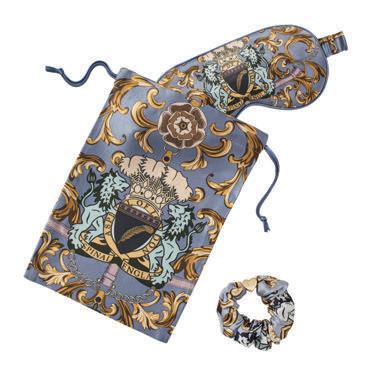






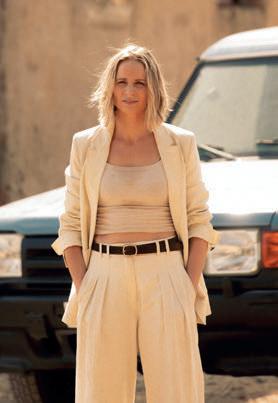
European sleuth chic





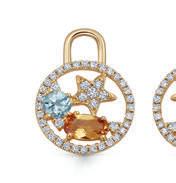


1 Ettinger Pursuits Cotswold bag, £825, ettinger.co.uk. 2 Andersen Genève Split Second Chronograph Worldtime manual watch, £174,650 (approx), andersen-geneve.ch. 3 Fope Eka Flex’it bracelet with diamonds, from £27,890, fope.com. 4 Tom Davies Isabella sunglasses, £330, tdtomdavies.com. 5 Burberry Silk scarf trench coat, £2,590, burberry.com. 6 Léoube Secret De Léoube rosé, €27.50 for 750ml, leoube.com. 7 Bramley Christmas Cottage bubble bath, hand cream, candle and calming pillow spray collection, £32, bramleyproducts.co.uk. 8 Kiki McDonough Fireworks citrine, topaz and diamond cluster drops, £1,900, kiki.co.uk. 9 Christy Cabana ice cream stripe towel, £15, christy.co.uk. 10 Globe-Trotter Centenary large handbag, £1,995, globe-trotter.com. 11 Grove Anemone eau de parfum, £120, grove-england.com.
12 A spinal Silk eye mask and scrunchie set, £85, aspinalo ondon.com.
Learn to think like a spy and be trained by elite intelligence operatives, analysts and special forces experts from agencies like the CIA, MI6 and the FBI over two days at a military base in Dorset. £785, spyq.co.uk
















WEDNESDAY
Channelling your inner goth




1 Stripe & Stare Shine Like A Star lace bra, £40, and knickers, £65 for four, stripeandstare.com. 2 Alexandra Llewellyn Skull poker set, £18,000, alexandrallewellyn.com. 3 MAC Cosmetics Cobalt eyeshadow, £20, maccosmetics.co.uk. 4 Artêl Cabinet of Curiosities snake decanter, £811, from Source at Personal Shopping, Design Centre Chelsea Habrour, dcch.co.uk. 5 School of Life Tote bag, £25, shop.theschoolo ife.com. 6 Stella McCartney Lace satin top, £650, stellamccartney.com. 7 Hancocks Disorient diamond ring, £125,000, hancockslondon.com. 8 Erdem Tulle midi skirt, £1,495, erdem.com. 9 Fornasetti High Fidelity Immaginazione candles, £150 each, fornasetti.com. 10 Lulu Guinness Cosmic satin zip pouch, £75, luluguinness.com. 11 Esska Birdie Black ankle boots, £195, esskashoes.com. 12 Harry Winston Ocean Date Moon Phase automatic watch, £POA, harrywinston.com. 13 Lisa Eldridge Rouge Experiencebohemian cherry re llable lipstick, £49, spacenk.com.
Weird history, humour and high jinks combine in these award-winning Edinburgh tours of graveyards, prisons and the haunted vaults and dark tunnels snaking beneath the city. From £22, cityofthedeadtours.com






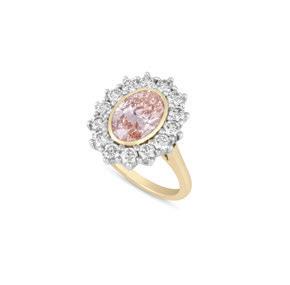

By appointment only | Battersea Power Station, London | enquiries@philippaherbert.co.uk
philippaherbert.co.uk












Lock up your valuables




1 Blackacre Origins Muso diamond and emerald earrings, £20,150, blackacreldn.com. 2 Manolo Blahnik Padstow ra a and leather penny loafers, £715, manoloblahnik.com. 3 Messika So Move XL pavé diamond necklace, £65,000, messika.com. 4 Connolly Suede overshirt, £2,800, connollyengland.com. 5 Falke Anniversary Airport wool and cotton socks, £23, falke.com. 6 Acqua Di Parma Holiday panettone di user, £96, acquadiparma.com. 7 Osprey London Jenson leather holdall bag, £295, ospreylondon.com. 8 Roberts Radio Reva wooden radio, £199.99, robertsradio.com. 9 Leica Camera ZM 2 manual watch, £12,500, leica-camera.com. 10 Finlay Tavistock glasses, £145, nlayandco.com. 11 Ralph Lauren Montgomery cocktail shaker, £215, ralphlauren.co.uk. 12 Paul Smith Signature Stripe textured scarf, £140, paulsmith.com.
Daredevils can drive a racing or classic car at the Goodwood Motor Circuit and join as a passenger for a hot lap with a professional racing driver, or go off-roading in a vintage Land Rover. From £695, goodwood.com
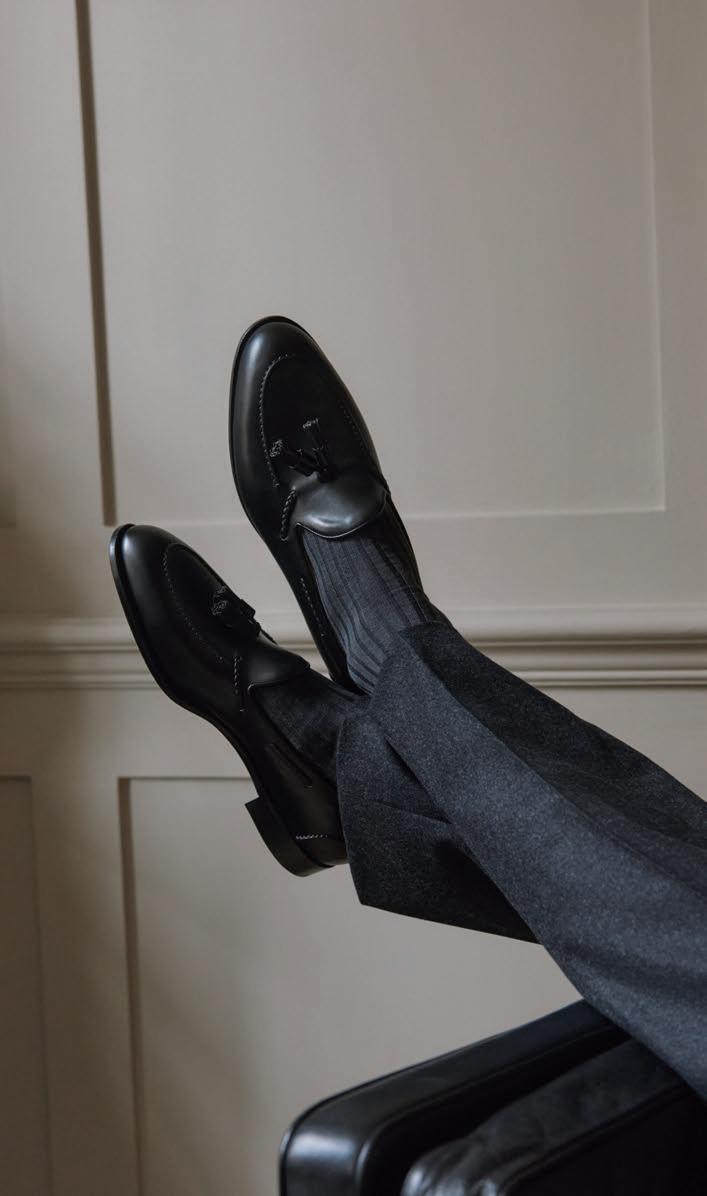









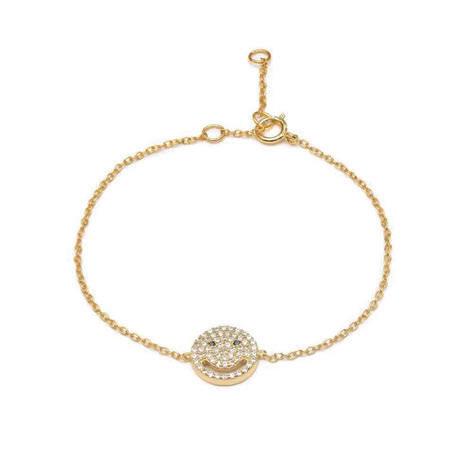

The Second Spring






1 Anya Hindmarch All Over Stickers Girlie Stu pouch, £295, anyahindmarch.com. 2 Malone Souliers Audrey leopard calf hair mini handbag, £1,125, malonesouliers.com. 3 Lulu B London Smile cubic zirconia bracelet, £52, lulub.co.uk. 4 Trinny London Softly Smoky eye shade, blush and lip gloss makeup stack, £52, trinnylondon.com. 5 Henry Holland Maxi Profumo earthenware vase, £295, henryhollandstudio.com. 6 Smythson Soho 2026 weekly diary, £225, smythson.com. 7 Dr Sebagh Supreme collection box, £248, drsebagh.com. 8 Maya Magal Celestial diamond ring, £1,500, mayamagal.co.uk. 9 Vivienne Westwood & Jewellery By Alexander Fury, £50, johnsandoe.com. 10 Jo Vodka 101 e Purist vodka, £49.99 for 700ml, jovodka.com. 11 Jimmy Choo Gloria leather knee high boots, £1,850, jimmychoo.com. 12 Sessùn Duchess blouse, £225, sessun.co.uk.
Transform an empty champagne, beautiful spirit or vintage wine bottle – or indeed any vessel – into a scented candle at Rachel Vosper, which also offers a refill service for up to five-wicks. From £245, rachelvosper.com















1980s nostalgia with a hint of supernatural suspense




1 Oliver Bonas Victoria Saturno metallic trainers, £99, oliverbonas.com. 2 Sealskinz Newgate crossbody hiking bag, £30, sealskinz.com. 3 Seasalt Cornwall Netter annel pyjama set, £69.95, seasaltcornwall.com. 4 Marc Cain Alpaca blend colour block scarf, £185, marc-cain.com. 5 Marshall Major V wireless on-ear headphones, £129.99, marshall.com. 6 Mr Marvis Merino wool and recycled cashmere beanie, £49, mrmarvis.com. 7 To My Ships e Incessant Anxiety geranium antiperspirant, £30, tomyships.com. 8 Fairfax & Favor Wells suede desk shoes, £165, fairfaxandfavor.com. 9 Mother Team Spirit split hood varsity jacket, £467, motherdenim.com. 10 John Lewis x Labrum London Nomoli baseball cap, £39, johnlewis.com. 11 Bella Freud 1970 mohair jumper, £395, bellafreud.com. 12 Luke Edward Hall x National Portrait Gallery Boy Wonder enamel badge, £5, npgshop.org.uk.
Give the gift of theatre – including Stranger Things: The First Shadow – with SOLT’s theatre tokens, available in any denomination online and from retailers from Waitrose to Waterstones. solt.co.uk/theatre-tokens n
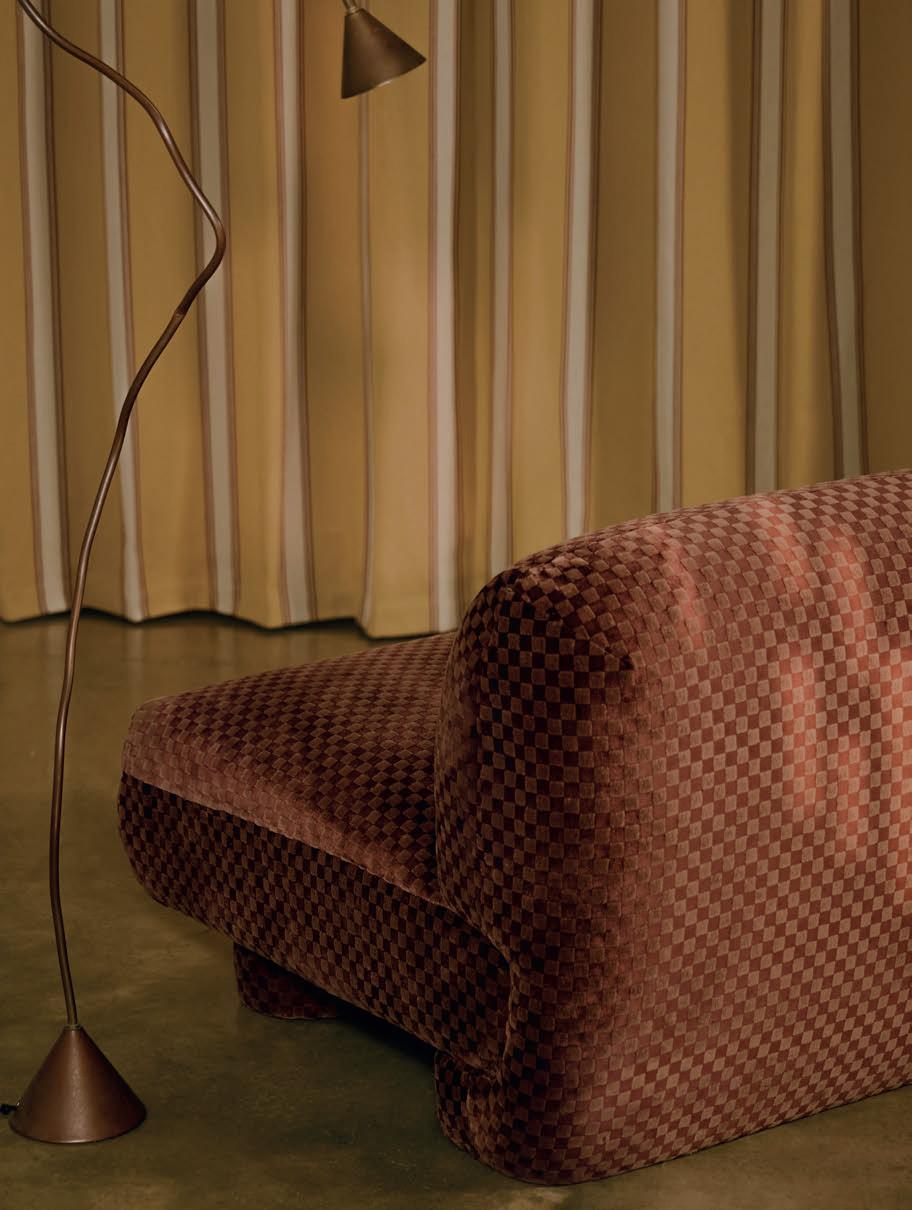







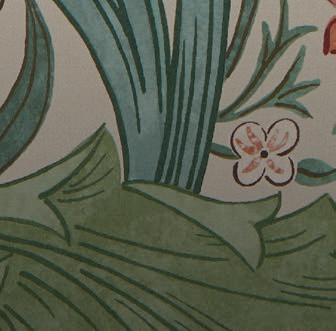


Uncovering original artwork. Archived by The Huntington. Finished by Morris & Co. Introducing Lent Lily



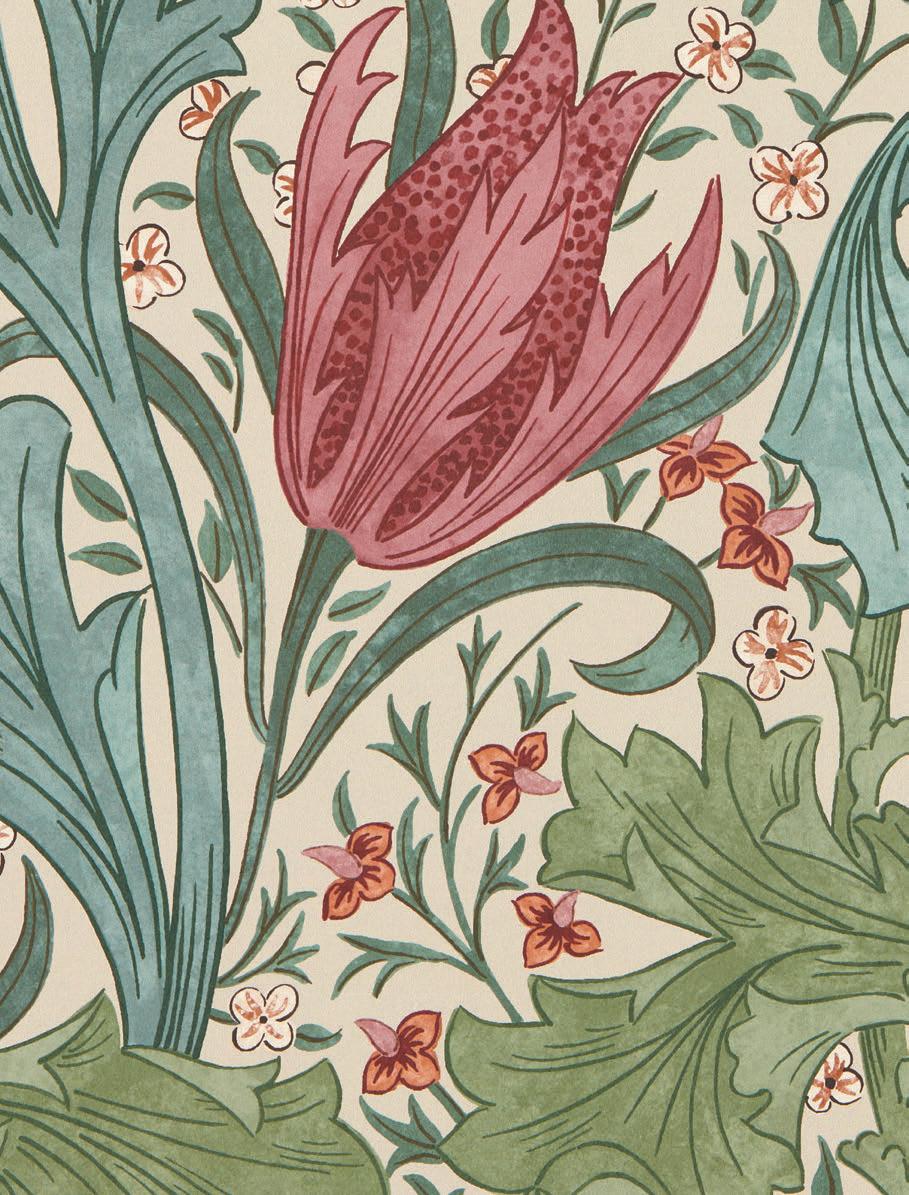
Edited by Carole Annett

Creating Lilliputian marvels in miniature is all the rage, says Carole Annett

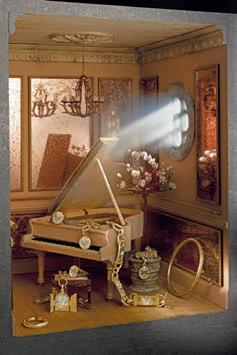
If you thought dolls’ houses were for children, think again. ey may have moved to the nursery in the Victorian era, but before this they were known as cabinet houses, representing miniature versions of a noble person’s own properties. Instead of describing your Scottish castle or Yorkshire manor, you’d steer guests to view the house on display in miniature, decorated in exquisite style and often made by the same craftspeople who worked on the life-size version.
Lucy Clayton of e Kensington Dollshouse Company has seen a recent rise in popularity for her wares, perhaps in some way due to a resurgence of a love of crafting, and also because it’s in nitely more achievable than a life-size project. ‘ ere’s a tenderness to it,’ explains Clayton. ‘ e idea of making curtains for my own house lls me with dread, but I can run up a pair for a doll’s house in an hour or so.’
She has recently returned from installing a Lilliputian house for a client in Dubai. Working from their Kensington studio, Clayton and her mother Rebecca craft heirloom houses that blur the line between realism and imagination. ‘Often we’re building a world with a hyper-real feeling, a kind of kingdom of its own that stirs an emotional reaction.’
Clayton was gripped by the miniature bug after a visit to a doll’s house festival in 2021.
ere with her son on the premise of buying a present for his baby sister, they returned with a 12-room MDF mansion, which sat unattended for weeks before Clayton, having immersed herself in books on the subject, nally took up a paintbrush to begin priming the walls.
Her attention to detail is exhaustive: a real marble chequerboard oor (‘which was a nightmare to install’), ceilings papered with embossed card to give the illusion of plasterwork, and a terracotta kitchen oor. e usual scale is 1:12, which allows a level of detail that can be properly seen. ‘In a doll’s house, you can do things that would be prohibitively expensive in reality. I can go mad with Robert Adam replaces and Fornasetti furniture. Even a lavish little kitchen is only going to cost £50.’
e Kensington Dollshouse’s work has been exhibited everywhere, from Venice’s Homo Faber to Harrods, and the mother-daughter duo regularly works with independent miniature makers around the world. One of their projects –a collaboration with online vintage marketplace Vinterior – was displayed at the Museum of the Home in Hoxton before being auctioned for the museum’s Campaign for Change, supporting social justice charities. ‘My love of vintage is lifelong,’ Clayton says, ‘and nding this once forgotten home and giving it a mid-century
makeover was very special. We combined antique papers, handmade pieces and a few surprises.’
e bathroom became a jungle room, lush with tiny palms and tropical air. e drawing room walls glint beneath harlequin wrapping paper, while a sofa is upholstered in a 1940s silk scarf found at a jumble sale. In the hallway, Gryphon tiles and framed alpine prints – cut from an old Sotheby’s catalogue found in an Oxfam – lend the perfect touch of eccentricity.
For the bedroom, Clayton dressed the walls in a Claus Porto soap wrapper; two vintage Bradbury & Bradbury wallpapers appear in the bedroom and kitchen, with the latter featuring 1940s owerpot motifs that feel right at home behind a bright orange Aga. Kitchen walls are lined with graph paper, and all paints are from Edward Bulmer. e result is charming and eclectic – a house that feels lived in and loved.
Another recent commission was a doll’s house called Cece’s World, made in collaboration with the jewellery brand favoured by Rihanna.


‘I can go mad with Robert Adam fireplaces and Fornasetti furniture’
Clayton’s miniature vignettes – the Underworld, Earthly Delights and Realm of Dreams – re ect three themes of Cece Jewellery’s Triptych collection. ‘Each of these rooms is so evocative and atmospheric, telling a distinctive story that mirrors the narrative of Cece Jewellery. ere is always something precious about a doll’s house, but this one is particularly magical.’
While collaborations are fun, the heart of Clayton’s business is the dream houses she creates for private clients. ‘I’m often torn between historical accuracy and remembering this is a house for fairies,’ she says, ‘and occasionally, I can’t nd things I want.’ She cites the champagne utes in her own doll’s house as an example. ‘I couldn’t nd nice ones at 1:12, and after all, it’s pleasing to edit out the tedious elements of reality. I don’t think the incumbents will complain.’ n
LAYERING
The Eadie & Crole x Jennifer Manners Hampshire rug collection is perfect for a boot room. Coombe rug in cocoa, £500 p/m2. edieandcrole.com
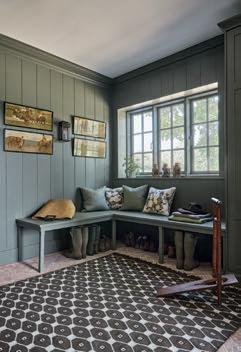

Autumn bobbins in colours including chocolate, khaki, nutmeg and teal. £62 each. addisonross.com

ON THE PROWL
Emma J Shipley’s handdrawn snow leopard features a crown of ice shards. Velvet lampshade, £155. emmajshipley.com
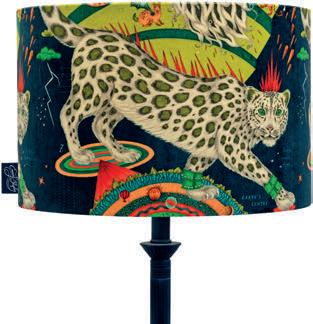
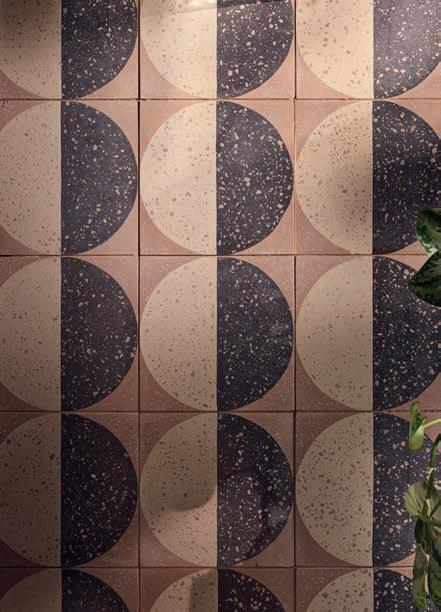

sohohome.com
What’s caught Carole Annett’s interiors eye this season
Amara, from Kismet by Otto Tiles, is a terrazzo-cement combination in four clever colourways, using reclaimed stone. £155 p/m2 ottotiles.co.uk

GO SLOW
Each sofa and chair by Slow is made to order in Yorkshire from natural materials. Owlet sofa, from £2,660. slowsofa.co.uk

Creatures of the deep are the inspiration for David Hunt’s new collection. Fluke wall light, £274.80. davidhuntlighting.co.uk


Hendal slipper chair by Lorfords, covered in reclaimed fabric from Haines Collection. £5,400. lorfords.com
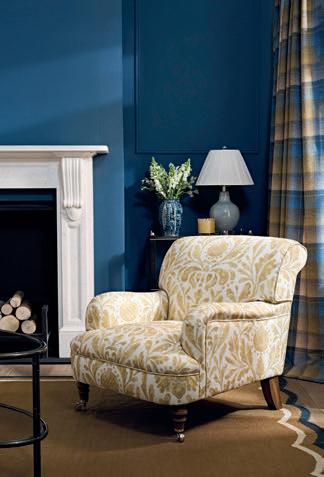
Nina Campbell’s latest collection, Hon eur, is all pretty patterns woven with the designer’s signature charm. Chair in Castellane, £89 p/m. osborneandlittle.com

MOUTHWATERING is Summerville cabinetry is nished in Sumac, one of Tom Howley’s new limited edition cabinetry colours for autumn. Kitchens from £25,000. tomhowley.co.uk

Devon-based Feldspar make these Merrivale ceramic and burr oak side tables to order. £6,950. feldspar.studio

An empty nest has prompted Pearl Lowe to move back to the Capital and write a new book about her favourite city pads
wasn’t planning to come back to London, but I have itchy feet and am always thinking about my next move. My husband Danny says I must have Romany blood. I love the energy of something new and the creativity it brings. London de nitely has that energy, so when we sold our beach house near Brighton, we decided to get a little at in Notting Hill. I love it; it feels like Mardi Gras every day. We left London in our 30s and have returned in our 50s; it’s just us here now our children have left home, and we can go out whenever we want. e other night, I saw my favourite Gospel singer at Union Chapel. I’m actually a lot quieter than people think; I have this terrible reputation, but really I’m a homebody –slippers, dog, hot lavender baths, books, chilling. I don’t drink or smoke; I’m quite boring. is new home was the basis for the book –the third in the Faded Glamour series – alongside ten other homes that I love. I shot Solange Azagury-Partridge’s Somerset house for my rst book and wanted to include her west London at – I love an interiors rebel. And I had to include Helena Christensen’s New York apartment. ese two women have e ortless style; they sum up exactly that faded glamour narrative. en there’s a narrowboat on Regent’s Canal and this beautiful 17th-century former convent tucked behind the towpath in Hammersmith. My daughter Daisy and I shot it for Stella magazine years ago, and it’s beyond anything I’ve seen in London: ten bedrooms, peeling wallpapers, a chapel.
At Lara Bohinc’s house in Camden, I was struck by how clever she is, the way she uses colour and repeats shapes and materials to reinforce the connection between the spaces so they ow. It is certainly more glamour than faded – but there’s a vastness to the rooms, something industrial almost, with the exposed brick and Georgian grandeur that means it ts. I love the main bedroom and its bathroom (Bohnic’s favourite space), with its zigzag wooden oor and pink-painted brick walls. Just imagine taking a bath in here – it’s the height of glamour. As soon as I walked in I thought, ‘I could live here’.
Faded Glamour in the City by Pearl Lowe is out now (Ryland, Peters & Small, £25) n




The former chapel (left) at this house in Hammersmith is now a dining space, featuring a dramatic glass door from an architectural project by one of its owners, Dominic Warren. The parquet-style flooring in the front hall (below) is made up of pieces of wood about 5cm/2in thick and has the most wonderful patina from years of traffic. The sculptural wooden chair was inherited, and the stunning orange velvet curtain was found in the owners’ previous house
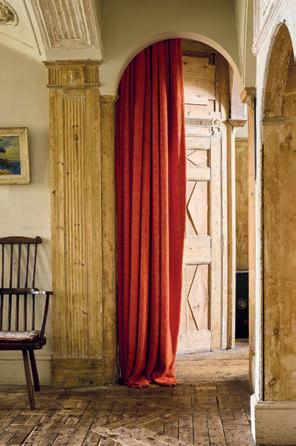


Lowe’s dog Doris loves to soak up the sun on this velvet sofa by Soho Home, among cushions from Preen by Thornton Bregazzi and Sera of London. On the walls hang two paintings by Lorena Lohr
It might feel like a feng shui no-no to house a bed right by the outer wall, but Bunny Turner of Turner Pocock is a big advocate. ‘You’ll unexpectedly create space you didn’t think you had.’ Make it cosier by adding a curtain and a ‘playful wallpaper print on the inside wall, contrasted by a bold colour on the outside’. turnerpocock.co.uk


Banish stark overhead lights and instead ‘layer lighting’, suggests Rebecca Hughes. Lowered pendant lighting paired with dedicated reading lamps on both sides of the bed creates a softer effect – ‘ideal for late-night reading. A relief for the insomniacs, and so much more inviting. rebeccahughesinteriors.com

’Tis the season for spare bedrooms to find the spotlight. By Tessa Dunthorne
‘Good design is about balance: structure against softness, pattern against plain,’ says Venetia Rudebeck, co-founder of Studio Vero. ‘Mixing pieces from different eras adds character: an art deco bedside table with a contemporary lamp feels relaxed rather than “designed”.’ studio-vero.com

PICTURE PERFECT
‘Artwork is a great way to express personality in a natural, characterful way without overwhelming the space,’ says Guy Goodfellow. ‘Tastes may differ from one visitor to the next, so choose pieces you genuinely love, but avoid anything too pointed or polarising.’ Nonetheless, he argues that art is, after all, not what you see but what you make others see... guygoodfellowcollection.com

Tessa Dunthorne canvasses stylists and designers on the delicate art of Christmas tablescaping

ALICE NAYLOR-LEYLAND
Founder of Mrs Alice tablescaping and homewares
LAURA JACKSON
Interiors stylist and the founder of Glassette glass and homewares
HAZEL GARDINER
Award-winning florist and gardener who has presented at RHS
CHARLOTTE PAGE
Professional interiors, events and table stylist
WILLOW CROSSLEY
Renowned florist, stylist and writer

HG: Nature in December isn’t scarce. It’s so abundant in texture and structure. You could dry owers and plants throughout the year, such as alliums, honesty and hydrangeas, and these make brilliant festive displays. Winter- owering viburnum, clematis, heather and daphnes are so eyecatching, too, and can be sourced from UK growers.
LJ: l’ll often tuck aromatic herbs like rosemary or thyme onto the table for a lovely natural scent, and I like using pomegranates and cranberries too, they add such a great pop of colour.
WC: I’m a fan of forced indoor bulbs at this time of year. Paperwhites, hyacinths, amaryllis, propped up in big baskets, and nished with moss and big twigs. I use a lot of woodstock for a pop of hot pink, too, as I’m quite keen on colour in my arrangements.
LJ: We love a paper garland in my house. All year, we’ll collect leftover wrapping paper, colourful cards, little scraps, and then we drape them from the ceilings or wrap them around the tree. I’m not big on anything looking perfect. I usually host Christmas at home; I’ve always loved the feeling of everyone coming together. My daughter and I make a hand-painted menu each year, and I always create painted place settings for everyone. We keep them and it feels like a time capsule of all our Christmases together.
WC: We have collected many baubles over the years, a lot of feathered birds and bows, and we love the memories resurfacing when you open up the decorations box. It means there’s no coherence on the tree but I like it higgledy piggledy. We do Christmas stockings in the morning, and then we’ll have a huge breakfast so we basically eat all day. When we were little we were made to wait until after lunch to open the presents, which was agonising; now we open them rst thing and there’s no rush for lunch to nish.
ANL: No, but don’t be afraid to stray from red and green. My mum loves a blue Christmas Frosted pastels, shimmering silver, or earthy woodland tones can feel just as festive. I love a theme to begin with a story – perhaps a frosty forest, a candlelit feast, or something joyful and bright.
CP: Who said Christmas tables should be covered in bright red runners and poinsettias? Be more unexpected I love using dried hops – they bring a rustic elegance that nods more quietly to the season without feeling overly festive. Soft textures, natural golden tones. Playful, not precious.
WC: I’m quite led by the tablecloth, which this year is a new gentle green oral one. Lots of creamy white ranunculus and variegated ivy will be my starting point. It’ll be very whimsical. Little potted terracotta vases of paperwhites, lots of tall candles and our beautiful candle shades from our collaboration with Barneby Gates. en I’ll scatter gold chocolate coins or I’ll spray nuts metallic gold.
HG: Weave in edible plants – like pomegranates and persimmons – either loose on tables or mounted on picks. ey look as decorative as any ower and last longer. My trump card is a foraged branch mounted above the table, hung with sun-blazed bracken for a dramatic focal point.
WC: By Christmas, I’ve decorated so many homes that I usually turn into Scrooge but this year I’m determined to be festive and OTT. My plan is to ll the house with so many potted bulbs that it’ll look like a mad jungle, wreaths on every door, lots of yellowy lights.
ANL: At the end of the day, the number one rule of entertaining is to put your guests at ease. Make them feel cherished, whether with a handwritten place card, a ribbon-tied napkin, or a little treat at each setting. e true joy of Christmas doesn’t come from the plates or candles – it’s the atmosphere.
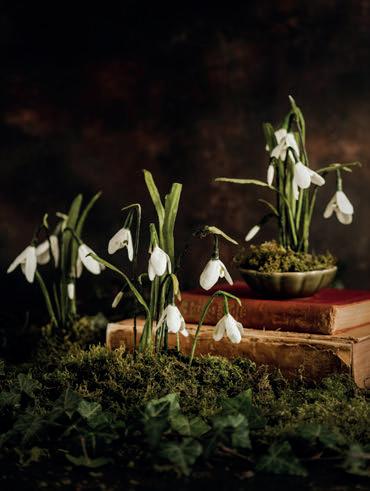
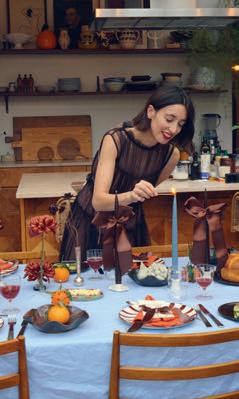

A new event to unite Britain’s brightest minds with its most in uential brands

The latest from the pistes.
By Tessa Dunthorne
Forget navigating unfamiliar roads in a rental car –
Blacklane’s city-to-slope ski transfer service provides a chau eur to take you from city or airport to mountain without a bump. Countries covered include France, Switzerland, Germany, the US and Canada. blacklane.com
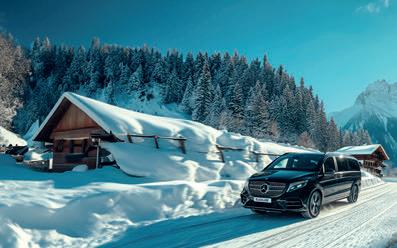
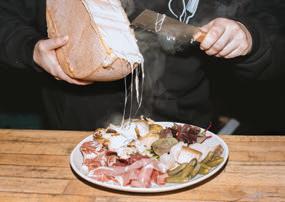
Scott Dunn is launching its Explorers private nanny service across leading French ski resorts. Highly trained nannies to look after the littles from ski school drop-o to afternoon sledging? Phew, you can carve up the piste, sans enfant. From £1,350 for six days, scottdunn.com
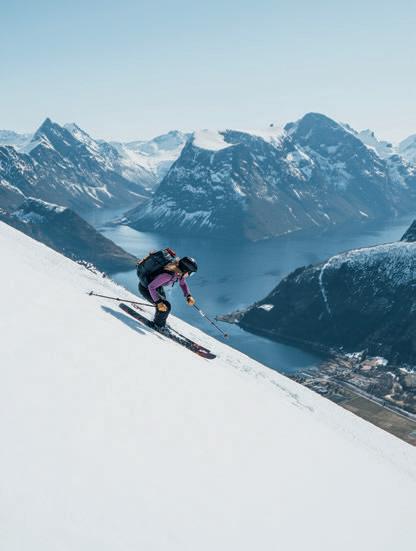
A new six-day itinerary from 62ºNORD tours its guests across Norway’s most fantastical snow zones. From snowshoeing in the Sunnmøre Alps and backcountry skiing in the Stranda ski resort to shing trips in Ålesund, gourmet dinners and ice plunges, this is proper bucket list stu . Snow-Covered Peaks Journey from £9,109pp, including luxury hotel accommodation and meals. 62.no
From Paris to the Alps in 40 winks. e Travelski Night Express has returned (following a pause since 2016), meaning journeys to Moûtiers that don’t cut into slope time. With its own bar and restaurant car, you don’t even need to bring the train picnic. meribel.net
Whet your appetite for snow season closer to home – e Chalet returns to Somerset House this November. Tables, situated rinkside, are bedecked with raclette machines and hunks of the cheesy stu to be enjoyed on charcuterie, cornichons and potatoes. Even better with a mulled wine after a spot of ice skating. somersethouse.org.uk

1 Rosewood Courchevel Le Jardin Alpin comprises 51 rooms, suites and twobed houses, designed by Tristan Auer for the brand’s first ski resort hotel. Asaya, its spa to end all spas, offers post-ski treatments that focus on reviving tired legs. rosewoodhotels.com
2 Apartment Champlain, Méribel is set within a block of swish ski-in, ski-out apartments in Le Rond Point, sleeping up to eight. Start your day with mountain views from its private terrace; end the day in the hammam. thechaletedit.com
3 Ultima Promenade Gstaad is a new designfirst chalet with eight bedrooms, a children’s dorm, spa, pool, cinema room, nightclub, art curated by Artion Galleries, and cheffing from Zuma. ultimacollection.com
Founder Anna Sampson shares why The Chalet Edit is an exceptional chalet experience company
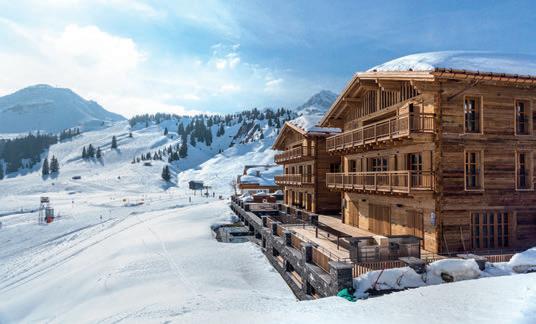
What is The Chalet Edit? At e Chalet Edit, we curate the world’s most exclusive luxury ski escapes across Europe’s leading resorts. From the glamour of Courchevel and the buzz of Verbier to the timeless charm of Val d’Isère, Méribel, Zermatt and beyond, we specialise in tailor-made holidays designed for discerning travellers who value both luxury and ease.
How did you get into this work? I’ve been doing this work for over 20 years now. I began my career as a chalet girl with Scott Dunn in Val d’Isère. From there, I honed my craft working for the best ski and villa travel agencies in London, and helped launch Villa Collective a few years ago. In 2018, I became one of the very few female founders in the ski industry when I started e Chalet Edit.
How does your booking platform differ to your competition? We o er a booking portal with over 3,000 handpicked chalets, live pricing information and availability plus intuitive lters, the ability to make a wishlist and a personal guest portal from which you can manage all details of your holiday. e live pricing and availability is a rare feature in our industry; e Chalet Edit is designed so anyone can look at dates, set a budget and destinations and go from there, with superlative support.
After booking, what happens?
e minute you send your enquiry through, we don’t take it as read: we’re going to dig deep and nd out if this is 100 percent the right property for you. If you have children, we’ll nd you the chalet with the cinema, or if you’re a keen skier, the one that’s on the perfect piste. Or we’ll nd the stay that hits all these points. We will never just hand you over to the chalets. And from that point, we organise experiences.
Tell us about the most incredible experiences you’ve curated. Last year, we sent Santa to a chalet. And we helped arrange an engagement on the top of the Matterhorn – we sent the couple on a helicopter. We’ve sent clients up to hidden mountain huts for dinner via Ski-Doo, treks in the woods, husky sledding,

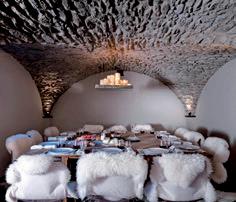

and arranged fondue nights with locals who’ve lived for generations in the area. Our remit is to create bespoke itineraries with everything handcrafted for our clients so their whole holiday is e ortless.
How do you choose the chalets in your collection? Our clients want chalets that are unique or o the beaten track, so that’s what we nd. at’s where chalets like Baita 1697 and La Fenice come in to our collection. ese are not chalets that everyone might know, because a lot of people just want to go to Méribel or Val d’Isère. en we look for the spaces that tip into the most extraordinary luxury. Like Chalet N in Lech, which is the real crème de la crème – you really can’t nd anything like it, a boutique hotel that’s been converted into a chalet.
Discover your perfect ski chalet where exceptional service and hand-picked luxury chalets come together for a holiday that transcends the ordinary via thechaletedit.com. +44 (0)20 8133 1130
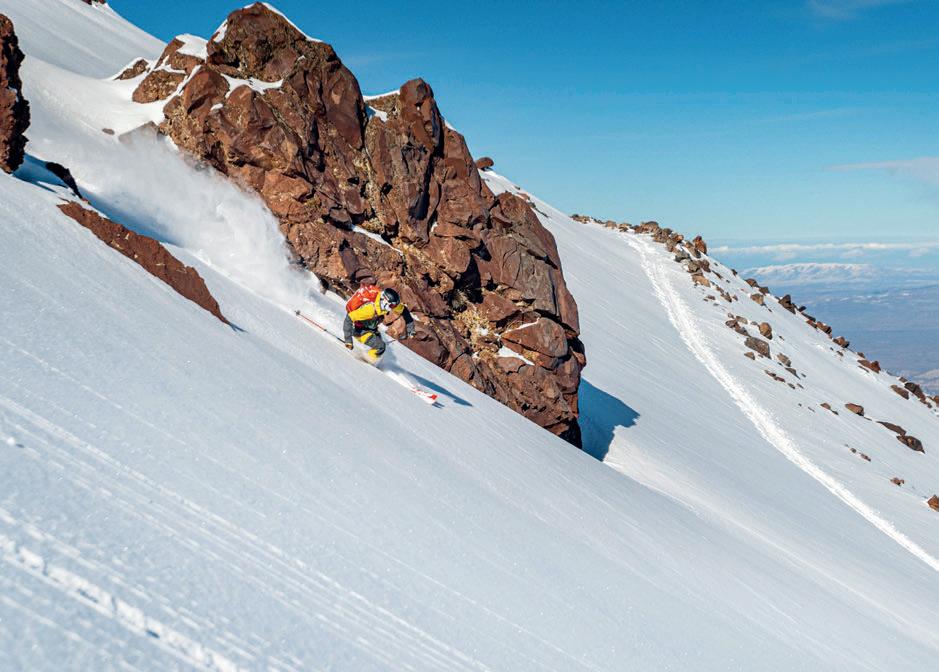
There we stood, on a rocky outcrop below the jagged summit of Turkey’s tallest mountain – the legendary inactive volcano Ercİyes. Where dozens of chutes and micro-valleys had been formed millenia ago by molten lava, now it was our turn to carve down the hill.
Ercİyes (pronounced ‘er-gee-es’) is located close to Kayseri, the regional capital of North Anatolia and gateway to Cappadocia. The lunaresque landscape was created by a ring of 94 volcanoes, whose eruptions and near total disintegration created di erent layers of hard and soft petri ed volcanic ash. Rising out of the waters of an old sea bed, it was sculpted by the wind to create citadels of conical limestone towers topped with hard basalt hats marking this area out as a UNESCO must-see. Ercİyes is one of the few volcanos still standing, its caldera to the front magma-carved to form long ngers of di erent ravines, which can be skied like natural halfpipes.
is most unusual resort was developed in 2011 and today there are four di erent base stations, 19 lifts, 41 marked trails, and vast tracts of o -piste, spread over an altitude of 2,200-3,400m. Aside from developing the skiing, the resort has been rewilding the area, and have planted seven million pine and birch trees over the last ten years.
The bottom of the main run shoulders a large mosque, the evening call to prayer putting a completely different spin on the concept of ‘a-pray’ ski
When I visited in January, I was accompanying legendary freeskier Dan Egan, who rst skied here with his brother John in a Warren Miller movie 35 years ago (Miller’s winter sport documentaries were the original Ski Sunday, in a sense). Back then there was one rope-tow lift, gun-toting locals and the only way up to the hill was a dirt track and a dodgy van with bald tyres; today there is the infrastructure for a world class ski area.
Skiing here still remains quite unlike anything elsewhere in Europe or Asia. e lift tickets operate like fairground tokens, as you pre-buy a speci c number of rides which are gradually punched by smiling, sweet-teao ering lifties – who were clearly surprised to see British tourists. And while you enjoy hot glühwein from a street vendor, the bottom of the main run shoulders a large mosque, the evening call to prayer putting a completely di erent spin on the concept of ‘a-pray’ ski.
e skiing is easily accessible, and there’s enough variety to keep piste skiers happy for a few days and some really great top-to-bottom long runs, perfect for burning through those lift tickets. If you want to venture o -piste, there is a huge amount of fun terrain to explore.
e day we arrived the main gondola had opened for night skiing, so our rst Turkish turns were nocturnal. At the top of the gondola,


skiers and non-skiers alike gathered around re pits while Turkish electropop blasted out of the café speakers. After a couple of laps we were invited to take part in a torchlit descent. In the Alps these are normally skied by instructors, but here was more a health and safety free-for-all, with anyone who fancied it grabbing a aming torch and following the procession.
Come the weekend the main hub was full of locals, many wearing hijabs, coming up for a day out on the snow, be that on sledges, skis or just for the experience, which creates a real carnival feel. In terms of après-ski, most entertainment happens in the hotels, with many o ering live music on various afternoons and evenings. It is not rowdy Alpine partying – more of a jazz club sit-back-and-enjoy vibe; if R&R is the ticket, there is a swimming pool and spa in the Radisson, open to non-hotel guests.
Pausing between turns to drink in the view, Egan and I agreed Turkey’s nascent domestic ski industry has come a long way since he rst visited, when ski hire consisted of trying on a pair of boots pre-attached to the skis; if they tted o you went.
BOOK IT: Ski Turkish (s4ht.com) o ers seven nights halfboard accommodation in Ercİyes, Istanbul and the UNESCO World Heritage Site of Cappadocia from £1,200pp, including equipment rental, lift pass and transfers. Excluding international and domestic ights. e best time to visit is February and March.
Felix’s return ights from London Heathrow to Kayseri had a carbon footprint of 940g of CO2e. ecollectivecarbon.com

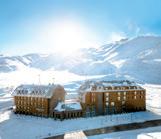


1. Radisson Blu, Mount Ercİyes
A large and comfortable ski-in ski-out hotel with a North American chalet-style themed bar. Relax in front of a roaring fire and listen to live music.
An incredible four bedroom chalet with one completely glass-clad wall that looks onto the nearby mountain. Wind down after a day on the slopes in the Scandi-inspired sauna.
3. Megasaray Mount Ercİyes
A five-star hotel situated at 3,900m with a striking volcanic backdrop. The restaurant is Turkish through and through –as are the bathing facilities – and there’s excellent après-ski.
There are a good selection of mountain restaurants spread across the area, selling koftas, kebabs and lavash flatbreads, washed down with cold Efes beer and a cheerful ‘şerefe’, Turkish for cheers. Our favourite spot was Quup lounge: after lunch one day we were treated to a wild roving Darbuka drum performance by one of the waiters, garnering Turkish lira tips as he drummed on by.
Day trips include a visit to the markets of Kayseri (45 minutes by car or bus) or a walking (or hot air balloon) tour of Cappadocia (an hour by car), where conical caves form one of the natural marvels of the world. The area is also famous for its pottery and we stopped for lunch in Urgup Pide ve Kebap, a traditional Kayseri restaurant where the lamb stew is cooked in a wood-fired oven in individually sealed clay pots, which are then decapitated at the table and the stew poured into sizzling clay dishes. No trip to Turkey can be considered complete without a stopover in Istanbul, one of my favourite cities in the world. Visiting on a bright winter January day was a real eye-opener – no queues for the Blue Mosque or Hagia Sophia and no better time to absorb the scents of the grand bazaar, see the fishermen on the Galata bridge and enjoy street food vendors hawking mouth-watering fish wraps and kebabs.
The experts share their lesser-known Alpine ski spots with Tessa Dunthorne
‘ is is a super-cute village with challenging o -piste terrain for experts – it hosts the Freeride World Tour each winter – and is also part of the large Saalbach Hinterglemm Leogang Fieberbrunn ski area,’ says Gabriella Le Breton, author of e Ultimate Ski Book. e once-quiet Tyrolean town connects to 270kms of pistes yet retains its alpine charm and strong environmental ethos. ‘It’s installing a repurposed chairlift bought from Ischgl,’ Le Breton adds, ‘a nice nod to sustainability, complementing the Skicircus’ use of HVO-powered groomers, renewable energy for lifts, and chemical-free arti cial snow fed by spring, rain and meltwater.’

At the foot of the Matterhorn, Breuil-Cervinia o ers rare privacy alongside vast skiing. ‘ ere are really only four chalets,’ says Anna Sampson, founder of e Chalet Edit. ‘We work with Chalet La Fenice, perched at the top of the resort; with so few chalets around, it’s almost completely private.’ Linked to Zermatt, Breuil-Cervinia grants access to one of the Alps’ largest ski areas while retaining a relaxed Italian atmosphere (and thankfully, Italian food). ‘Zermatt is naturally hard to get to,’ Sampson notes, ‘but since 2023, an improved lift connection between Breuil-Cervinia and Zermatt opens up the possibility of ying to Milan and doing the bulk of your trip in BreuilCervinia – with an additional ski area that’s on the Ikon Pass.’

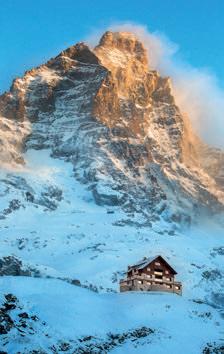
‘Ten villages and six resorts line the Haute Maurienne valley, between the Tarentaise and the Italian border, with a microclimate that guarantees good snow,’ says Katie Bamber, online editor at Fall Line Skiing. e most beautiful of them all is Bonneval-sur-Arc, which doubles as a lm set. ‘Its pistes are high, steep and – incredibly – empty,’ says Bamber. ‘And the o -piste is world-class.’ Adventurous skiers can also join guided outings with ESF to the sublime Vallonnet glacier –a short ascent through wild, high-mountain scenery to the glittering blue ice of its terminal moraine.
A pop of red will ensure you stand out on the piste, says Tessa Dunthorne











1 Moon Boot Icon Glance metallic shell and PVC snow boots, £195, net-a-porter.com. 2 Goldbergh Khloe helmet, £339, goldbergh.com. 3 Balenciaga Mirrored ski goggles, £695, mytheresa.com. 4 Moncler Grenoble shearling and suede gloves, £1,325, net-a-porter.com. 5 Perfect Moment Glacier merino wool turtleneck, £375, perfectmoment.com. 6 Moncler Ski suit, £1,735, moncler.com. 7 Fusalp Celia bootcut ski trousers, £690, net-a-porter.com. 8 Sorel Whitney IIL waterproof boots, £110, sorelfootwear.co.uk. 10 Mackage Elita metallic ski jacket, £1,090, net-a-porter.com.
Francisca Kellett checks into a family-run eco-hotel in the Austrian
Squirrelled away down a long, steep-sided valley in Austria’s Salzburgerland, this magnificent wellness hotel has been run by the same family for six generations. Yes, six. I don’t think there’s a hotel in Britain that comes close.
‘All the hotels here are family-run,’ Selina Hörl from Saalfelden Leogang Tourism tells me when we meet in one of roughly six million cosy corners of Forsthofgut. All of them? Really? No Saudi-funded glitz-pads hidden away somewhere? ‘No, all of them,’ she says. Often run by the third or fourth generation, she tells me, and even the ski lifts are owned by a local cooperative. ey are big on family in Leogang.
And so Hotel Forsthofgut has been run by the Schmucks for over 400 years. It’s a beautiful hotel with a series of larch-clad chalets situated around a lake at the foot of the Leogan mountains. Beaming sta wander around in dirndles, much of the food comes from a 50km radius (70 percent of the farmland here is organic), and there is a wine list longer than my arm featuring mostly Austrian wines. at local emphasis is part of the hotel’s sustainability programme, covering everything from biodegradable cleaning products and completely renewable energy to water, which comes from its own spring.
Your stay ends up being local too; everything you need is right here, including a fully- tted out ski hire shop in the basement and the smartest boot room I’ve ever seen. e slopes in the area are wide, well-groomed blues and reds. While serious skiers might be disappointed by the lack of blacks, Leogang connects up with the vast Skicircus Saalbach Hinterglemm Leogang Fieberbrunn ski area. ere are various charming chalets to stop o in for Glühwein, rösti and mounds of Kaiserschmarrn. Hendl Fischerei at the top of the Asitzbahn lift is a standout lunch spot, with sheepskin-lined wooden booths where well-heeled Germans and Americans sco roast chicken with Dom Perignon to the tune of the DJ. It’s uber chic, in a low-key Austrian way. Really, the highlight here is the spa – actually, the three spas. ere is the Family Waldspa, a

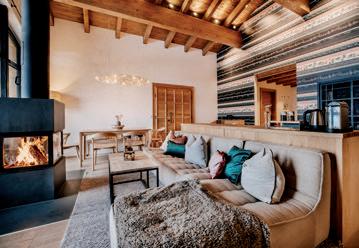

For more information, visit saalfelden-leogang.com/en
Francisca’s return flights from London Gatwick to Salzburg had a carbon footprint of 308.7kg of CO2e. ecollectivecarbon.com
glorious complex with swimming pool and water ume. en there’s the adult-only Waldspa, with four stories of studios, gym, relaxation rooms, saunas and whirlpools looking out over the lake. And then there’s the Seehaus, with a heated outdoor pool, a lakeside sauna and a brilliantly hot (over-16-only) Japanese onsen pool beside the ice-fringed lake.
You could spend all day – all week – at the spa, and the beauty of it is that kids love it, but you can escape them, too. I would spend a happy time messing around with my daughters in the family spa, and then head for a massage that works out any remaining knots in my already deeply relaxed shoulders. It turns out that six generations have really nailed what families want. n

If you run a holiday rental, Airbnb or small hotel, you can often be confronted with a challenge: how do you give guests the same sense of high-end luxury and expectation as a larger property without the scale or budget? This is exactly where The House of Pineapple™ comes in. Specialising in curated kits of beautifully sourced British amenities, The House of Pineapple™ helps independent hosts to easily create a hotel-standard guest experience. Instead of having to order a minimum quantity, you can buy as little as a single set of products. It offers UK-made toiletries in colour-coded bottles (so guests never confuse body wash with conditioner), with formulas based on natural ingredients. Beyond the bathroom, details like ‘welcome to our home’ bed runners, bespoke local maps and branded laundry bags transform an overnight stay into something polished and memorable.
Every product has been designed with both host and guest in mind – practical for property owners to manage, yet special enough to leave a lasting impression. From the first welcome moment to the finishing touches, the range balances style with ease: lightweight robes that feel indulgent, laundry bags that keep changeovers seamless, and branded details that instantly lift a space from functional to memorable.
For independent hoteliers and holiday-let owners, The House of Pineapple™ provides the toolkit to create a branded, hotel-worthy stay that inspires repeat bookings and word-of-mouth recommendations.
Visit thehouseofpineapple.com for more information



At 35, Luke Abrahams is a ski novice. Will he find his snow legs in St Moritz?

Iwant to make one thing clear from the outset: I detest the cold. Growing up, I was not like my friends, and instead of hitting up the peaks and slopes of Verbier, Courchevel and Val d’Isère, I was sipping apple juice cocktails in sub-Saharan Africa. All I knew of th is winter sport came from the pages of glossy magazines and throwback photos of 1980s Princess Diana.
But after turning 35 and facing my fears of the deep sea during a coral reef dive in Mozambique, it seemed only rational to keep my YOLO-mojo in motion – even if it induced a frosty existential crisis. e only question that remained was… where should I pop my skis on? The birthplace of winter tourism, St Moritz, seemed tting.
My rst lesson began the morning after check-in at the Badrutt’s Palace. My instructor, a young Swiss woman called Madleina, was tasked with my winter conversion therapy on a small slope with misty views over the valley.
ere I stood next to a line of toddlers all waiting to jump on the magic carpet to the top of the hill in front of me. I could easily be one of their uncles, and yet despite the colossal age gap, they knew far more about skiing than this lowly journalist battling to stand up straight on one leg in the snow. ankfully, I was not the only adult here – I counted half a dozen ski tourists from all over the globe.
e rst lesson was about the basics, and perhaps the hardest thing for me was the simplest measure for most: clicking my boots into my skis. After a few tumbles, I could stand still and take in the slopes. e snow was like glass; fresh and powdery, and under the sun, so bright it was near impossible to see. And then the perils of my ski boots began to set in: not only did my legs feel as though they were being crushed, but I also felt trapped in a perpetual arse squat that burned more than a reformer pilates class.
Begging to move a bit more, I did a run on the bunny hill, focusing mostly on balance, turns and motions. e hardest thing to master, for me, was the dreaded ‘pizza’, aka learning to stop at speed.
At rst, it was like being present in someone else’s body. I could understand the concept of anking my legs in the opposite direction to stop in haste, but doing it successfully? Another story. I fell at on my side four times. But there was solidarity in this failure to brake; most of the adults could take comfort in accepting that we were all beginners. e toddlers did not notice – they were more obsessed with taking a ride on the magic carpet, or, as in the case of a young Italian boy called Andrea, eating the snow.
Eventually I got the hang of it. ‘Oh, it’s all in the hips!’ I screamed to Madleina. Once I mastered the art of pushing my gluteus maximus out for the world to see, I nally conquered the art of stopping on command and with that, did my rst little run down a slope that saw me crash and fall twice… before I nally rose victorious. It had been a long time since I’d had a physical challenge of this scale, and even though I knew I would come out on the other side full of bruises and aching feet, I loved it. Snow sports had always been a no to me because I was afraid of the cold, but by the end of the lesson I was so drenched in sweat I was ready to tear all my layers o and head starkers down the mountain, Swiss style.
So confident, I planned a six kilometre toboggan ride down the slopes for the next day. Spoiler: I crashed four times, but made it to the bottom, smiling – and in one piece.
Luke’s trip produced 281.7kg of carbon (plane and train return journey) ecollectivecarbon.com
‘There I stood next to a line of toddlers all waiting to jump on the magic carpet to the top of the hill in front of me. I could easily be one of their uncles, and yet despite the colossal age gap, they knew far more about skiing than this lowly journalist battling to stand up straight on one leg in the snow’

Legendary resort hotels
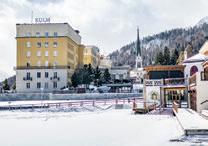
1856, Kulm Hotel is the birthplace of many modern winter sports, from skibobbing to skeleton bobsledding. Beyond its colonnade imperial façade, its greatest charm is in its retro grand hotel mise-enscène. Doubles from £800, kulm.com

BADRUTT’S
This colourful fortress has been the go-to retreat of aristocrats since it opened in 1896. Be it its grand lobby, cavernous wine cellar or mountain/lake-view suites, it oozes the romance of the Grand European Tour. It offers exceptional pizza from Chesa Veglia, to boot. Doubles from £1,400, badruttspalace.com n
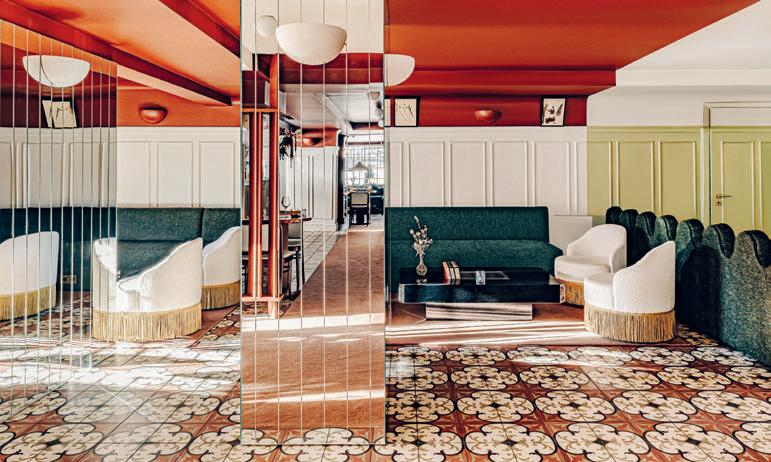
Felix Milns singles out four of the best European ski hotels for the upcoming winter season
Confusingly for Brits the Experimental Chalets are actually hotels, infusing the cutting-edge creativity of their cocktail bars – which pretty much launched the concept of mixology as an art form – into reimagined mountain lodges with a modern hedonistic twist. And the Experimental Group is expanding its footprint in the mountains. Its o er last winter season was a fresh hotel in Val d’Isère, with a whopping 113 rooms, two restaurants, a spa, a kids club and, of course, a cocktail bar. Yet it is Verbier which remains its rst love (and where I stayed this season).
e OG Verbier Experimental Chalet opened in 2018, and sits next door to the legendary Farm Club. It is of course famed for its signature craft cocktails, and operates as the late-night launchpad for a night on the Farm (hotel guests get privileged direct access). Behind the cocktail curtain, the hotel’s 39 rooms o er a retro cool blend of seventiesinspired chic, seductive spa and contemporary curveballs. e restaurant, Frenchies, is an outpost of the Parisian Michelin-starred mothership and is a farm-to-table inspired bistro.
BOOK IT: Doubles from £502. experimentalchalet.com

SIERRA NEVADA, SPAIN
Not many people know you can ski in Southern Spain and this stylish new opening is perfect for an alternative short ski break. It’s quite unlike being in the Alps, not least because on a clear day you can see the Med in one direction and the Alhambra palace in the other. Make time for an unbeatable lunch at La Lonja, the highest fresh seafood restaurant in Europe.
Sister hotel to neighbouring El Lodge, and part of the wider Marbella Club group, the 29-room and suite Maribel is a fantastic new addition to the Sierra Nevada scene. With Alpine-inspired interiors designed by Andrew Martin – mirror and leather trunk style furniture, plush furs and ikat fabrics – it’s Southern Spanish hospitality and service at its best.
ere’s a Nordic-inspired sauna and indoor hot tub area and spa (using Kloris products), and guests are also invited to walk across to the outdoor pool, sauna, hot tub and cold plunge at El Lodge. Similarly you can eat in either e Grill at El Lodge or sample the fun party vibe of Maribel’s, with a DJ curating the tunes during dinner.
BOOK IT: Doubles from €550. maribels.com

Refurbished and reborn from the historic (and closed) Margna hotel opposite the railway station, the Grace is the rst new ve-star in St Moritz for 50 years. And boy does it live up to the hype. e heritage architecture is cleverly honoured, with the listed ceilings of the art nouveau bar lit to great e ect, creating the perfect setting for their award-winning tarot card cocktail menu. Led by master mixologist Marco Giumelli, they craft their own distillations behind the eight-tonne carrara marble bar. e Devil is a wicked re ned tequila with habanero distillate, all the avour and none of the heat.
Adjoining the original building, the new wing includes the e View, a circular dining room and spectacular piece of contemporary architecture overlooking the lake (a croissant chariot is part of the spectacular breakfast). Circular beauty by day and night and unbuttoned ve-star service, it’s the only hotel restaurant in St Moritz without a dress code. e hotel also opened a Beefbar last winter – an outpost of Riccardo Giraudi’s modern luxury steakhouse and the rst in Switzerland.
BOOK IT: Doubles from €550. gracehotels.com
Also within the Beefbar stable is the restaurant at Le Coucou (cuckoo in French), one of Meribel’s top hotels. Rather than focusing purely on steaks they major on beef-based street food, albeit at a rather more elevated price. e glorious sun terrace above Rondpoint is perfect for long lazy lunches.
e look and feel of the hotel is quite eclectic, polka dot carpets, cuckoo clocks aplenty and vintage nds mixed with coolas-you-like contemporary curves in a colour scheme of mustards, ochres and terracotta. ere’s a heated outdoor and indoor pool (a real beauty), plus a spa with six rooms for treatments with Tata Harper products. Mention must also go to the makeover of the old Cote 2000 restaurant on the Solaire slopes just above Mottaret. What was midmountain mediocrity at best reopened as Le Tipi (tipi-meribel.com) last winter; it’s an epic new on-mountain lunch spot, with live music, neon voodoo art, Moroccan lamps and Indian headdresses. e star of the after-lunch show is an immense drinks trolley with towering bottles of Azul tequila and local genepi.
BOOK IT: Doubles from £452. lecoucoumeribel.com

Ninety-one years ago, Walter Ingham took his guests on the rst ‘package’ skiing holiday. e 14-night trip to Austria by train cost 12 guineas and proved such a success that he organised ve more trips that winter. e package ski holiday was born.
Fast forward to the present day and Inghams are still pioneering ski holidays, only this time by going back to their roots in train travel. One third of all their resorts are now available to book as train packages, and switching more passengers to this mode of transport is a key plank in their 2030 sustainability roadmap.
One of the best resorts for direct access is Les Arcs, a resort that was awarded B Corp status in 2024 – the rst in Europe, not least because of its train-friendly connections. We left St Pancras on the Eurostar, before switching platforms in Lille and bundling our ski gear and luggage into the spacious cabins of a high-speed TGV to BourgSt-Maurice, the valley town on the road to Val d’Isère and Tignes, but linked directly to Les Arcs by funicular.
Free to use, the 100 percent electric funicular leaves the train station and seven minutes later you are in the heart of Arc 1600. e whole trip took just over nine hours, arriving in good time to settle in before dinner, and only taking a hour longer than a smooth journey by air. Short haul ski holidays are one of the lowest carbon holidays you can take, and if you travel by train you reduce your emissions down to a tiny 0.1 tonnes per person, equal to a walking holiday in Scotland.
A nd it’s popular too. An astonishing 25 percent of guests arrived by train last winter, with 900,000 riding the funicular up to the resort. is season’s goal is to breach the million mark. We were staying in the Hotel La Cachette, one of Inghams’ most popular Les Arcs hotels. Recently refurbished, it was one of the original buildings built in the 1970s, designed at a 30 degree slant so that each balcony receives its fair slice of sun. Its architectural history is fascinating too, literally designed out of nothing by famous French architect Charlotte Perriand. So much
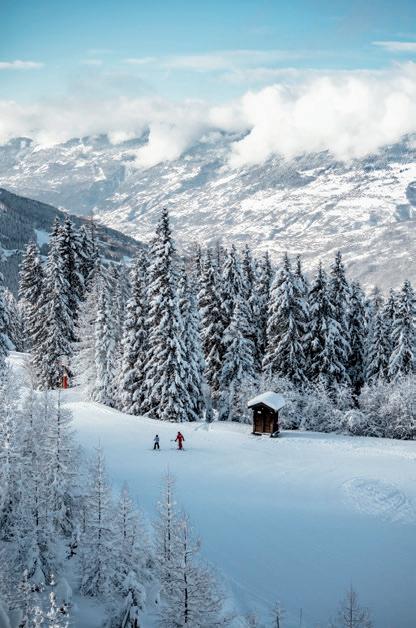
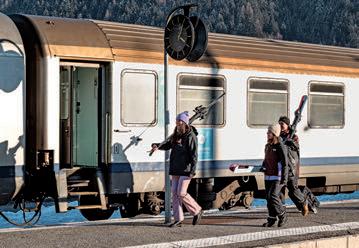

Caroline’s Eurostar and TGV from London to BourgSt-Maurice had a carbon footprint of 72kg of CO₂e ecollectivecarbon.com
so that the French government awarded it national heritage status as an exemplary model of 20th-century sustainable mountain architecture. And the skiing’s not too bad either. Together with La Plagne, Paradiski is the third biggest ski area in France, with 425km of high-altitude snow-sure pistes, and some great mountain restaurants. We had a wonderful lunch on the terrace of Chalet Grillette, lapping up the views across the Tarentaise valley, but my favourite was Chez Leontine, the perfect spot for a snowy day. is blend of tradition, culture, design and sustainability makes Les Arcs not only a hero ski resort for our time, but one of the top in the Alps. Not bad for two changes from St Pancras. n












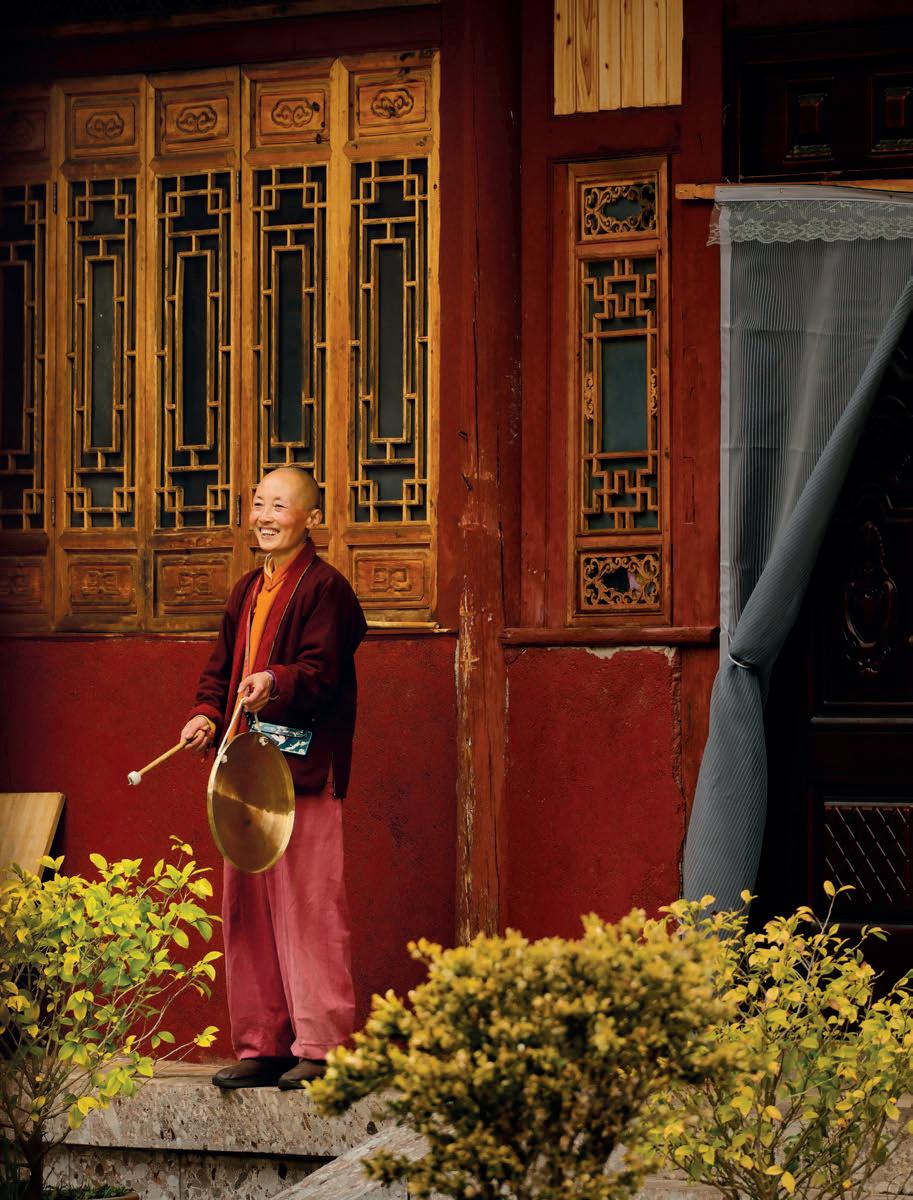
Lost, found and immersed in the landscapes of Yunnan, Luke Abrahams discovers China’s most rebelliously diverse province
Iwill never forget the rst time I watched Lost in Translation. I vividly remember a scene in which Scarlett Johansson walks alone through the streets, gardens and sacred temples of Kyoto in silence. Her only way of communicating is via a nod or a faint smile, and her face screams a thousand emotions, from loneliness to quizzical curiosity. at’s the beauty of Asia for you. It’s a continent lost in translation, from customs to ways of life, culture and, of course, language. No matter where you go or who you come across, you are, at every passing corner, quite literally lost for words in a sea of thousands.
is is very much how I found myself in rural China: adrift, confused and – aside from the company of my companion Nicolas and our guide Steven – deeply solitary. Yet, in all this loneliness, you nd a sting of liberation in it all. Here, among a legion of crowds scurrying through Dali’s domestic departures terminal, not a single person looked like me, spoke like me or even dressed like me. It might seem a bizarre paradox, but I oddly felt seen, as if I were the star of my own narrative.
Blending past, present and future, China is unique in the world. e country is a timeless mix of history, strict traditions and in nite possibilities, all thriving in unison alongside a swathe of surprises. From headlines to political ideologies, the name alone conjures up all sorts of feelings: fear, intrigue, mystery and curiosity. Look beyond all the terror-inducing superlatives, and you’ll discover a world of dizzying oxymorons.
Yunnan province has always stood out from the rest of China. Historically, it was most famous for its role as the Ancient Tea Horse Road, a network of slithering trade routes that connected lone travellers – like us – in southwest China with Tibet and the rest of southeast Asia. e route, still used today for its nomadic sense of adventure, gained its name from primary trade: tea from Yunnan was exchanged for horses and even religious instruction between Han and Tibet, from the Tang and Song dynasties to what is now known today as the People’s Republic of China. With 25 o cially recognised ethnic groups – Dai, Bai, Wa, Lahu, Hani, Jingpo, Nu, Naxi and Lisu among them – a vast array of rich plant life (an estimated 19,333 higher plant species), and landscapes from jungles to dramatic rice terraces and desolate plateaus, Yunnan is perhaps nowadays best described as China’s most rebelliously diverse state.
at said, this image of a remote, cut-ofrom-the-rest-of-the-world abyss is, at times, lost in translation. Legions of tour buses, souvenir stalls and backpacker cafés and inns are part of the humdrum. And its combination of ‘di erent’ and ‘ethnic’ has made it fall victim to the trendy international crowds, as well as a booming Chinese domestic tourism industry.
We rst saw this in Dali City, where its Old

Town beams with neon signs and giddy tourists from Beijing who come here to pose alongside its mishmash of purpose-built and Disneyesque sculptures of famous historical Chinese gures. Scurrying around its shops lled with knickknacks – from teapots to old western records – and street food stalls serving petri ed insects, there was a sense of a cultural sell-out. ankfully, this vision of mass consumerism began to fade by the time we hit Xianglong Village in Xizhou Town – 30 minutes outside downtown Dali and our home for the next two days. Our digs here, the storied Sky Valley Heritage Boutique Hotel, set in a former Bai-style palace decorated in traditional calligraphy, paintings and ceramics, give the impression of a town still very much in touch with its roving roots.
Set under the shadow of Cang Mountain, Xizhou has always been an important trading post along the Tea Horse Road. e village itself is a mixture of cultures, mostly made up of Bai people (Bai merchants travelled extensively from here to Tibet, trading Dali’s tea, marble and handicrafts), and remnants of its past are still very much a feast for the eyes and other senses. We rst encountered this at Xizhou’s daily morning market, a vast abyss of frenetic colour and buzzing chaos. Locals descended on its mad streets to buy groceries – from sticky breads and rice noodles to fresh shoots, live sh and huge vegetables of all varieties.
In between, restaurant vendors tempted hungry bellies with all sorts of Dali delicacies – clay pot sh, steaming Xizhou Baba (a sweet bread) and wild mushroom hotpots – while local ladies wooed myself and Nicolas with silk weavings and portraits illustrating Yunnan’s various wild landscapes. e rest of the city is very much a living museum. Bai-style courtyard houses make up most of the fringe (the Yan Family Compound, now a museum, is its best example and well worth a visit), and the road up to Cangshan Mountain, a sacred heritage site known for its precious marble, paints a picture of life here before electric cars and scooters replaced yak- and horse-drawn carriages.
e vision of Yunnan’s splendid isolation

Blending past, present and future, China is unique in the world: a timeless mix of history, strict traditions and infinite possibilities, all thriving in unison alongside a swathe of surprises

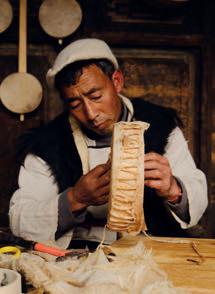
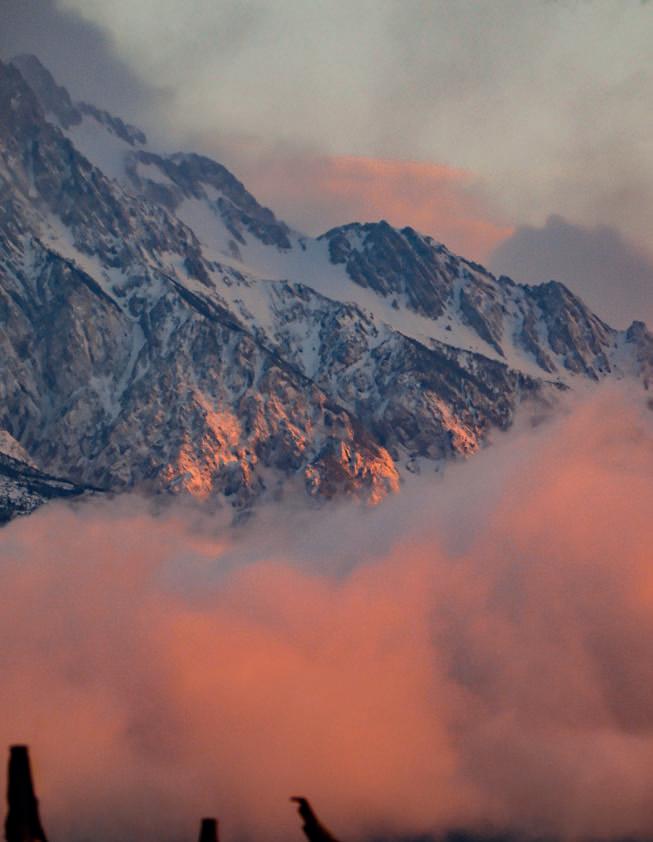


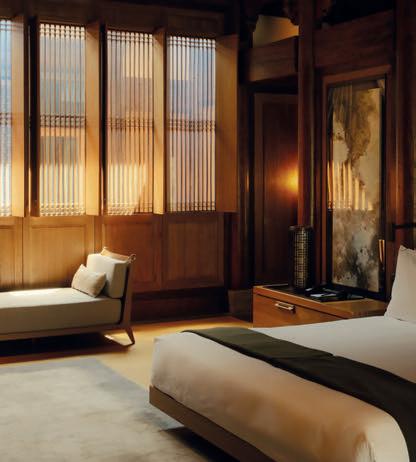
continued on the road to Lijiang. Driving south, the hustle and bustle morphed into a world of towering rice terraces and empty roads to nowhere. Eventually the road ended abruptly, and we arrived in Stone Dragon Village. is was the rst time we encountered the real, raw and dusty wild China cut o from the rest of the world.
A cluster of Bai carpenter families, the town is a patchwork of bric-a-brac houses surrounded by wild owers and snaking rivers that trail their way into the mighty Yangtze. Daily life in this part of China is unequivocally humble, simple and silent. A mirage of cows and sheep add to its pastoral landscape charm alongside quick-witted farmers eating with their families and village elders playing cards in clouds of cigarette smoke. Time passed and our western faces stuck out like a sore thumb, and shy locals o ered us food with a friendly nod and smile – a banquet of Bai delicacies from winter pork and smoked sausage to fried azelea owers and broad beans – and after a traditional performance and singalong courtesy of the village’s children, we hit the road again for the mountains.
A thick cloud of ethereal mist welcomed us into the grand city of Lijiang, kingdom of the Naxi people, and home to Amandayan, our sanctuary of peace for two nights. Crowned by the Jade Dragon Snow Mountain, it serves as Lijiang Old Town’s imposing backdrop and is often described as one of the most beautiful places in China. Between its cobblestoned streets and historic teahouses, a portrait of
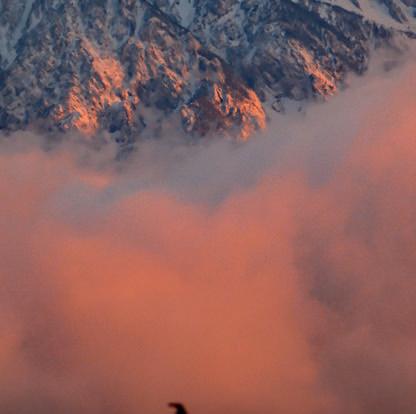

Naxi life is drawn throughout its storied temples and inns. e segregated group are known throughout China for their unique shamanic, literary and farming practices, all in uenced by the Confucian roots of Han Chinese history. While the now commercialised city remains their stronghold, nods to their traditional and authentic customs still ooze throughout Ciman Village, a small cooperative 8km outside of downtown Lijiang.
A part of Aman’s cultural o ering, here we spent time learning about social traditions, including the art of Dongba (an ancient Naxi script, predating Traditional Chinese), courtesy of a writing class. In between a banquet lunch – again served in silence with a nod and a smile – of hotpot favourites, we made our own drums bound with yak skin that we later bashed while being treated to a Naxi dance routine.
Later, we ascended the hills to explore the historic Wenfeng Temple. Set on the foot of Mount Wenbi, the golden monastery was rst founded under 17th-century Naxi king Mu Tian Wang and was once used to welcome the supreme academy of the Kagyu sect of Tibetan Buddhism. Now, it’s mostly a place to engage in meditations and Buddhist teachings. With a mise-en-scène of plumes of incense trails enveloping cascading falls and blooming cherry blossoms, it’s a place to re ect and unwind in the privacy of your own stillness.
A fter exploring the winding roads of Daju through the mighty Tiger Leaping Gorge and the Tibetan plateaus and grand temples in
Shangri-La, our adventure ended in Shanghai. We skipped e Bund for seclusion 50 minutes outside the city at the Amanyangyun resort, and, like our rural adventure before, we found ourselves again in a state of cultural immersion: Ming and Qing dynasty houses and ancient camphor trees stand side by side and undisturbed for hundreds of years, while the expansive millennia-old forest set metres outside of the resort transports you into a desolate vision of a Shanghai lost in time.
Beyond the rooms, Nan Shufang is Amanyangyun’s spiritual heart. e cultural centre, inspired by the scholars’ studios of 17th-century China’s literati, is a throwback to the country’s growing appreciation of its imperial past and is where guests can partake in everything from the art of incense making to calligraphy. It dawned on me as we left that this private sanctuary steeped in antiquity serves as a reminder of what Yunnan once was: the nal frontier of storied epic adventures, and a remnant of a history perhaps now best described as wholly lost in translation and lost in time.
BOOK IT: Cazenove+loyd o ers a ten-night trip to the Yunnan region of China from £8,500pp, based on two people sharing, including international and domestic ights, transfers, touring and some lunches (cazloyd.com).
Luke’s ights from London Heathrow to Shanghai and Shanghai to Dali had a carbon footprint of 3,379kg CO2e. ecollectivecarbon.com


Afamily holiday isn’t simply about getting away together. It’s about stepping into experiences that shape stories, bridge generations and build a legacy that lingers long after the return home.
We don’t design family holidays as distractions or crowdpleasers. We create journeys that honour curiosity at every age, from wide-eyed wonder to seasoned perspective, giving space for children, parents and grandparents to feel part of the same adventure.
Time together is precious; at Steppes Travel, we help you use it well. That might mean tracing turtle tracks across a moonlit beach, hearing migration stories from Maasai elders, or learning how to forage in the Amazon. We believe in journeys that give everyone a role, making each family member feel not just included, but essential to the experience.
This isn’t about ticking off landmarks. It’s about creating shared moments: tracing the tracks of pharaohs, kayaking with your teens in Croatia, laughing together on a river raft or sitting in stillness while the night sky unfolds above. Moments that deepen bonds create
memories to be recounted time and again.
Our long-standing relationships with guides and hosts mean that family trips aren’t just holidays –they’re opportunities to connect with people who make places come alive. From conservationists to storytellers, scientists to artists, we match you with those who inspire across generations.
Travelling as a family can sometimes feel complicated, but with over 30 years of experience, we know how to create journeys that balance pace, comfort and wonder. Whether it’s a villa on a private island, a safari camp in the wild or a homestay in the mountains, we ensure every detail allows you to focus on what matters most: each other.
Steppes provides conscious luxury: not opulence, but enrichment. Travel that feels good not just for you, but for the communities and landscapes you encounter. Better experiences create better memories and in turn, better outcomes for the world your children will inherit.

When you return home, you’ll carry more than photographs. You’ll return with a deeper sense of connection, to place, to people and, most of all, to each other.
So travel – not just together, but deeper. Strengthen the ties that bind.
See The World Better with steppestravel.com. Contact via 01285 880980 or inspireme@ steppestravel.com n
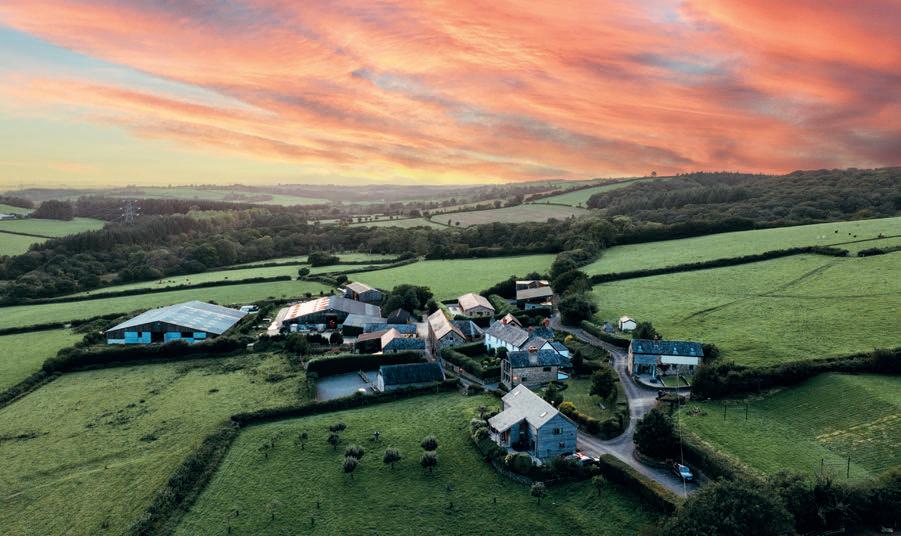
Stay in a rewilded 1286 estate | with conservation at its heart
On the fringes of Exmoor National Park, surrounded by 774 acres of rolling valleys, wildflower meadows and ancient woodland, lies Mornacott, a country estate dating back to 1286. Discover its secrets through a British rewilding stay.
Once a traditional shooting and farming estate, Mornacott remains connected to its agricultural heritage while embracing a new chapter of restoration and renewal. In 2023, it came under the stewardship of Oxygen Conservation, a private company dedicated to restoring landscapes at scale and creating positive environmental and social impact – including offering exceptional ecotourism escapes like this one.
Today, Mornacott is a thriving, biodiverse estate. Its trees are flourishing, it has flower-rich meadows, and plans are underway in the hope keystone species like beavers will traverse the waterways once again. Its habitats are being restored by working kindly with the land, and the care that has been put into the land makes it an ideal cocoon for personal R&R, too.
Here, you’ll uncover a stay that balances luxury with mindful conservation. The estate’s beautifully restored 17th-century barns and cottages blend



heritage with contemporary comfort (think oak beams and vaulted ceilings, outfitted with soft furnishings and modern amenities).
The cottages are perfectly suited for family gatherings or friends escaping the city. Choose from cosy hideaways sleeping six to eight or take over the grand Mornacott Farmhouse (sleeps 14), or, for truly special occasions, book the entire estate for up to 35 guests.
Shared spaces are designed for connection: the farmhouse’s bespoke dining table seats 24, perfect for leisurely suppers that stretch into the night. Between meals, unwind in the 13m heated indoor pool, sauna, or games room, or venture outside to enjoy the sports field and woodland walks that wind through the estate.
What truly distinguishes Mornacott is the combination of elegance and engagement with the natural world. Guests can join a guided night safari across the estate in a 4x4 buggy, spotting deer, foxes, owls and other wildlife – a magical experience for adults and children alike. You can stroll private paths through woodlands, wildflower meadows and riverbanks, or venture out to the dramatic Devon coast for a change of pace.
Tranquility is guaranteed, and while many guests never leave the bounds of the estate during their stay, the dramatic North Devon coastline and wild moorland of Exmoor are just a short drive away.
For a 2026 escape that blends elegant design, family-friend flexibility and the wild beauty of North Devon, book early. This is the kind of place where memories are made – from serene evenings on the terrace with a glass of wine to exhilarating wildlife sightings under starry skies.
Visit the Mornacott website and secure your chosen dates – whether it’s a week-long summer stay or a shorter off-peak break.
Get in touch at +44 (0)1769 550102 or info@mornacott.co.uk

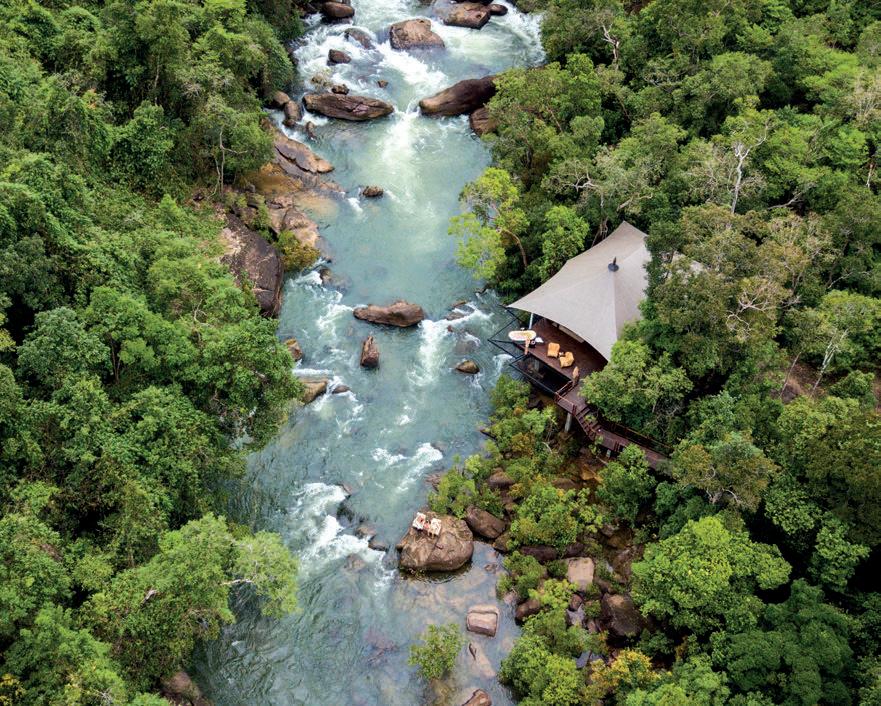
Stephanie Drax finds a country redefining itself with resilience, creativity and a commitment to sustainability
On the dusty streets of Siem Reap are clusters of Cambodian children standing in the baking April sun, white talcum powder and cheeky grins plastered across their determined faces. ey’re armed with water in buckets and plastic pump action pistols, ready to drench me and any other passersby – easy targets in tuk-tuks. ese kids are playing their part in the Khmer New Year jubilations, symbolically washing away bad luck from the previous year and soaking us all in the promise and potential of what lies ahead.
In 2025, this auspicious celebration coincided with the 50th anniversary of the darkest shift in Cambodia’s fortunes: the abrupt arrival of Pol Pot and his communist Khmer Rouge forces in Phnom Penh. A grim chapter began on 17 April, 1975 – the rst day of what the regime coined Year Zero – in which violence raged, fear consumed, and 20 percent of the country’s population perished. With much of a generation


The HeroRATS of Siem Reap are too light to set off mines but can sniff out TNT and alert detonation experts, saving untold lives


erased in three years – along with family, culture, religion and education – Cambodia has had to be resilient and resourceful to cope with its legacy.
Chef Nak – Cambodia’s culinary icon – grins broadly as she welcomes me into her antique wooden homestead outside of Phnom Penh, where two airy suites and an open kitchen encircle a swimming pool. Here, guests can learn Cambodian cooking skills that pre-date the Khmer Rouge – recipes Chef Nak has meticulously collected from all corners of the country, from the memories of elders. ‘Food used to be about celebration and stories between generations,’ she says, ‘then cooking was banned and there was no food at all. Food became about survival.’ She teaches me the sweet, salty and sour balance of Tea Kanh, a duck salad with a delicate blush of avours, and that night she creates ne dining poetry, weaving 100 jasmine owers around a beef nataing curry. ‘Food is science, history, connections and preservation,’ she says passionately, ‘and I want to see our culture nally travel.’
In Siem Reap, tourists are drawn to atmospheric temple ruins and the majesty of Angkor Wat at dawn, but the city’s story is also embedded in the acts of Cambodian people. e performers at Phare Circus are brave: the founding troupe was orphaned during the genocide, and artists today are recruited from hardship to hone skills, to make a show and a living. ey contort the tale of their country’s tragic past into physical feats, and Sreyleak, the circus’ young star, makes me tearful with her
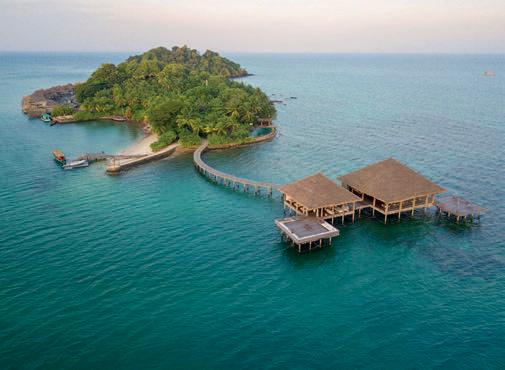
visceral performance. Now 26 years old, she joined the circus aged 11 when she lost both parents. ‘ is is my family now,’ she tells me softly, ‘and my future is as big as a rice eld.’
On the outskirts of Siem Reap, I arrive at an eight-hectare eco-hotel where rice elds form a spectacular centrepiece. Phum Baitang (translated as Green Village) features picturesque wooden villas on stilts studded across the paddies and is the rst hotel in Cambodia to be certi ed by Green Globe in recognition of its sustainability initiatives (100 percent plastic free; 100 percent locally supplied food and craftsmanship).
Channelling a pre-war Cambodian idyll, smiling sta cycle along paths lined with rose apple and moringa trees, and bu alo are cooled with a hose in the heat. It’s a romantic reimagining, and where Angelina Jolie chose to stay while she directed the lm First ey Killed My Father, an adaptation of Loung Ung’s must-read memoir of her childhood under the regime.
Cambodia is one of the most landmine-a ected countries in the world. ese war relics have triggered tragedy in rural communities, but assistance arrived in 2014 in the shape of a giant African rat. Trained to scan land the size of a tennis court in just 30 minutes, the HeroRATS of Siem Reap – as named by the organisation that trains them, APOPO –are too light to set o the mines but can sni out one-trillionth of a gram of TNT and alert detonation experts. At the APOPO visitors’ centre, I hold one of the 42 beautiful rats that last year contributed to the clearing of over 13 million sq/m of land, saving untold lives and limbs.
On the coast, the problem is plastic: single-use bottles are swept down-river or cruise in on ocean currents. Song Saa Private Island in the Koh Rong archipelago has poured its e orts into uplifting the local islanders to make a living collecting plastic debris. To date, 200


metric tonnes have been removed, allowing the ecosystem to thrive. Song Saa is as lyrical a hideaway as its name suggests, with pinch-me sunset and sunrise views, dreamy overwater dining, and a vast villa I don’t want to leave. e night boat ride is the grand nale: needle sh vault like skipping stones under our spotlight, and when I slip into the water, I oat amid bioluminescent plankton under a canopy of stars.
In 1979, remnants of the Khmer Rouge retreated from the advancing Vietnamese army into the Cardamom Mountains, an area of dense rainforest near the ai border. Today, it is one of the last remaining habitats for Asian elephants, clouded leopards, sun bears and Sunda pangolins. Poaching and deforestation are rife, but Cambodian hotelier Sokoun Chanpreda is committed to the region’s conservation.
Shinta Mani Wild, his famously amboyant property co-founded by architect and designer Bill Bensley, bene ts from the remote location – my 350-metre zipline arrival over a carpet of treetops is a thrilling introduction. e 865-acre jungle property, with its beguiling soundtrack of gibbons and cicadas and abundant snacks of sweet kuy fruit, pulls guests from the comfort of their splendid, tented quarters. e most extreme adventure on o er is a motorbike patrol with armed Wildlife Alliance rangers, rescuing captured animals, arresting poachers and loggers, and seizing illegal equipment. e con scated items are piled high in a storeroom with over 12,000 animal snares, 679 chainsaws and 11 rearms, depicting their daily struggle.
From the cities, to the coast, to the Cardamom mountains, there are determined shoots of change in Cambodia. ‘ e trauma of the regime touched every generation,’ says Chanpreda, ‘but after years of silence, the younger generation is helping Cambodia rediscover its voice and shape a new identity.’ So much more than a bolt-on for its ancient wonders to a southeast Asian holiday, Cambodia deserves for us to stay longer and celebrate its bright future.
BOOK IT: Scott Dunn o ers a nine-night package in Cambodia from £7,095pp based on two people sharing, including ights and domestic travel, expert local guides, one night at Chef Nak Homestay, two nights in Phum Baitang, one night in Shinta Mani Angkor, three nights at Shinta Mani Wild, and two nights at Song Saa Private Island (scottdunn.com).
Stephanie’s ights from London Heathrow to Phnom Penh via Bangkok and back via Singapore had a carbon footprint of 3,268kg CO2e. ecollectivecarbon.com
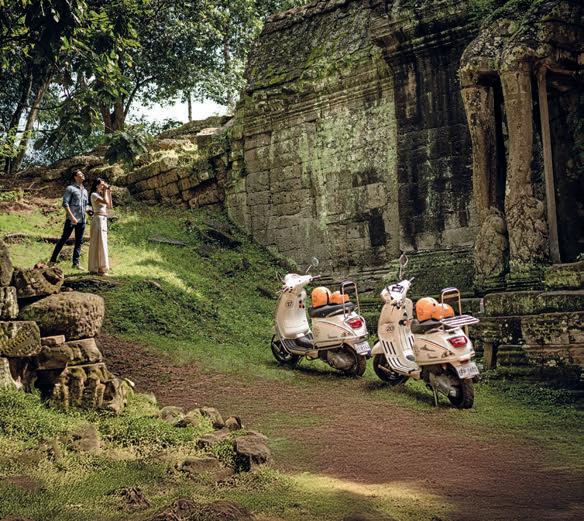

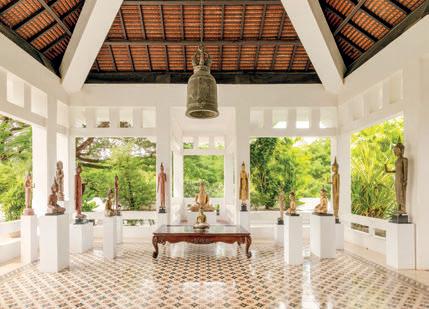
Francisca Kellett and her family discover Angkor Wat at sunrise
One of life’s great challenges is getting teenagers out of bed. For school it’s a battle, and on holiday it’s near impossible. But in Cambodia, with mopeds in the mix, we managed it: two teenagers, smiling and ready by 04.30.
We were in Siem Reap – my husband, two daughters and me – staying at the colonial-chic Ra es Grand Hotel d’Angkor, a 1932 grande dame complete with butlers. While my daughters weren’t impressed by the concept of butler service, they quickly appreciated what could be arranged: a sunrise Vespa tour of Angkor Wat.
Emerging from the hotel into the dark, we were met by ve gleaming Vespas, each with a guide and driver. Helmets tted, we whooshed through deserted streets and into the rainforest surrounding the temples. Our guide, Pheakdey, led us to a quiet spot by the water to watch dawn unfurl in a peach blush over the 12th-century towers. It was just us, the still water and the ancient stones – unforgettable.
We then wandered through the vast temple complex, once the world’s largest city. Pheakdey explained King Suryavarman II’s vision, the astronomic precision of the layout, and carvings that once gleamed with gold. After a couple of awe-struck hours, our drivers whisked us to a secluded orchard for a picnic breakfast – tiny bananas, pineapple pastries and croissants good enough to rival Paris, all laid out on a beautifully dressed table courtesy of the Ra es butlers.
Refuelled, we continued to Ta Prohm, the Tomb Raider temple made famous by Angelina Jolie. Vast g and silk cotton tree roots have engulfed the stone, twisting and curling around the walls in extraordinary natural sculptures. en onto the Bayon temple, its 216 giant carved stone faces smiling serenely over the jungle, while macaques squabbled below.
By lunchtime, hot, exhilarated and exhausted, we returned to the calm of Ra es. It’s the kind of hotel that makes collapsing feel glamorous: chequerboard marble corridors, plantation shutters, polished wooden oors and an original creaky lift straight from an Agatha Christie novel. Outside, frangipani-scented gardens encircle a vast pool, while indoors we found afternoon tea – towers of eclairs and pastries, accompanied by Raul the pianist playing show tunes.
By the end, the teens were sunburned, sleep-deprived and happier than I’d seen them in years. Vespa plus Angkor Wat? A winning formula.
BOOK IT: Doubles from £234, B&B. Ra es Lost Civilisations of Angkor by Vespa, from £260 for two (ra es.com/siem-reap).
Fran’s ights from Hanoi to Siem Reap and then back to London Heathrow via Dubai had a carbon footprint of 1,720kg CO2e. ecollectivecarbon.com

Vanuatu is the Paci c paradise where culture, nature and raw beauty still rule. is island nation of 83 volcanic peaks and turquoise lagoons has unveiled the Seven Wonders of Vanuatu, a natural bucket list spanning ery volcanoes, ancient rituals and world-class coral dives. Highlights include Mount Yasur, one of the world’s most accessible active volcanoes; the ethereal Blue Cave on Tanna Island; and Espiritu Santo’s Champagne Beach, where bubbles rise through the sand like a glass of zz. Visitors can also witness the daring Nagol land diving festival, explore WWII shipwrecks and unwind in eco-retreats such as Havannah Boat House.

Gen Z is swooning over ‘townsizing’. In other words, opting for quaint, picture-perfect towns over pulsepounding cities. According to Priceline’s 2025 US travel trends report, 67 percent of young travellers crave the relaxed charm of Nancy Meyers-style retreats such as Old Saybrook in Connecticut, the charm of Cape Cod or the nostalgic hum of North Wildwood on Jersey Shore’s Cape May. What’s driving the movement? Storybook landscapes, local character and easy escapes from the airport. It’s the kind of travel where discovering a local bookstore feels just as groovy as rooftop cocktails.
From ‘townsizing’ to ‘coolcations’, Lauren Ho rounds up the latest travel news from around the globe
e Oberoi Group has unveiled Elements by Oberoi, a bold new initiative anchored in nature’s three essential elements: earth, water and air. Designed to reshape how its hotels operate, the plan includes 100 percent wastewater recycling, renewable energy sourcing and fully electric vehicles all by 2030, as well as organic farms, composting schemes and the elimination of single-use plastics. With 50 new properties in the pipeline, this is a commitment to responsible luxury at scale.


A new perk is turning the travel world upside down: a growing number of UK employers are joining Climate Perks, the pioneering scheme by climate charity Possible that rewards sta for choosing low-carbon travel. Instead of penalising employees for skipping shorthaul ights, participating companies o er extra paid leave for journeys made by train, coach or ferry. Over 70 organisations – from Triodos Bank to Faith In Nature – have already signed up. It’s a simple nudge toward more mindful travel, turning the journey – not just the destination – into something to linger over.

As heatwaves intensify, travellers are heading north. Google searches for ‘coolcations’ have doubled, with Virtuoso reporting increased interest in places like Scandinavia and the UK countryside. is new holiday mindset favours a slower pace, from quiet mornings in the Cotswolds to lakeside stays and forest walks in the Nordic wilds. ‘“Coolcations” are the breath of fresh air we didn’t know we needed,’ says Andy Brooker, travel expert at kate & tom’s, a UK company curating stylish group getaways. Mind you, with all the A-listers hot-footing it to the Cotswolds, we wonder how quiet their mornings will remain.

THE NEWMAN, London, UK
Marking the debut of British brand Kinsfolk & Co, The Newman is Fitzrovia’s newest neighbourhood stay. Behind its art deco elegance are 81 rooms, an all-day brasserie, characterful cocktail bar, and a Nordicinspired wellness space with London’s first hotel ice room and salt wall studio. thenewman.com

turned heritage villa. alieeistanbul.com

IMARET, Kavala, Greece
Built in 1817 as an Ottoman külliye and later transformed into a boutique hotel, Imaret, in the Greek port town of Kavala, has emerged from a transformative restoration. Now an eight-suite sanctuary, the historic monument offers five-night immersive stays centred on stillness, Thracian gastronomy, tailored wellness rituals, and cultural discovery. imaret.gr n


Atravel writer friend recently declared she was boycotting holidays to Malta. is was new to me. North Korea? Sure. Myanmar? Fair enough. But Malta? It’s the birds, she explained, and I recalled reading something about this in Isabella Tree’s book, Wildling. ‘Exactly!’ My friend got quite excited at this point. ‘ ey shoot all those birds. Lapwings, skylarks, turtle doves…’ It’s all thanks to a loophole in the EU’s Bird Directive, which means that thousands of birds are shot each year as they migrate over Malta. ‘Why would I go on holiday to a place that kills turtle doves?’
It’s a niche argument, but opens up the broader tangle of the politics of travel – the ethics of why we think it’s okay to visit some countries, but not others. Some are no-brainers, like North Korea, where you simply can’t visit without cooperating with the government, aka paying a brutal dictatorship. Others, though, less so.
Take the US: according to the U.S. Travel Association, the number of Brits visiting the US is down by 14.3 percent this year – and the total drop in international visitor spending has cost the US economy up to $29bn in lost revenue. Liddy Pleasants, managing director of Stubborn Mule Travel, tells me their US bookings are down even more – 32 percent year on year, while bookings to Canada are up 24 percent. ‘Many families don’t feel comfortable travelling to the US right now, or they want to demonstrate their Trump displeasure.’
Tourism can, of course, build a lifeline, which is the argument often trotted out for visiting countries like Saudi Arabia. Long a no-go zone thanks to its human rights violations, it is now throwing its considerable riches into luxury travel, investing $800bn by 2023 and creating vast projects such as NEOM and Red Sea Global. Much has been written about how this is opening up the country, empowering locals – especially women – and focusing on sustainability. But there have been just as forceful arguments about tokenism, greenwashing and culture-washing. Saudi is, after all, an absolute monarchy with no freedom of speech, discrimination against women and the second highest use of the death penalty in the world (China tops the list, FYI).
If we choose to avoid a particular destination, it’s often not regimes that suffer most
But does staying away actually achieve anything? Is Donald Trump wringing his hands, agonising that his views on immigration or renewable energy might keep a few British tourists away? ‘In my view, boycotting travel to speci c destinations doesn’t usually achieve anything,’ says Pleasants. Justin Francis, co-founder of Responsible Travel, agrees. ‘If we choose to avoid a destination because of particular issues, it’s often not regimes that su er most, it’s local people, who may already be disadvantaged. Take away tourism and you can take away a lifeline.’
‘We o er holidays to Saudi Arabia, but we also write honestly about the issues there,’ says Francis. ‘We o er trips that support local communities, including enterprises run by women, and homestays and smaller, locally-run hotels over large chain resorts.’ But while visiting a totalitarian country might allow us to interact with locals, exchange ideas and support them nancially, if they can’t vote will things ever really change? Conversely, by not going to a democracy, especially one that counts on tourism – like the US or Malta –the impact will be quickly felt on the ground and might even sway how people vote next time.
Really, though, it’s not just about where we travel, but how we travel. It’s about asking questions and being honest with ourselves. Staying in an international luxury chain hotel on a private island won’t give you many – or any – meaningful interactions with locals. We might justify that we’re staying in a ‘sustainable’ hotel, and argue that its very presence has created jobs. But in reality, the big winners will be the shareholders of that international chain and the government. Where we draw the line – at unsavoury governments, or objectionable politics, or complicated rules about shooting birds – that’s up to us. n
Unlock the festive period’s full potential with a stay at the Sanderson Hotel
Hidden behind a discreet façade in Fitzrovia, Sanderson London is where surrealism meets vestar comfort. Reimagined from a 1950s landmark by Philippe Starck, the hotel was recently refreshed by designer Tim Andreas. e results are interiors that are playful yet polished, from the dreamlike lobby (with the famous lips sofa) to the glowing 80ft Long Bar lined with eye-shaped barstools.
Upstairs, the rooms are calm spaces with freestanding bathtubs and 300-thread-count sheets. Guests who book a suite are treated to Cannaray wellness extras – a CBD bath melt and lip balm to help you unwind – or can purchase the bespoke sleep gummies and night oil from the minibar.
Perfectly located between Soho, Covent Garden and Marylebone, the hotel makes an ideal base for festive shopping or theatre-going, though you could just as easily stay put and soak in the serenity.


e Restaurant, under the direction of Chef Daniele Za ora, serves modern Italian comfort dishes, like handmade pastas which change with the seasons. Come December, the festive menu lands – last year it included roast bronze turkey and a Christmas pudding crumble –with sharing-style plates designed for dinners with friends and family.
For a more whimsical eat, the Mad Hatters afternoon tea places you rmly in Wonderland: expect Cheshire Cat king prawn tarts and Queen of Hearts cheesecakes (topped with wild berry curd). Downstairs, the Long Bar keeps the party going with cocktails and DJs every Friday and Saturday, while this winter the Purple Bar will be transformed into a seasonal hideaway by Grey Goose, serving up festive martinis beneath twinkly lights.
Just a short stroll away, discover the rooftop garden at the nearby British Museum (free entry) for panoramic city views and a calm escape from street level or wander north into Fitzrovia’s quieter streets for independent bookshops, hidden galleries and street-art murals. eatreland is a stone’s throw away, making the hotel the perfect stumble from the best Christmas theatre (see Olivia Emily’s top picks on p62).
BOOK IT: Doubles from £400, morgansoriginals.com/sanderson n
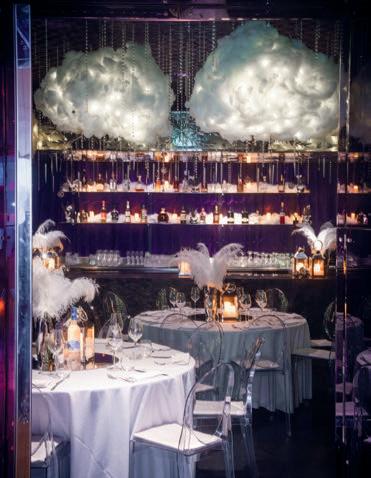
As a British hotel lands in Palm Beach, Lucinda Baring discovers a small-town tropical enclave that goes unabashedly big on colour and fun
There’s a line in Palm Royale, when Kristen Wiig’s character
Maxine is desperately trying to penetrate Palm Beach society – this tiny bubble of privileged women, dressed in riotous colour, vying to outdo one another by throwing the most lavish gala of the season, all in the name of philanthropy – that neatly encapsulates the madness and vanity of it all. ‘I am never in over my head,’ she declares. ‘It would be disrespectful to my hairdresser.’
ere is still a season – from anksgiving to Easter – and there are still umpteen galas (sometimes two a day), but change is afoot too. e season is getting longer, people are lingering, and the crowd enjoying this sun-drenched, hyper-colourful, tropical playground is younger, more international, more diverse.
Trump’s winter White House at Mar-a-Lago has piqued interest (the president’s presence tolerated rather than embraced), but mostly people come for the weather (the gulf stream coming up from Cuba means neither the water nor the air drops much below 75°F) and to slip awhile into that beautiful life encapsulated by Slim Aarons (who spent so much time in Palm Beach, there was a retrospective of his pictures at the Ann Norton Sculpture Gardens last season). ere is colour and fun at every turn: in the way people dress, the interiors, the restaurant and shop awnings.
A new hotel opening amidst this teeny enclave is a big story, particularly when it comes from British hotel group Iconic Luxury Hotels (which counts Cliveden and Chewton Glen in its stable). Palm House is a chic pink palace a block from the beach: chandeliers with pink glass palm leaves hang from the vaulted, mirrored ceilings of the buzzing and glam lobby bar, its walls of sea shells and corals leading onto the pool with pink parasols, pink banquettes, pink towels. In May, it was lled with stylesavvy (mostly) American women – mother and daughter trips, groups of girlfriends seeking sand between their toes. And yet as the newbie, Palm House still has a hidden gem feel, and dinner at the Peruvian-Japanese restaurant, eaten on the terrace by the pool tucked away from the island fray, was a highlight of my trip.
To ground rst-timers like me, there are a few things you must do. Visit Henry Flagler’s house, now a museum. It was this accidental Standard Oil tycoon who transformed a swampy barrier island into America’s foremost winter resort by building the Florida East Coast Railway and bringing the Gilded Age to Palm Beach. Walk through his former home – the ballrooms, billiards room, his third wife’s exquisite drawing room – and step onto the train he built, on which each family (Astors, Vanderbilts) had their own carriage to ferry them to their winter playground. Cycle or walk the ve-mile lake trail and peek at the palatial beachfront mansions (58 billionaires own property on Palm
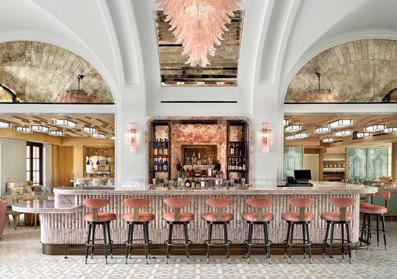




Beach) and Bethesda-by-the-Sea church, where Donald and Melania were married. Pause at e Breakers, the second hotel Flagler built and the rst resort hotel in the US – blag your way in by having a co ee at the café-shop, and then gawp at its ballrooms.
Book brunch by the pool at e Colony (also pink), still the heart of the island scene. It was here that Judy Garland left a sequin dress she’d bought on Worth Avenue hanging on the back of her bedroom door, only for the Oval O ce to send a ghter jet to pick it up so she could wear it to JFK’s inauguration ball. Make time for a meander along Worth Avenue, as glam today as it ever was. Better still, get Rick Rose – Palm Beach’s snappiest dresser – to guide you, because a quick zip to ogle the wealth is to miss the point entirely. is famed half mile set the standard for Rodeo Drive and Fifth Avenue and runs from the ocean to the Everglades Club, built in 1918 when Paris Singer (heir to the sewing machine empire) and his architect pal Addison Mizner decided to bring the French and Italian Rivieras to Palm Beach. Stroll Worth Avenue’s Mediterranean revival, bougainvillea-strewn vias, which open into pretty courtyards dotted with fountains, statues and hibiscus trees. Tucked away

here are some of the island’s best restaurants, including low-key Pizza Al Fresco and celeb favourite Le Bilboquet.
Worth Avenue’s draw is its mom-and-pop store meets Rodeo Drive meets Capri vibe, where everyone knows each other and stops to chat on the sunny sidewalk. Jane Holzer (born and raised on the island) opened Sweet Baby Jane’s ice cream parlour here, where Andy Warhol used to visit her.
Of course the island evolves – since the 1970s, the tra c lights are no longer switched o at the end of the season – but a huge part of its charm lies its unchanging nature and suspension of reality, even just for a little while, where people still have to wear a shirt for dinner.
BOOK IT: From £1,520pp, including return ights to Miami, four nights at Palm House and return Brightline trains from Miami to West Palm Beach with America As You Like It (americaasyoulikeit.com).
Lucinda’s return ights from London Heathrow to Miami had a carbon footprint of 2,102kg of CO2e. ecollectivecarbon.com n

Fee Drummond journeys through the Alps – and back in time – with her family
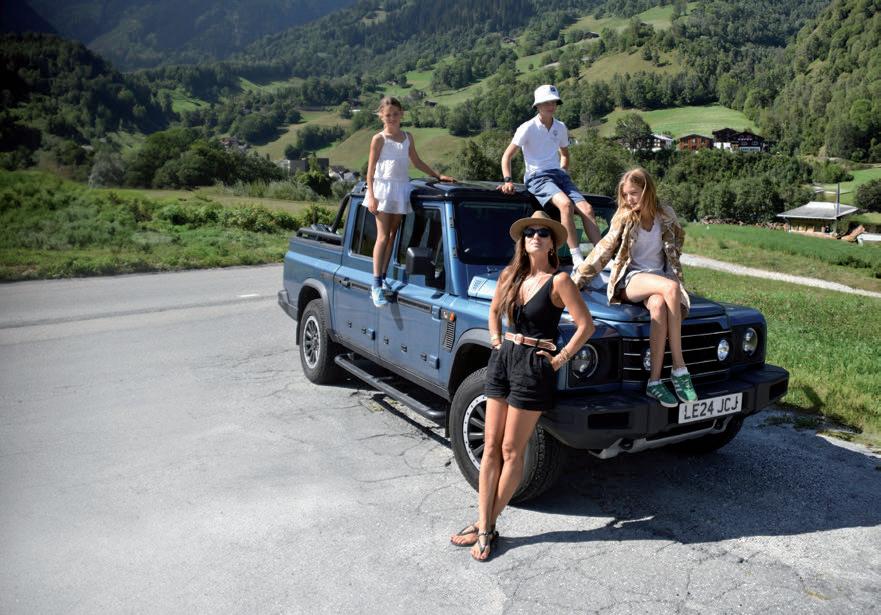
Every year we take a family road trip, and I have long lusted after exploring the Alps in the wild bloom of summer. A road trip with kids is like a lock-in, their ‘presence’ guaranteed by the nature of being contained, in our case inside my INEOS Grenadier. Sibling spats over which music or podcast to listen to next melds with learning the world from the window as we cross borders.
Reaching Alpine communities and small farmsteads is refreshing. Cattle barns are built beneath the house, doubling as under oor heating as the animals radiate warmth to the family above. Our kids delight in playing with age-old water-bucket mechanisms on our hikes, the simplicity, echoed by passing horse drawn carts and the sounds of cowbells tinkering through the landscape, a soothing counter to our overloaded lives. e journey is peppered with pit stops, mainly determined by the location of pretty church spires. I lie in wild ower meadows while the kids run for a wild pee, before the inevitable frustrations are on the next leg as we motor across Europe.
We rst unfold our caravan of cases at Le Grand Bellevue Gstaad, an elegant old school place more like a country house than a hotel, and where Brunello Cucinelli happens to be hosting his closest clients, friends and family for the weekend. Gstaad has never looked chicer –and my girls have never enjoyed people-watching more. We hike with a picnic to Lauenensee, enveloped by pinewoods winding round the river. Splitting o to scale steeper mountain slopes, we pass many elderly walkers, showcasing the impressive tness levels of an alpine lifestyle.
On we travel to Lech, our most beloved family skiing spot, where we have enjoyed exceptional o -piste ski-touring for over a decade. Little prepares us for arriving at the Bond-lair that is the Arula chalets. e kids immediately agree it is the pinnacle of our road trip, and of their holidays so far.
Luxuriously cocooned within the spectacular Arlberg mountains –normally known to us blanketed in snow – we settle into family games of backgammon and chess, feeding peanuts to the resident black squirrel Joseph as he carefully climbs the children’s legs on the chalet terrace. Saunas, steam rooms, a swimming pool, ice-hockey rink, darts, a pool table, cinema room, library: there is a room for absolutely everything. We breathe in mountain tranquility, watching kites glide through the spectacular valley from our wide windows, nourished by being en famille.
We spend days e-biking up mountains, jostling herds of cattle with our hands and voices while pushing our wheels through cattle gates, and sinking our bare feet into deep moss-covered boulders on waterfalls, taking in the breathtaking views on top of grassy runs we normally ski down. As we stop to catch sh for lunch at a local restaurant, my son slips o to play a quick nine holes before home and everybody is happy.
Unanimously we agree this is real luxury, being here together nestled amid beautiful Austrian villages and nature. Exquisite food, candle-lit dinners, horizontal teens lolling reside after long days spent adventuring and exploring, we drift to sleep each night excited to start again.



e labyrinthine underground spa at Le Grand Bellevue Gstaad o ers red light therapy saunas, steam rooms, hay heat and copious Roman bathing – a roomy respite after hiking and biking the hills around the picturesque town.

riving Alpine biodiversity means we see butter ies and dragon ies everywhere, alongside red squirrels, marmots, wild horses and cattle grazing the top of mountains.
Traversing the treacherously steep and winding roads across the Alps, we pass through Bond-like tunnels, stopping to appreciate glaciers at 3,000m.
We all embraced the icy river swims: the rushing cold, clear water never failing to revive us ahead of the most stylish picnic from Le Grand Bellevue Gstaad, unpacked from a felt and leather backpack.
YOGA
ere is nothing Arula Chalets can’t facilitate, including hiking barefoot to the top of Oberlech at dawn to catch sunrise. Mornings become my quiet highlight: as the family slumbers, I begin the day with mountaintop breathwork and yoga. Achieving this amid a family trip will remain one of my holiday highs.



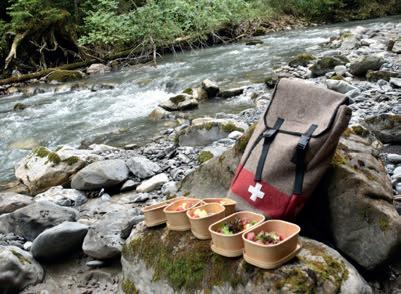
Whisky, wild seas and Russell Sage’s maximalist touch combine to create Ardbeg House, a hotel that celebrates the soul of the ‘Queen of the Hebrides’, says Mary Lussiana




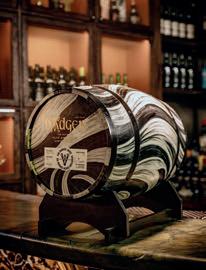

On a sunny day, there are few ner places to be than on the west coast of Scotland – ideally bobbing about in a boat o the Isle of Islay, where seals plop themselves inelegantly on the grey rocks and the breeze comes tinged with peat, smoky bon res and briny Atlantic sea spray.
Visitors to the new Ardbeg House, which swung open its doors in September, can avail themselves of a trip out on the water with Gus from Islay Sea Adventures, who may well share a few scallops from his morning dive with you – raw, sliced and diced, with a dram of Ardbeg whisky to wash them down. e long, low distillery of Ardbeg, whitewashed with distinctive pagoda chimneys where the barley was once malted, was glinting in the distance when I was hauling up lobster pots with Gus last week. Founded in 1815, it went through several closures in the 1980s and 90s before e Glenmorangie Company bought it in 1997 and saved what is now the world’s most highly awarded smoky single malt whisky from extinction. While there, raise a glass of Ardbeg’s golden Homecoming, only available on the island, with its notes of smoky fudge and spicy co ee, in thanks.
So, it made perfect sense that when the Islay Hotel came up for sale, e Glenmorangie Company (itself owned by LVMH) should snap it up to create a dazzling two-step visit to what is often referred to as the Queen of the Hebrides. Having turned to designer Russell Sage before with the refurbishment of Glenmorangie House (whose whisky is as accessible and easy-drinking as Ardbeg’s is complex and cultcentric), the company decided to repeat the successful formula.
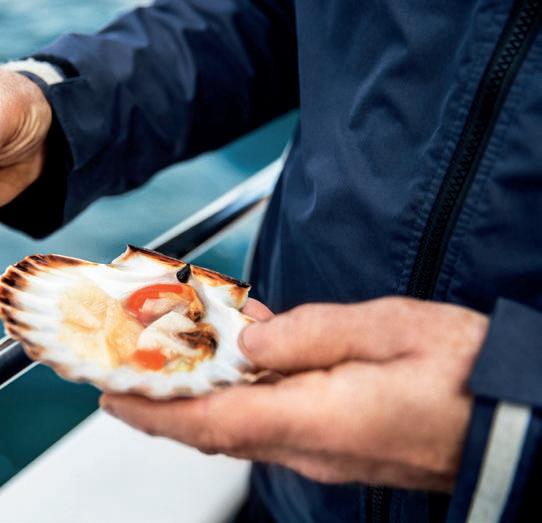
For Sage, who quickly fell in love with the island – ‘there is a magic on Islay that I have never seen anywhere else,’ he told me – and for its locals, it was, he says, ‘the chance to create a house that embodies all that is good on Islay – and a hotel that is not just about whisky tourism’. e 12 rooms have been given a life of their own with names from Wee Beastie (inspired by the legendary original ‘wee beastie’, rym the giant) to Untamed (inspired by the visceral Islay landscape that is ‘larger than your glass’). Climb the stairs past the portraits with speech bubbles and the paintings of Jack Russell terrier Shortie, a much-loved Ardbeg mascot in past times, throw open any door, and the maximalist décor rushes at you. Layers upon layers create the ‘tall stories’ that Russell Sage wanted to reveal. ere are hidden Ardbeg miniatures in Victorian wooden chests, lights criss-crossing the ceiling fashioned from old copper still pipes, disco balls dangling against Fromental wallpapers, collages in Ardbeg tweed by Cairistiona Rose Fletcher, bold geometric patterned carpets by Tessere, wardrobes painted to depict bird plumage – the sensory overload is as extraordinary and absolutely as intense as any of the 56 varieties of Ardbeg whisky behind the bar. e bar itself is a source of great rejoicing on the island, as it was closed some years ago and its rebirth as e Islay Bar with direct access from the street means a much-loved watering hole has returned. Step inside, and rich velvets meet tables shaped like mechanical cogs (a reference to Ardbeg’s spirit of innovation); a custom-designed, boatshaped chandelier is a nod to the sea; and the green marble bar top is inspired by Islay’s grasses, mosses and peatlands. For those keen to explore the Ardbeg whiskies, the best time to come is 18.15. Every night at this time – chosen in honour of Ardbeg’s foundation year – a dram from a special cask (an unrepeatable and secret batch) is poured. Known as Badger (an anagram of Ardbeg) Juice, it is the creation of master blender Gillian Macdonald. But don’t leave without trying a cocktail either – something like the Beastly Bramble (Ardbeg Wee Beastie, lemon, sugar, bramble), which hits just the right note.
A nd when you do visit, head straight for the restaurant. Order the local hand-dived scallops with a sa ron and caviar butter sauce, or the Islay Estate game terrine with fermented gooseberries and local wild garlic. A main course of Islay blackface lamb with young parsnips and a mustard and thyme sauce, or the pan-fried Islay sea trout with a celeriac and pancetta galette, are the dishes to have, while around you, happy faces, a lively buzz and the celebratory feel of a new chapter ll the air.
A welcome – and meaningful – addition to the best hotels in the British Isles, Ardbeg House certainly is. But it is more than that. Russell Sage, with his embracing of Islay’s past, has created a hotel with a spirit (in both senses of the word) that will endure for the future.
BOOK IT: Doubles from £225 B&B, including a complimentary distillery tour. ardbeg.com n

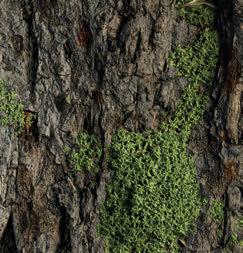
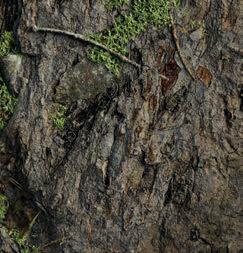
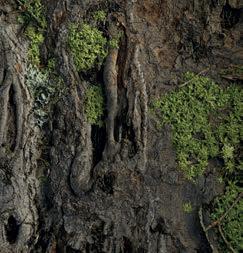




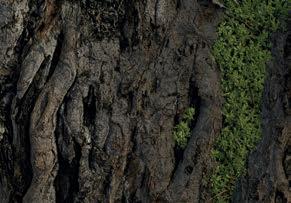
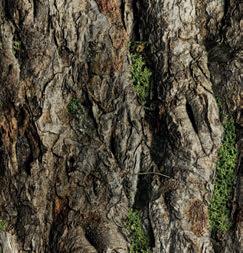

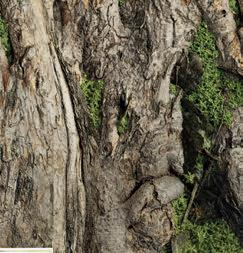
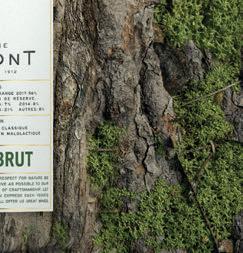





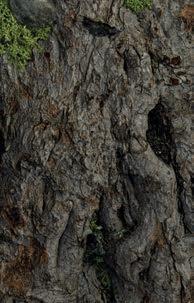








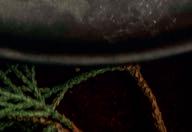
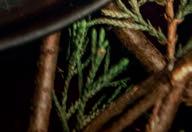




Korean-Japanese restaurant JANG in The Royal Exchange has a refreshingly non-traditional take on Christmas wreathing (jangrestaurant.co.uk). Find our favourites for festive larders and libations overleaf.

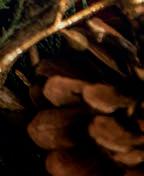
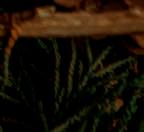
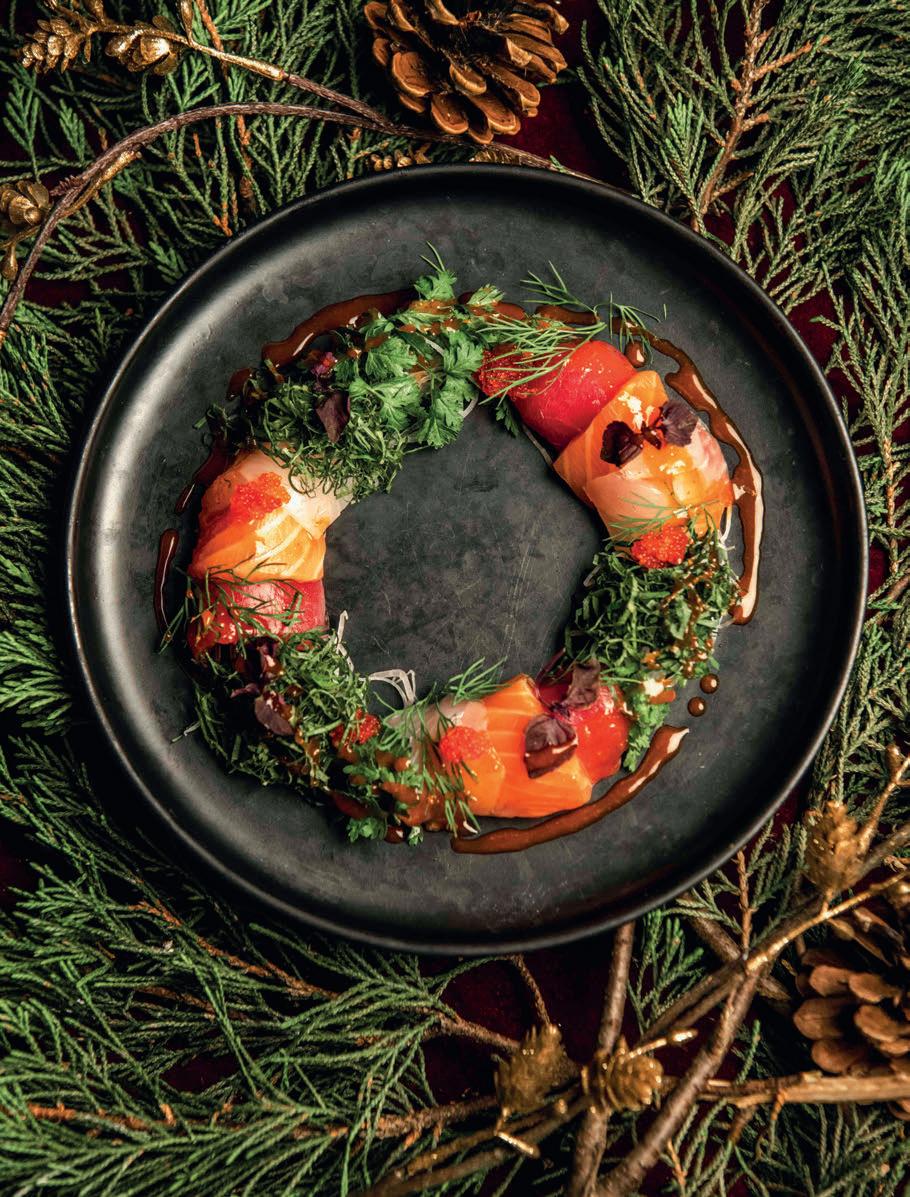
Tessa Dunthorne picks sweets, cheese and pretty placements for your festive table



FIONA CAIRNS Christmas fairy cakes, £7. ocado.com


TRUFFLE BEE Naomi placemat in burgundy, £160 for two. truffle-bee.com

L’OBJET Spiral cocktail knife and fork, each £205 for a set of four. selfridges.com
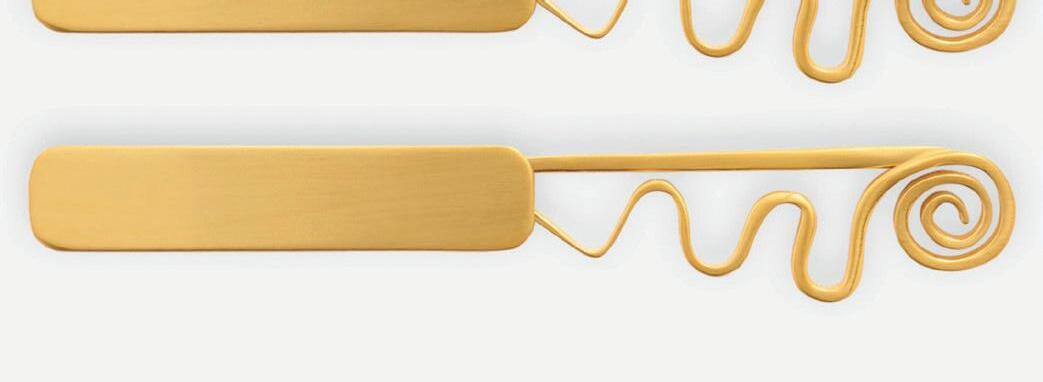



FORTNUM & MASON Sugar Plum Preserve, 200g. £7.95. fortnumand mason.com

Cherry and chocolate panettone, £13.90. eataly.co.uk
LA DURÉE X V&A 16 Macarons gift box, £49. laduree.com DAYLESFORD Organic cheeses, from £5.50. daylesford.com WAITROSE Hazelnut creme panettone, £20. waitrose.com TRACKLEMENTS
Chutney Christmas cracker, £11.40. tracklements.co.uk
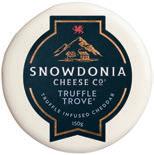
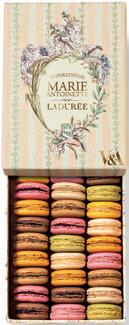
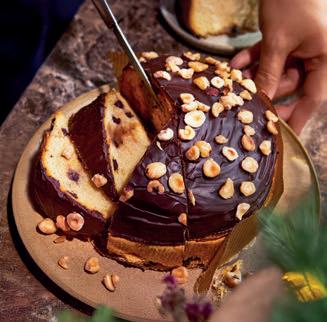

MAISON FLANEUR L’amore fil rouge plate, 21cm. £50.99 per plate. maisonflaneur.com
MONOWARE Candle holders, £75. monoware.com



Madagascan vanilla and miso caramel ice cream, £6. waitrose.com
SNOWDONIA CHEESE COMPANY Truffle Trove cheddar, £4. snowdoniacheese.co.uk

COLOURS OF ARLEY
Reusable fabric napkin cracker, £30. coloursofarley.com

Stock up the cellar, and throw in some no/low for balance, says Tessa Dunthorne
APÉRITIFS TO OPEN WITH




FROM LEFT:
BOTIVO
Used as a mocktail base, Botivo will get you herbally buzzed. £27.50, ocado.com
FENTIMANS
One for the littles – with a smart bottle so they feel like they’re having a grownup drink, too. Dandelion & Burdock fizz, £3.60, sainsburys.co.uk
SILENT POOL GIN
Silent Pool do a smashing base for a G&T, and the classic bottle is super giftable. £44, silentpooldistillers.com
SHOWERINGS
Lagers are rather yesteryear – many are switching their pre-dinner bottle for premium cider. Triple vintage cider, £3.50, waitrose.com




STILLS ARE THE MAIN COURSE




FROM LEFT:
NYETIMBER
Nyetimber’s signature single vintage – from an excellent year. Blanc de Blancs 2017, £58, nyetimber.com
RIDGEVIEW
The late Queen enjoyed East Sussex-born Ridgeview at her 80th birthday and 2012 diamond jubilee. Bloomsbury NV, £34, ridgeview.co.uk
CHAMPAGNE TELMONT
Telmont is the conscious choice with its ambitious targets to be completely organic by 2031. Delicious, to boot. Réserve Brut, £56, uk.champagne-telmont.com
WISTON ESTATE
West Sussex-based Wiston’s chalky slopes make uberdrinkable bubbles. Blanc de Noir 2014, £55, vivnm.com



FROM LEFT:
BIBI GRAETZ
A medium-bodied red from a wine producer who studied art before he studied the vines. Casamatta Rosso 2023, £36, bbr.com
CHATEAU D’ESCLANS
Whispering Angel’s sibling wine is a complex grenache/ rolle blend. Les Clans 2023, £52.99, selfridges.com
BOLLINGER
Bollinger’s OG raison d’etre was its red wines – not the fizz – which it still produces today. La Cote aux Enfants 2016, £224, thefinestbubble.com
CRADLE VALLEY
Move over sparkling; the next phenom is English white wines. Chardonnay 2023, £25, rathfinnyestate.com

BRUICHLADDICH
Bruichladdich’s striking signature bottle (made from 60 percent recycled glass) houses a smooth, trickledistilled single malt from Islay. The Classic Laddie, £46, uk.bruichladdich.com
GLENDRONACH
A 21-year-old single malt by Forgue-based The GlenDronach will stave off post-dinner slumps. Full-bodied, rich and raisiny, without much smoke. £230, thewhiskyexchange.com
THOMAS HINE & CO
This British-founded Cognac company supplies the Royal Household – its 1975 vintage, in a special French porcelain decanter, is a limited edition of only 500. €3,500, hine.com
NO 1 WAITROSE
Nothing beats a pre-mixed cocktail that tastes of high effort. Blonde Chocolate cream liqueur, £11.20, waitrose.com

it
Have you ever thought about telling your life story? As the world’s leading specialists in private memoirs and autobiographies, we help people turn their memories into beautifully written handcrafted books – lasting heirlooms their families will treasure for generations. Now is the time to tell your story – the one only you can share. Find out how – call us on 0845 528 0698 or visit lifebookmemoirs.com

With its pastel palette, art by Luke Edward Hall and menus from Michelin-starred Lisa Goodwin-Allen, Rosi ushers in The Beaumont’s next chapter, says Ellie Smith
Traditionally, London’s hotel restaurants haven’t been viewed as the buzziest spots in town. But a spate of relaunches, makeovers, pop-ups and big-name chefs have heralded a new era for hotel dining in the capital. Leading the charge right now is Rosi, the hotly anticipated newcomer at Mayfair hotel e Beaumont. Opened in 2014 by restaurant juggernauts Chris Corbin and Jeremy King (the duo behind Le Caprice and e Wolseley), e Beaumont has always had a food and drinks focus – with a slant towards Jazz Age glamour. When creating the concept, King conjured up a narrative about ctional hotelier James Beaumont, who escaped prohibition in 1920s Manhattan to open a guesthouse in Mayfair. is clandestine, in-the-know feel pervades throughout the hotel,
which is ttingly hidden away on Brown Hart Gardens, between Grosvenor Square and Selfridges. Known for its killer martinis, Le Magritte bar has the feel of a speakeasy, e Gatsby Room serves afternoon tea, and for years e Beaumont was home to e Colony Grill – a sophisticated diner with art deco interiors.
But recently appointed CEO Stuart Proctor felt it was time for a change, and this year set out to swap the masculine energy of e Colony Grill for something less clubby and more feminine. ‘With the refurbishment of the hotel, followed by the rebrand in November 2024, it was time to refresh, soften and elevate our restaurant to appeal to our hotel guests, as well as local residents,’ he says.
e result is Rosi: a pastel-hued dining room named after Rosemary


‘It was important for us to make the restaurant accessible, fun and playful, moving away from the traditional fine-dining concept’
STUART PROCTOR
Saïd, wife of e Beaumont’s owner Wa c Saïd. Instead of the brown colour palette and moody artworks, the space is now decked out with pink and green banquettes and vibrant murals from Luke Edward Hall, which tell the story of ‘a day in London’ and bring a touch of whimsy to the setting.
But Instagram fodder this is not. Rosi’s food o ering is second-to-none – no surprise when you learn that one of the UK’s top chefs, Lisa GoodwinAllen, is running the kitchen. Goodwin-Allen brings with her a wealth of experience, having spent the past two decades ensuring Lancashire’s top foodie hotel Northcote holds onto its longtime Michelin star.
But now, she’s also bringing her culinary wizardry to Mayfair, having joined e Beaumont as culinary director this spring, working alongside chefs Brendan Fyldes (L’Escargot) and Jozef Rogulski ( e Game Bird at e Sta ord London) at Rosi.
‘I’m thrilled to open the doors to Rosi,’ says Goodwin-Allen, describing it as ‘full of dishes you’ll want to eat, in an atmosphere that feels truly inviting.’ She’s right. On opening night, there’s a buzz in the air – the restaurant feels welcoming and convivial, rather than stu y and formal. is is complemented by the menu, which is centred around elevated takes on British comfort food classics (a change from its predecessor, which had a more transatlantic o ering). ‘It was important for us to make the restaurant accessible, fun and playful, moving away from the traditional ne-dining concept,’ Proctor notes.
Nostalgia runs throughout. First up there are snacks of crispy hash browns and mini chipolata sausages, followed by starters like the generously portioned Old-Fashioned Pork Pie, which is wheeled over on a trolley and sliced in front of your eyes – already on its way to becoming a Rosi signature, according to Goodwin-Allen. Mains, meanwhile, include chicken diane served on a bed of mushrooms (a dish which evolved from the US-born ‘60s favourite steak diane), John Dory sh ngers, and


a twist on the eighteenth century staple, steamed suet pudding. Our highlight, though, was the chicken kyiv, oozing with tru e butter and served with silky-smooth mashed potato.
is retro feel is paired with ve-star touches, like platters of rock oysters, beluga caviar and grass-fed rib-eye. eatre also plays a key part: the steak tartare, for instance, is dished up tableside with your choice of garnishes, while the dessert menu includes ambéed sponge and buildyour-own ice cream sundaes.
ere’s no doubt Rosi will be a hit with hotel guests. But with its chic aesthetic, slick yet relaxed service and faultless food o ering, it feels like this launch will quickly become a destination restaurant in itself.
Starter: Gin-cured melon with serrano ham and pomegranate, £22 Main: Chicken kyiv with tru e butter and mashed potato, £46 Dessert: Black cherry blancmange, £10
thebeaumont.com n
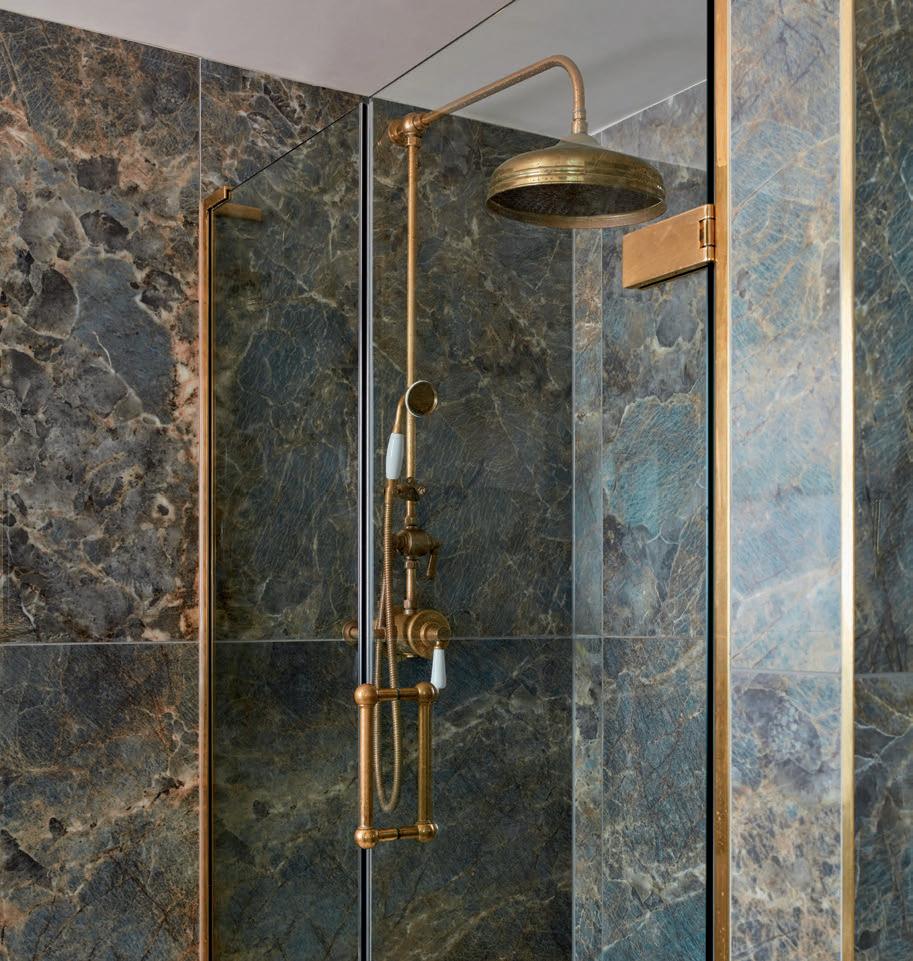

BATHROOMS | TILES | WELLNESS | DESIGN & INSTALLATION
Create the bathroom you’ve always wanted through our premium design service.

100 George Street W1, Marylebone, London
41 contemporary one-bedroom residences, from £1.75m
Sell it to us in a sentence... Perfectly suited for those seeking a refined pied-à-terre in prime central London, these one-bedroom apartments offer an ideal balance of comfort, style and convenience.
How would you describe the design? Developed by Native Land in partnership with Derwent London and The Portman Estate, 100 George Street fits seamlessly into the historic façades of the area. The building, designed by Hopkins Architects, blends Georgian-inspired architecture with craftsmanship to create a quietly sophisticated aesthetic: rich hues, sumptuous materials, an abundance of light and spacious indoor-outdoor entertaining areas.
What’s unique about it? What sets this address apart – beyond its handsome design and coveted location – is its exceptional range of amenities, reminiscent of a five-star boutique hotel. Residents benefit from a dedicated concierge service, 24-hour security and secure underground car parking, along with exclusive access to a residents’ lounge, library, meeting room, fully equipped gym and a private spa.
Perks of the location? This is a peaceful retreat from city bustle but it sits within easy reach of London’s more vibrant destinations, with the charming Marylebone High Street on its doorstep, Mayfair accessible within minutes, and green Royal Parks within strolling distance. The neighbourhood is home to a number of world-famous restaurants including Fischer’s, Nobu Portman Square, Boxcar, Monocle Café and Michelin-starred Café Murano, and iconic British retailers like Daunt Books, The Ginger Pig and Trunk Clothiers. +44 (0)20 7758 7188; 100georgest.com



Which villages pull out all the stops at Christmas? Anna Tyzack hunts down the best trees, traditions and nearby houses for sale
Carols in the church, pints in the pub, a frosty village green – what could feel more Christmassy than a rural village in December? Christmas is a barometer of a village, according to Harry Wilde of Winkworth's Peters eld o ce; if a village does Christmas well, it tends to be a pleasant place to live the rest of the year, with enduring community spirit and local desire to bring people together.
‘ e most coveted villages tend to be those with longstanding traditions,’ Wilde explains, and at Christmas, buyers should look for a busy pub, a well-attended church, wreaths on the doors and key Christmas events: a Boxing Day meet, carols, a market in the village hall.

FOR SALE
A country house with a sweeping drive set in formal gardens. The interiors are in need of updating, but the large drawing room and family kitchen will come into their own at Christmas, as will the five bedrooms. It is set on six acres of land with lapsed planning for stables, too, in case a pony is on the Christmas list. £1.65m, knightfrank.com
is chocolate-box Sussex village near Billingshurst is perfection at Christmas, with a main street lined with immaculate cottages straight out of e Holiday. Its two pubs are both worth leaving home for: e Foresters Arms on the village green, recently reopened and run by a former Arsenal goalkeeper and her partner, is friendly and serves the best sh and chips for miles, while Half Moon is an elegant gastropub owned by former model Jodie Kidd that hosts the local hunt meet on Boxing Day. And what better way to get into the spirit of rural Christmas than with a festive tractor rally? e Farmer Christmas Charity Run is back for a second year in Kirdford, near Billingshurst, on 13 December.



A 62-acre farm peacefully positioned up a long driveway with a character-filled farmhouse, three-bedroom cottage and one-bedroom barn. The main house has airy open plan living spaces, a kitchen with an Aga, a gym and an office; outside are flagged terraces, lawns and a densely populated orchard. £4.995m, blenheim.co.uk
In recent years, this picturesque village at the head of the Hope Valley in the heart of the Peak District has become as known for its Christmas trees as its four show caves – Peak Cavern, Speedwell Cavern, Treak Cli Cavern and Blue John Mine. is year, Castleton hosts its 16th Christmas Tree Festival: from 15 November, Christmas trees decorated by local groups, businesses and caverns will be on display in St Edmund's Church. ere will also be Christmas trees lit up outside most shops, pubs and cafés around the village. Festive visitors can even attend atmospheric underground carol concerts in Peak Cavern and Treak Cli Cavern (6-24 December), accompanied by local brass brands, as well as the Hollowford Christmas Market (6 December), featuring local produce and crafts.
It’s as if time stands still in the honeystone village of Swinbrook, a conservation area in the Cotswolds. ere are fewer than 150 residents, a 12th-century church, and a gentle stream running through the centre.

FOR SALE
No wonder e Swan Inn – a 18th-century coaching inn in the heart of the village that used to be owned by Deborah Mitford (her family lived at Swinbrook House) – draws visitors in search of an archetypal Cotswolds pub lunch, particularly at Christmas when the open re and log burner are both blazing and there’s turkey on the menu. David Cameron famously dined there with Francois Hollande in 2014. While visitors will have to go to Burford, seven minutes away, for Christmas markets and grottos or the Burford Garden Centre – which was recently named the UK's hottest celebrity haunt and sells Christmas trees for up to £3,000 – Swinbrook o ers twinkling lights and carols in St Mary's Church (21 December).
A four-bedroom, Grade II-listed, Tudor-style house with period features including lattice windows and open fireplaces reimagined for modern living. The gardens have been cleverly landscaped with formal and informal areas, and a summer house has been converted into a one-bedroom garden cottage. £2.85m, knightfrank.com
On Boxing Day, locals walk across the elds for carols at the church in neighbouring Widford.
A Grade II-listed cottage in Linton with uninterrupted views of the Yorkshire Dales from its mullion windows. There’s a cosy sitting room with an inglenook, an eat-in kitchen, three bedrooms and a south-facing garden and orchard. £595,000, wilman-lodge.co.uk
e small town of Grassington –Darrowby in the TV adaptation of James Herriot’s All Creatures Great and Small – feels like a village, with its cobbled market square and independent boutiques and art galleries that come alive at Christmas. ere is a ceremonial switching on of the Christmas lights on 21 November, and bustling craft and produce markets on 29 November and 6 December. Stay a short walk away across the River Wharfe at e Fountaine Inn, on the green in the village of Linton. e pub has a roaring re, hand-pulled beers and a number of cosy bedrooms. From here, visitors can walk the Dales Way, or to Linton Falls to see the weir that powered one of the rst public electricity supplies in England.
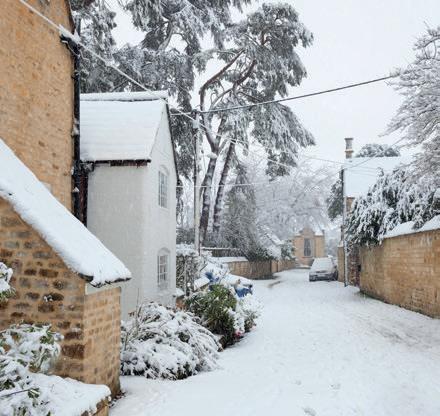
FOR SALE
A handsome Grade II-listed farmhouse with high ceilings and large sash windows. The vaulted breakfast room/kitchen is perfect for a family Christmas lunch; afterwards, open presents in the drawing room. There are six bedrooms and a cottage, plus an outdoor pool amid landscaped gardens. £1.7m, winkworth.co.uk
ere are two sides to this rural village on a chalk spur of the South Downs near Peters eld: Catherington Down –great for sledging – and Catherington Lith. Between them is e Farmer Inn, which is where festive celebrations kick o on 25 November with a Christmas market. Such is local enthusiasm for Christmas that residents have erected a village Christmas tree: on 15 December, there will be carol singing around it led by e Salvation Army.

Ivy House on the high street was owned by George Hart, who ran the Guild of Handicraft's Chipping Campden workshop after it was co-founded by Charles Ashbee and William Morris during the flourishing Arts and Crafts movement in the early 20th century. The house is remarkably unspoilt, with elegant panelling, a drawing room with ornate coving and a marble fireplace, and flagstone floors and detailed panelling in the dining room. The kitchen is centred around a four-oven Aga beneath a stone lintel; there is a separate scullery, and there are six bedrooms upstairs. £2.75m, savills.com
On the rst Saturday in December, the medieval wool town of Chipping Campden in the northern Cotswolds is transformed into a festive wonderland for its much-loved Christmas market. Along with outdoor stalls selling mulled wine, cards, toys and seasonal delicacies, the town hall hosts a cosy indoor market selling decorations and festive treasures. e town, which is arguably the most unspoilt of Cotswolds market towns, is famous for its links to the Arts and Crafts movement and has a ne selection of pubs and restaurants, and two award-winning delis. Stay at Campden Barn, a retreat moments from town that sleeps up to eight ( from £450, westaygroup.com).

A three-bedroom, semi-detached Victorian house sitting on the hillside above Mousehole harbour. No1 Coronation Villas has magnificent views of St Clement's Island and Mount's Bay, with St Clement's Isle, Praa Sands and the Lizard clearly visible on a sunny day. £750,000, savills.co.uk
Few villages light up at Christmas as much as Mousehole near Penzance. It was the artist Joan Gillchrest who rst proposed lighting up the harbour in 1963, a plan that has evolved into an annual display involving the entire village and a dedicated committee. is year’s switch-on is on 11 December, with an estimated 7,000 bulbs in nautical, festive and animal shapes (there’s a cat that returns each year, and a sea monster) strung along the harbour walls, on boats and in the narrow streets and alleys –although they are dimmed on 19 December to commemorate the anniversary of the Penlee Lifeboat Disaster. On 23 December the village celebrates Tom Bawcock’s Eve, eating sh stargazey pie (with pilchard heads and tails poking through the crust) to honour a local sherman who saved locals from starving during a storm by landing an enormous catch. Mulled wine and apple cider is on o er at local cafés and pubs throughout December – although you’ll still need to wrap up for the Cornish coastal weather.






Hayman takes lessons in the art of confidence from Anya Hindmarch


At Cadogan Hall, the Royal Philharmonic Orchestra is deep in rehearsal of Sibelius. As the music swells, Anya Hindmarch leans over and tells me her dream: to lie on the oor in front of a full orchestra and feel the sound roll over her. I can see why. ere’s something incredibly involving about live orchestral music at this scale: the precision, the poise, the unspoken con dence of people utterly in tune with what they do. at sense of performance – and presence – runs through Hindmarch’s life. From her rst foray into fashion in Florence aged 18, to building one of Britain’s most distinctive design voices, she’s made a career out of creative conviction. Her work has travelled the world – one of her handbags was even chosen as the o cial UK state gift to Melania Trump during the Trump visit earlier this year.
She’s quick to wave away the politics of it, but Hindmarch makes a subtle point. If soft power is as much a feeling as a fact, then fashion is far more than ‘lovely gifting’. It’s the projection of national feeling –con dence, curiosity and craft, stitched into something
‘Everyone feels self-doubt –even the most confident people. The trick is to make peace with it: to let doubt push you, not paralyse you.’
you can hold. In a year when the country seems to be searching for its sense of self again, it’s a timely reminder that how we feel can be as de ning as what we do. at focus on feeling is what anchors Hindmarch’s view of con dence. ‘Everyone feels self-doubt,’ she tells me. ‘Even the most con dent people. e trick is to make peace with it: to let doubt push you, not paralyse you.’ It’s the theme of her book, When in Doubt, Wash Your Hair – part manifesto, part manual for nding calm amid the noise.
Her take on fashion has the same grounded optimism. ‘It shouldn’t be about showing o ,’ she says. ‘It’s about joy, about how something makes you feel.’ Perhaps that’s why her brand has endured – it’s witty, but never cynical; con dent, but not loud.
As the orchestra reaches its nal notes, Hindmarch looks out across the stage. ‘We’re brilliant at mixing the old and the new,’ she says. ‘It’s in our DNA. History with a wink.’ For her, London remains the ultimate creative city: diverse, daring and impossible to pin down.
And as years turn and resolutions loom, her parting thought lingers: ‘It’s not about never doubting yourself. It’s about staying curious, staying kind – and if all else fails, wash your hair and start again.’
ANYA’S THREE LESSONS IN CONFIDENCE
1
Doubt is a superpower. It keeps you questioning and improving.
2
Confidence is curiosity, not certainty.
3
When in doubt, start again – ideally with clean hair!





















































































